Financial Analysis of Delhi Metro: NPV, PI, and IRR
VerifiedAdded on 2023/06/07
|42
|6440
|70
AI Summary
This study examines the financial analysis of Delhi Metro, including the calculation of NPV, PI, and IRR. It also explores the reasons contributing to the increase in ridership and the different profiles of commuters. The study uses factor analysis to determine the important factors of preference towards Delhi Metro. The research objectives, hypothesis, sample and data collection methods, and techniques of capital budgeting are also discussed.
Contribute Materials
Your contribution can guide someone’s learning journey. Share your
documents today.
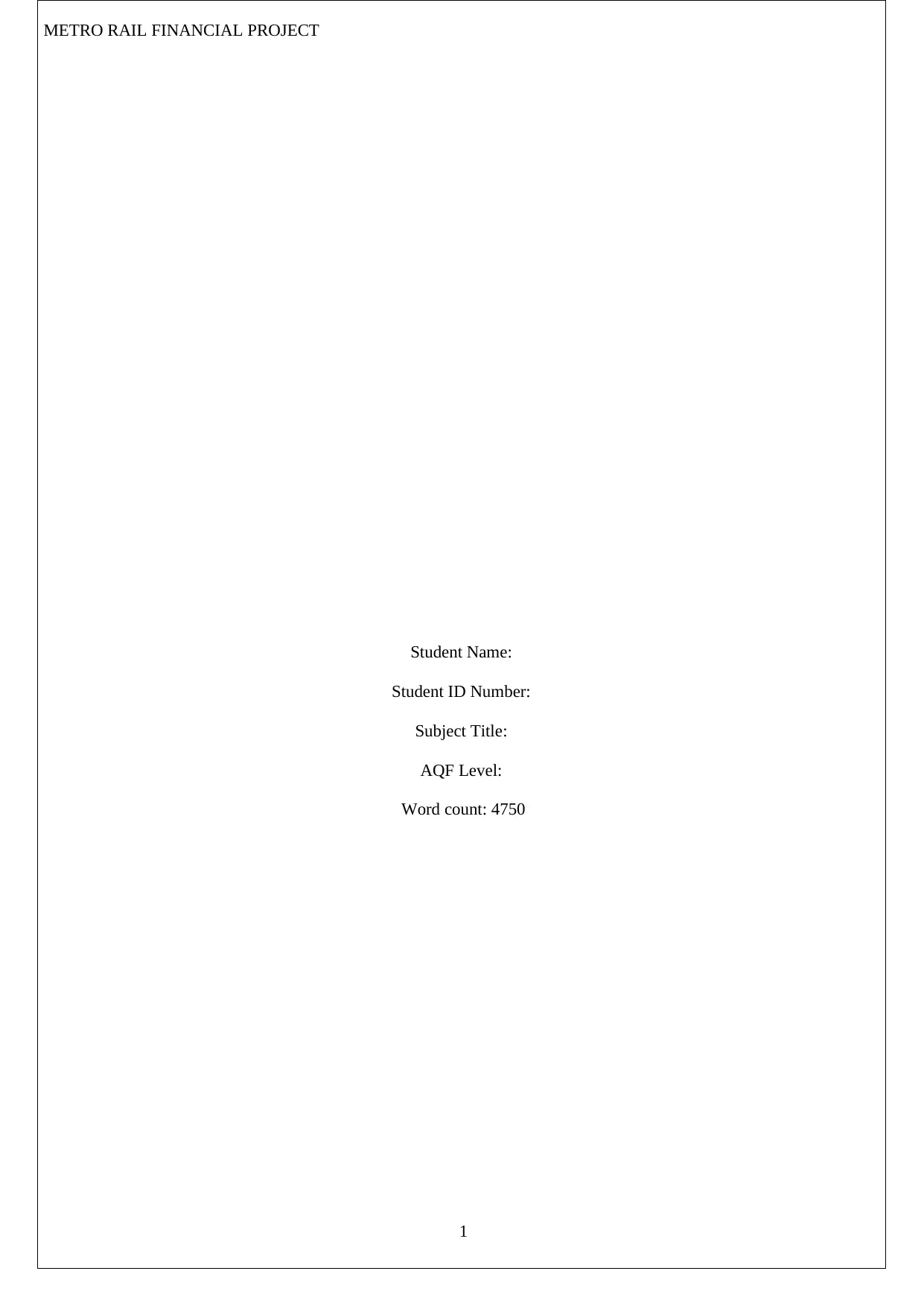
METRO RAIL FINANCIAL PROJECT
Student Name:
Student ID Number:
Subject Title:
AQF Level:
Word count: 4750
1
Student Name:
Student ID Number:
Subject Title:
AQF Level:
Word count: 4750
1
Secure Best Marks with AI Grader
Need help grading? Try our AI Grader for instant feedback on your assignments.
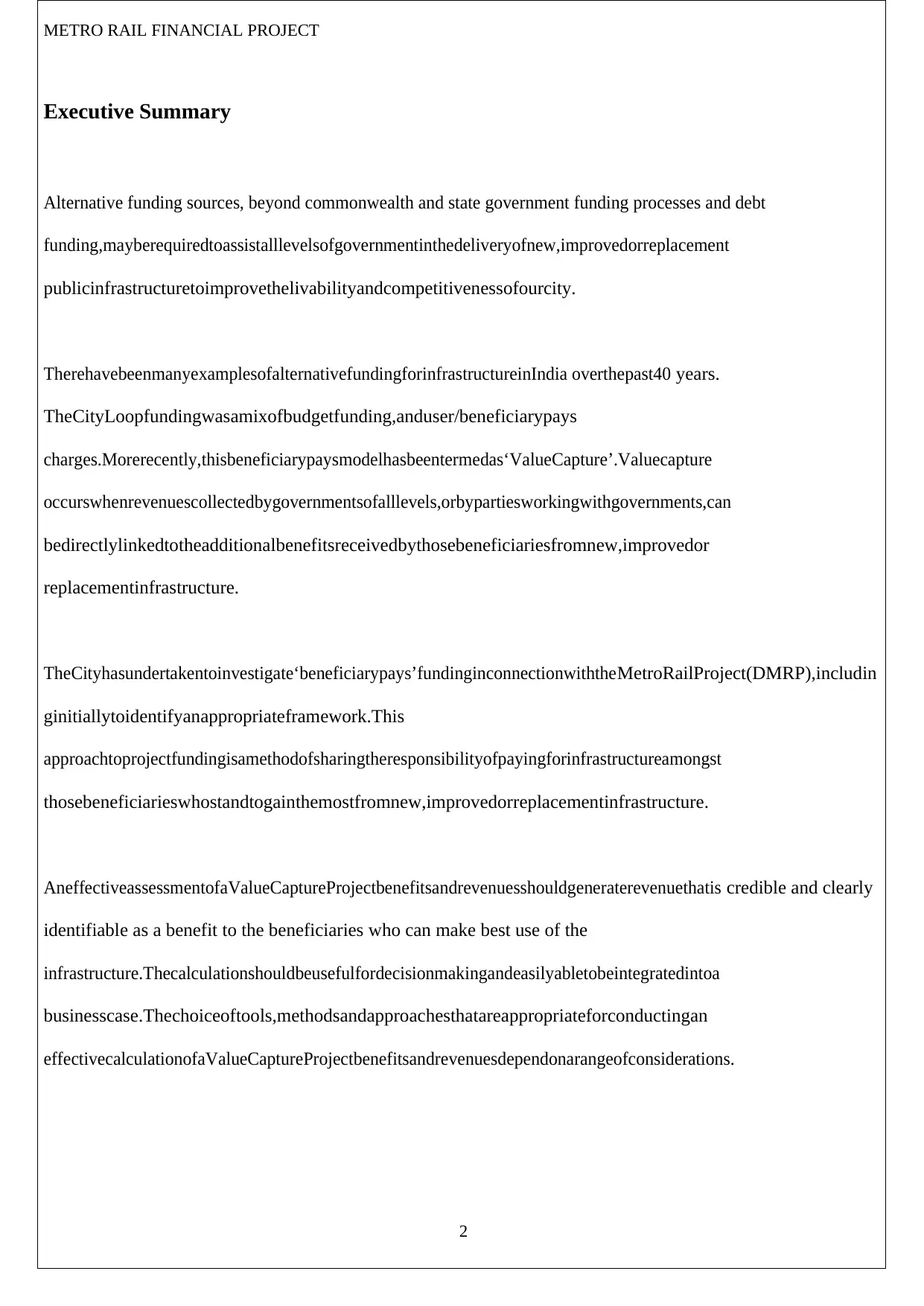
METRO RAIL FINANCIAL PROJECT
Executive Summary
Alternative funding sources, beyond commonwealth and state government funding processes and debt
funding,mayberequiredtoassistalllevelsofgovernmentinthedeliveryofnew,improvedorreplacement
publicinfrastructuretoimprovethelivabilityandcompetitivenessofourcity.
TherehavebeenmanyexamplesofalternativefundingforinfrastructureinIndia overthepast40 years.
TheCityLoopfundingwasamixofbudgetfunding,anduser/beneficiarypays
charges.Morerecently,thisbeneficiarypaysmodelhasbeentermedas‘ValueCapture’.Valuecapture
occurswhenrevenuescollectedbygovernmentsofalllevels,orbypartiesworkingwithgovernments,can
bedirectlylinkedtotheadditionalbenefitsreceivedbythosebeneficiariesfromnew,improvedor
replacementinfrastructure.
TheCityhasundertakentoinvestigate‘beneficiarypays’fundinginconnectionwiththeMetroRailProject(DMRP),includin
ginitiallytoidentifyanappropriateframework.This
approachtoprojectfundingisamethodofsharingtheresponsibilityofpayingforinfrastructureamongst
thosebeneficiarieswhostandtogainthemostfromnew,improvedorreplacementinfrastructure.
AneffectiveassessmentofaValueCaptureProjectbenefitsandrevenuesshouldgeneraterevenuethatis credible and clearly
identifiable as a benefit to the beneficiaries who can make best use of the
infrastructure.Thecalculationshouldbeusefulfordecisionmakingandeasilyabletobeintegratedintoa
businesscase.Thechoiceoftools,methodsandapproachesthatareappropriateforconductingan
effectivecalculationofaValueCaptureProjectbenefitsandrevenuesdependonarangeofconsiderations.
2
Executive Summary
Alternative funding sources, beyond commonwealth and state government funding processes and debt
funding,mayberequiredtoassistalllevelsofgovernmentinthedeliveryofnew,improvedorreplacement
publicinfrastructuretoimprovethelivabilityandcompetitivenessofourcity.
TherehavebeenmanyexamplesofalternativefundingforinfrastructureinIndia overthepast40 years.
TheCityLoopfundingwasamixofbudgetfunding,anduser/beneficiarypays
charges.Morerecently,thisbeneficiarypaysmodelhasbeentermedas‘ValueCapture’.Valuecapture
occurswhenrevenuescollectedbygovernmentsofalllevels,orbypartiesworkingwithgovernments,can
bedirectlylinkedtotheadditionalbenefitsreceivedbythosebeneficiariesfromnew,improvedor
replacementinfrastructure.
TheCityhasundertakentoinvestigate‘beneficiarypays’fundinginconnectionwiththeMetroRailProject(DMRP),includin
ginitiallytoidentifyanappropriateframework.This
approachtoprojectfundingisamethodofsharingtheresponsibilityofpayingforinfrastructureamongst
thosebeneficiarieswhostandtogainthemostfromnew,improvedorreplacementinfrastructure.
AneffectiveassessmentofaValueCaptureProjectbenefitsandrevenuesshouldgeneraterevenuethatis credible and clearly
identifiable as a benefit to the beneficiaries who can make best use of the
infrastructure.Thecalculationshouldbeusefulfordecisionmakingandeasilyabletobeintegratedintoa
businesscase.Thechoiceoftools,methodsandapproachesthatareappropriateforconductingan
effectivecalculationofaValueCaptureProjectbenefitsandrevenuesdependonarangeofconsiderations.
2
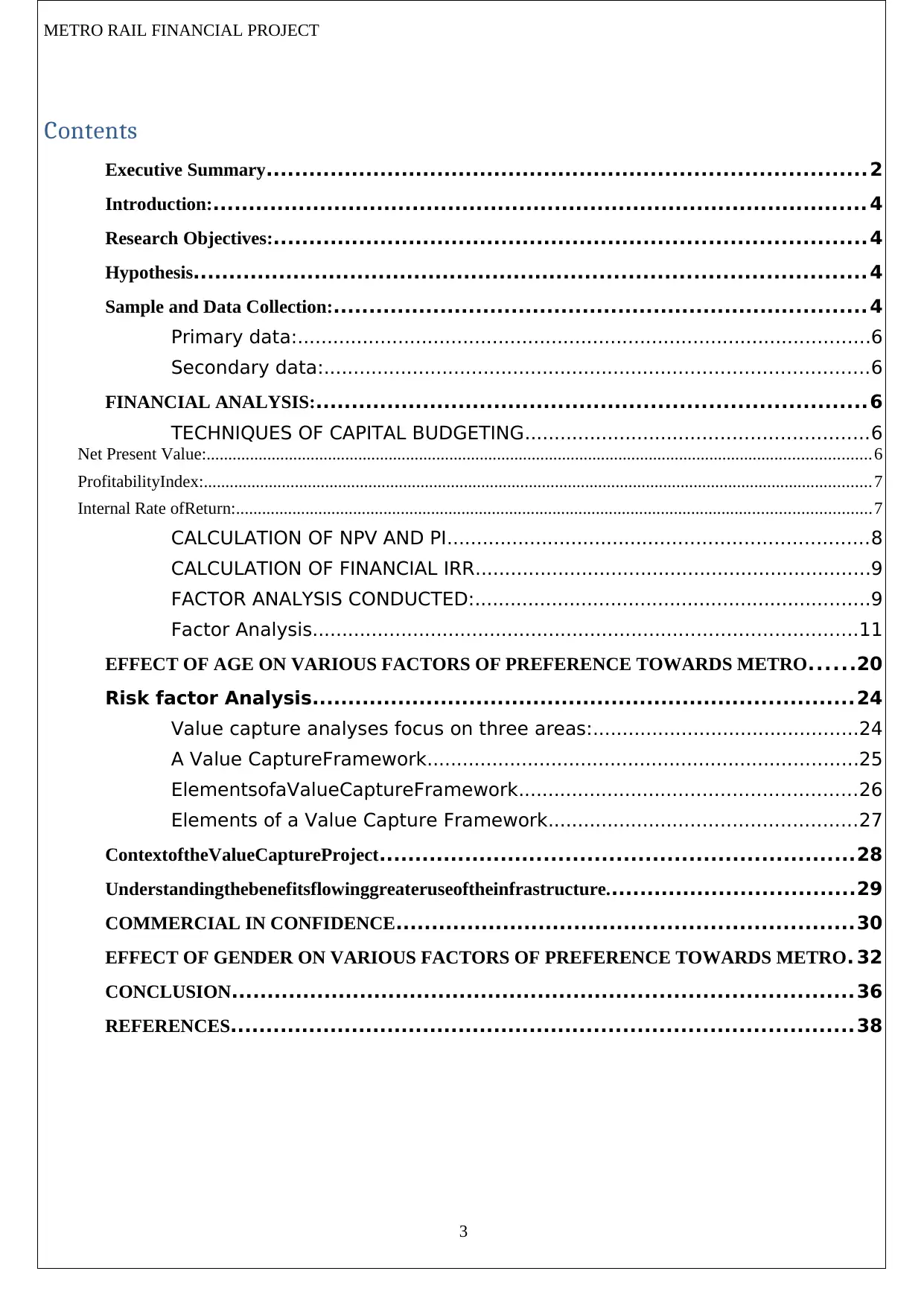
METRO RAIL FINANCIAL PROJECT
Contents
Executive Summary.................................................................................... 2
Introduction:............................................................................................ 4
Research Objectives:................................................................................... 4
Hypothesis.............................................................................................. 4
Sample and Data Collection:........................................................................... 4
Primary data:.................................................................................................6
Secondary data:............................................................................................6
FINANCIAL ANALYSIS:.............................................................................6
TECHNIQUES OF CAPITAL BUDGETING..........................................................6
Net Present Value:.........................................................................................................................................................6
ProfitabilityIndex:..........................................................................................................................................................7
Internal Rate ofReturn:..................................................................................................................................................7
CALCULATION OF NPV AND PI.......................................................................8
CALCULATION OF FINANCIAL IRR...................................................................9
FACTOR ANALYSIS CONDUCTED:...................................................................9
Factor Analysis............................................................................................11
EFFECT OF AGE ON VARIOUS FACTORS OF PREFERENCE TOWARDS METRO......20
Risk factor Analysis............................................................................24
Value capture analyses focus on three areas:.............................................24
A Value CaptureFramework.........................................................................25
ElementsofaValueCaptureFramework.........................................................26
Elements of a Value Capture Framework....................................................27
ContextoftheValueCaptureProject..................................................................28
Understandingthebenefitsflowinggreateruseoftheinfrastructure...................................29
COMMERCIAL IN CONFIDENCE................................................................30
EFFECT OF GENDER ON VARIOUS FACTORS OF PREFERENCE TOWARDS METRO. 32
CONCLUSION.......................................................................................36
REFERENCES....................................................................................... 38
3
Contents
Executive Summary.................................................................................... 2
Introduction:............................................................................................ 4
Research Objectives:................................................................................... 4
Hypothesis.............................................................................................. 4
Sample and Data Collection:........................................................................... 4
Primary data:.................................................................................................6
Secondary data:............................................................................................6
FINANCIAL ANALYSIS:.............................................................................6
TECHNIQUES OF CAPITAL BUDGETING..........................................................6
Net Present Value:.........................................................................................................................................................6
ProfitabilityIndex:..........................................................................................................................................................7
Internal Rate ofReturn:..................................................................................................................................................7
CALCULATION OF NPV AND PI.......................................................................8
CALCULATION OF FINANCIAL IRR...................................................................9
FACTOR ANALYSIS CONDUCTED:...................................................................9
Factor Analysis............................................................................................11
EFFECT OF AGE ON VARIOUS FACTORS OF PREFERENCE TOWARDS METRO......20
Risk factor Analysis............................................................................24
Value capture analyses focus on three areas:.............................................24
A Value CaptureFramework.........................................................................25
ElementsofaValueCaptureFramework.........................................................26
Elements of a Value Capture Framework....................................................27
ContextoftheValueCaptureProject..................................................................28
Understandingthebenefitsflowinggreateruseoftheinfrastructure...................................29
COMMERCIAL IN CONFIDENCE................................................................30
EFFECT OF GENDER ON VARIOUS FACTORS OF PREFERENCE TOWARDS METRO. 32
CONCLUSION.......................................................................................36
REFERENCES....................................................................................... 38
3
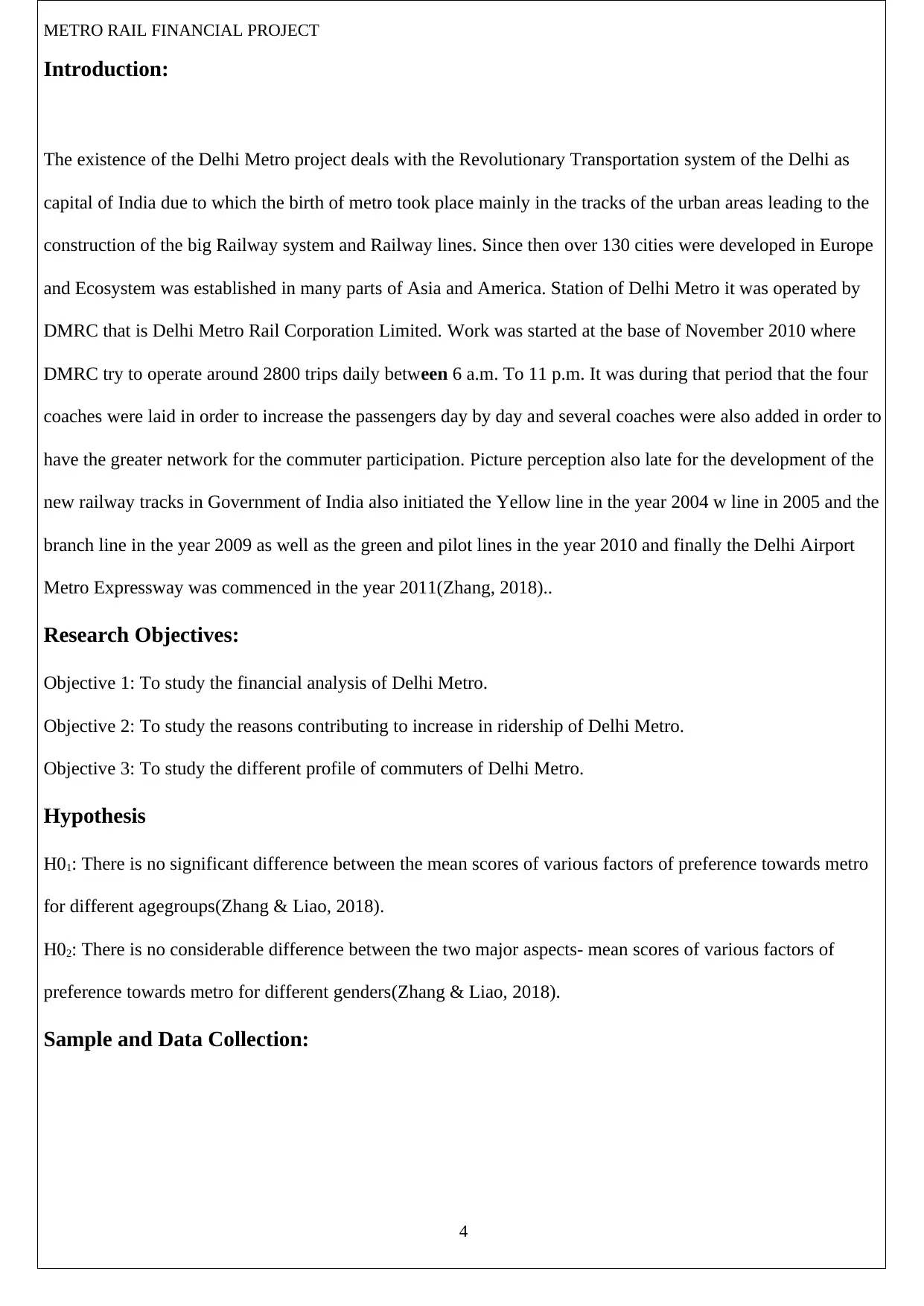
METRO RAIL FINANCIAL PROJECT
Introduction:
The existence of the Delhi Metro project deals with the Revolutionary Transportation system of the Delhi as
capital of India due to which the birth of metro took place mainly in the tracks of the urban areas leading to the
construction of the big Railway system and Railway lines. Since then over 130 cities were developed in Europe
and Ecosystem was established in many parts of Asia and America. Station of Delhi Metro it was operated by
DMRC that is Delhi Metro Rail Corporation Limited. Work was started at the base of November 2010 where
DMRC try to operate around 2800 trips daily between 6 a.m. To 11 p.m. It was during that period that the four
coaches were laid in order to increase the passengers day by day and several coaches were also added in order to
have the greater network for the commuter participation. Picture perception also late for the development of the
new railway tracks in Government of India also initiated the Yellow line in the year 2004 w line in 2005 and the
branch line in the year 2009 as well as the green and pilot lines in the year 2010 and finally the Delhi Airport
Metro Expressway was commenced in the year 2011(Zhang, 2018)..
Research Objectives:
Objective 1: To study the financial analysis of Delhi Metro.
Objective 2: To study the reasons contributing to increase in ridership of Delhi Metro.
Objective 3: To study the different profile of commuters of Delhi Metro.
Hypothesis
H01: There is no significant difference between the mean scores of various factors of preference towards metro
for different agegroups(Zhang & Liao, 2018).
H02: There is no considerable difference between the two major aspects- mean scores of various factors of
preference towards metro for different genders(Zhang & Liao, 2018).
Sample and Data Collection:
4
Introduction:
The existence of the Delhi Metro project deals with the Revolutionary Transportation system of the Delhi as
capital of India due to which the birth of metro took place mainly in the tracks of the urban areas leading to the
construction of the big Railway system and Railway lines. Since then over 130 cities were developed in Europe
and Ecosystem was established in many parts of Asia and America. Station of Delhi Metro it was operated by
DMRC that is Delhi Metro Rail Corporation Limited. Work was started at the base of November 2010 where
DMRC try to operate around 2800 trips daily between 6 a.m. To 11 p.m. It was during that period that the four
coaches were laid in order to increase the passengers day by day and several coaches were also added in order to
have the greater network for the commuter participation. Picture perception also late for the development of the
new railway tracks in Government of India also initiated the Yellow line in the year 2004 w line in 2005 and the
branch line in the year 2009 as well as the green and pilot lines in the year 2010 and finally the Delhi Airport
Metro Expressway was commenced in the year 2011(Zhang, 2018)..
Research Objectives:
Objective 1: To study the financial analysis of Delhi Metro.
Objective 2: To study the reasons contributing to increase in ridership of Delhi Metro.
Objective 3: To study the different profile of commuters of Delhi Metro.
Hypothesis
H01: There is no significant difference between the mean scores of various factors of preference towards metro
for different agegroups(Zhang & Liao, 2018).
H02: There is no considerable difference between the two major aspects- mean scores of various factors of
preference towards metro for different genders(Zhang & Liao, 2018).
Sample and Data Collection:
4
Secure Best Marks with AI Grader
Need help grading? Try our AI Grader for instant feedback on your assignments.
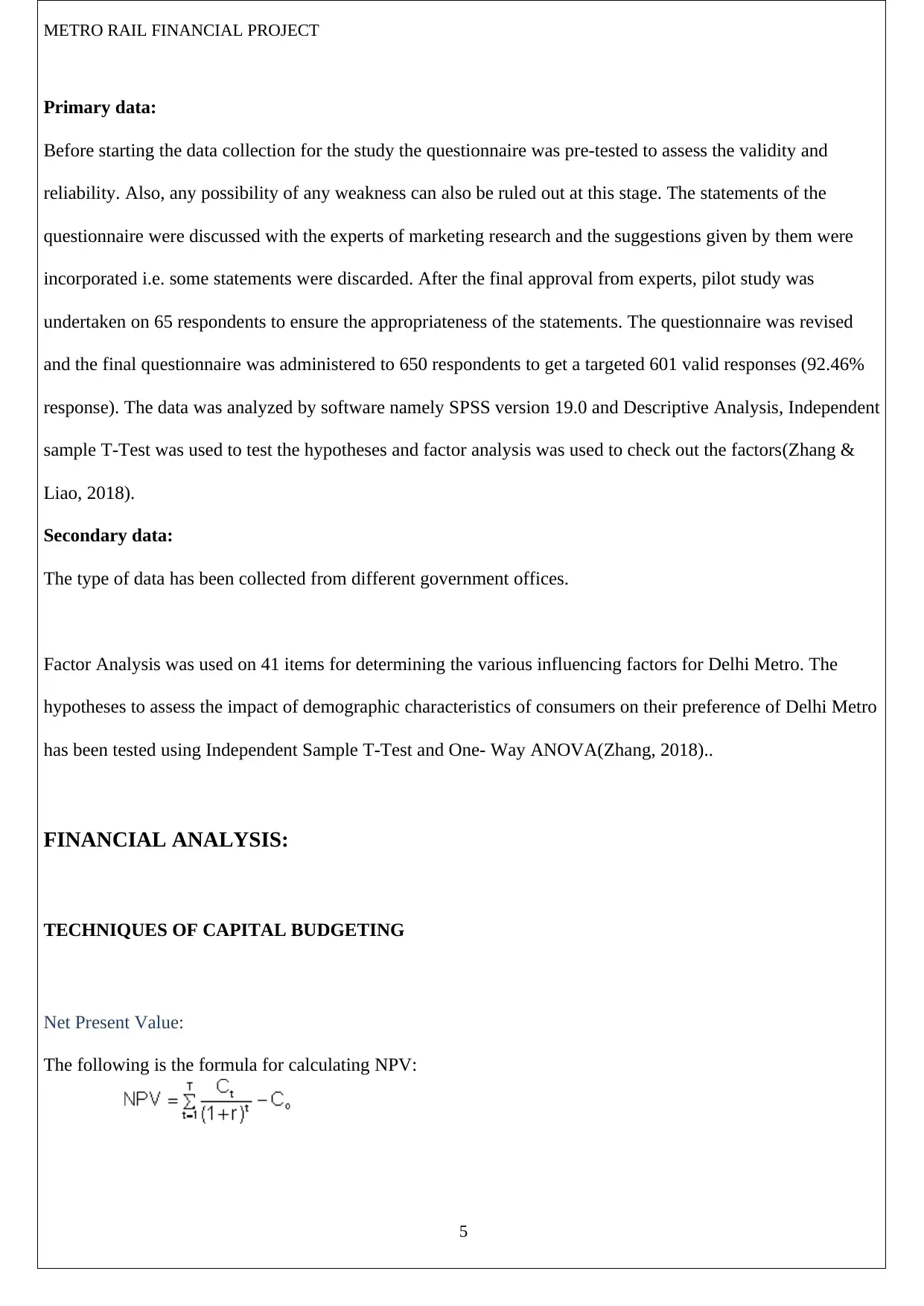
METRO RAIL FINANCIAL PROJECT
Primary data:
Before starting the data collection for the study the questionnaire was pre-tested to assess the validity and
reliability. Also, any possibility of any weakness can also be ruled out at this stage. The statements of the
questionnaire were discussed with the experts of marketing research and the suggestions given by them were
incorporated i.e. some statements were discarded. After the final approval from experts, pilot study was
undertaken on 65 respondents to ensure the appropriateness of the statements. The questionnaire was revised
and the final questionnaire was administered to 650 respondents to get a targeted 601 valid responses (92.46%
response). The data was analyzed by software namely SPSS version 19.0 and Descriptive Analysis, Independent
sample T-Test was used to test the hypotheses and factor analysis was used to check out the factors(Zhang &
Liao, 2018).
Secondary data:
The type of data has been collected from different government offices.
Factor Analysis was used on 41 items for determining the various influencing factors for Delhi Metro. The
hypotheses to assess the impact of demographic characteristics of consumers on their preference of Delhi Metro
has been tested using Independent Sample T-Test and One- Way ANOVA(Zhang, 2018)..
FINANCIAL ANALYSIS:
TECHNIQUES OF CAPITAL BUDGETING
Net Present Value:
The following is the formula for calculating NPV:
5
Primary data:
Before starting the data collection for the study the questionnaire was pre-tested to assess the validity and
reliability. Also, any possibility of any weakness can also be ruled out at this stage. The statements of the
questionnaire were discussed with the experts of marketing research and the suggestions given by them were
incorporated i.e. some statements were discarded. After the final approval from experts, pilot study was
undertaken on 65 respondents to ensure the appropriateness of the statements. The questionnaire was revised
and the final questionnaire was administered to 650 respondents to get a targeted 601 valid responses (92.46%
response). The data was analyzed by software namely SPSS version 19.0 and Descriptive Analysis, Independent
sample T-Test was used to test the hypotheses and factor analysis was used to check out the factors(Zhang &
Liao, 2018).
Secondary data:
The type of data has been collected from different government offices.
Factor Analysis was used on 41 items for determining the various influencing factors for Delhi Metro. The
hypotheses to assess the impact of demographic characteristics of consumers on their preference of Delhi Metro
has been tested using Independent Sample T-Test and One- Way ANOVA(Zhang, 2018)..
FINANCIAL ANALYSIS:
TECHNIQUES OF CAPITAL BUDGETING
Net Present Value:
The following is the formula for calculating NPV:
5
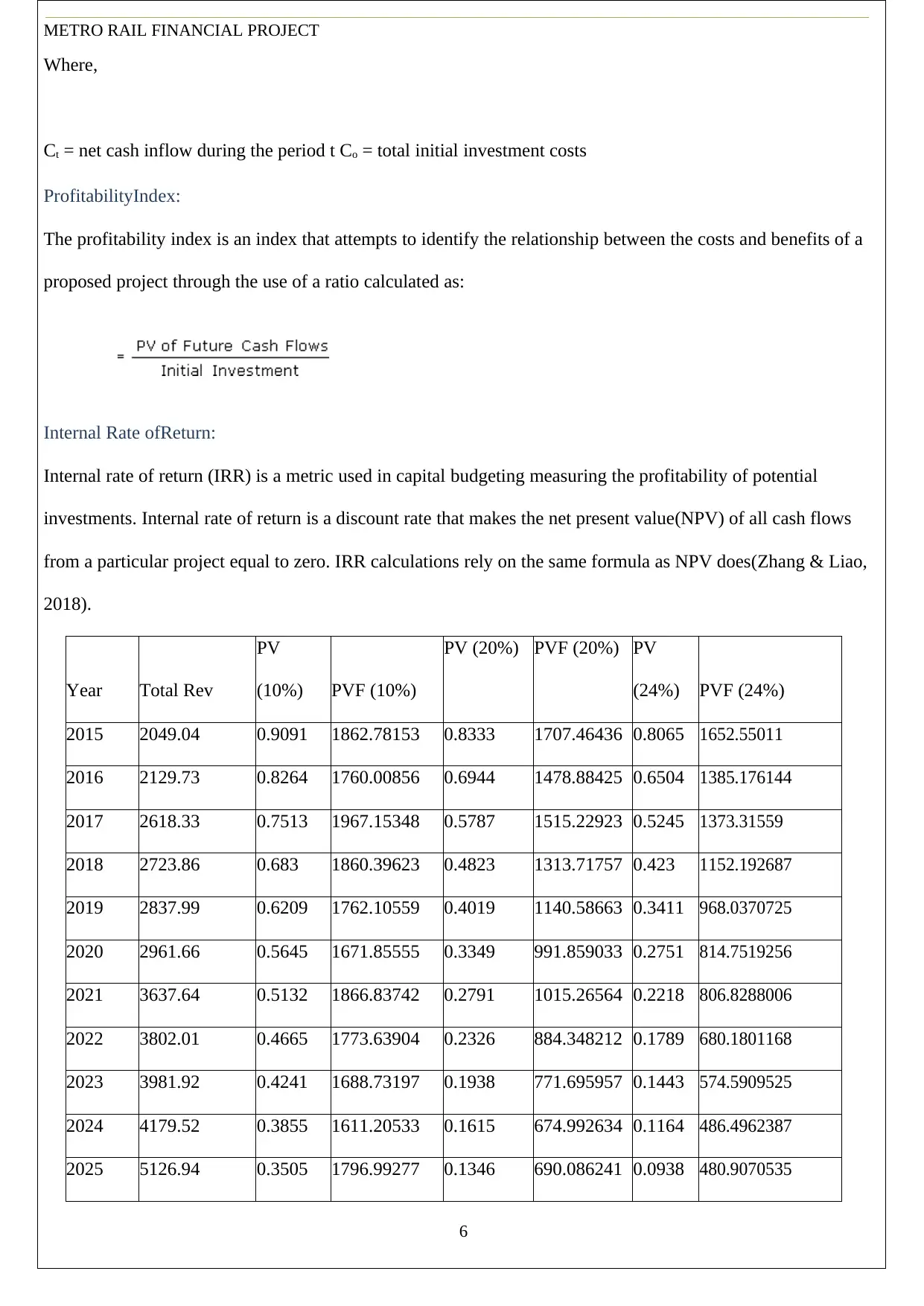
METRO RAIL FINANCIAL PROJECT
Where,
Ct = net cash inflow during the period t Co = total initial investment costs
ProfitabilityIndex:
The profitability index is an index that attempts to identify the relationship between the costs and benefits of a
proposed project through the use of a ratio calculated as:
Internal Rate ofReturn:
Internal rate of return (IRR) is a metric used in capital budgeting measuring the profitability of potential
investments. Internal rate of return is a discount rate that makes the net present value(NPV) of all cash flows
from a particular project equal to zero. IRR calculations rely on the same formula as NPV does(Zhang & Liao,
2018).
Year Total Rev
PV
(10%) PVF (10%)
PV (20%) PVF (20%) PV
(24%) PVF (24%)
2015 2049.04 0.9091 1862.78153 0.8333 1707.46436 0.8065 1652.55011
2016 2129.73 0.8264 1760.00856 0.6944 1478.88425 0.6504 1385.176144
2017 2618.33 0.7513 1967.15348 0.5787 1515.22923 0.5245 1373.31559
2018 2723.86 0.683 1860.39623 0.4823 1313.71757 0.423 1152.192687
2019 2837.99 0.6209 1762.10559 0.4019 1140.58663 0.3411 968.0370725
2020 2961.66 0.5645 1671.85555 0.3349 991.859033 0.2751 814.7519256
2021 3637.64 0.5132 1866.83742 0.2791 1015.26564 0.2218 806.8288006
2022 3802.01 0.4665 1773.63904 0.2326 884.348212 0.1789 680.1801168
2023 3981.92 0.4241 1688.73197 0.1938 771.695957 0.1443 574.5909525
2024 4179.52 0.3855 1611.20533 0.1615 674.992634 0.1164 486.4962387
2025 5126.94 0.3505 1796.99277 0.1346 690.086241 0.0938 480.9070535
6
Where,
Ct = net cash inflow during the period t Co = total initial investment costs
ProfitabilityIndex:
The profitability index is an index that attempts to identify the relationship between the costs and benefits of a
proposed project through the use of a ratio calculated as:
Internal Rate ofReturn:
Internal rate of return (IRR) is a metric used in capital budgeting measuring the profitability of potential
investments. Internal rate of return is a discount rate that makes the net present value(NPV) of all cash flows
from a particular project equal to zero. IRR calculations rely on the same formula as NPV does(Zhang & Liao,
2018).
Year Total Rev
PV
(10%) PVF (10%)
PV (20%) PVF (20%) PV
(24%) PVF (24%)
2015 2049.04 0.9091 1862.78153 0.8333 1707.46436 0.8065 1652.55011
2016 2129.73 0.8264 1760.00856 0.6944 1478.88425 0.6504 1385.176144
2017 2618.33 0.7513 1967.15348 0.5787 1515.22923 0.5245 1373.31559
2018 2723.86 0.683 1860.39623 0.4823 1313.71757 0.423 1152.192687
2019 2837.99 0.6209 1762.10559 0.4019 1140.58663 0.3411 968.0370725
2020 2961.66 0.5645 1671.85555 0.3349 991.859033 0.2751 814.7519256
2021 3637.64 0.5132 1866.83742 0.2791 1015.26564 0.2218 806.8288006
2022 3802.01 0.4665 1773.63904 0.2326 884.348212 0.1789 680.1801168
2023 3981.92 0.4241 1688.73197 0.1938 771.695957 0.1443 574.5909525
2024 4179.52 0.3855 1611.20533 0.1615 674.992634 0.1164 486.4962387
2025 5126.94 0.3505 1796.99277 0.1346 690.086241 0.0938 480.9070535
6
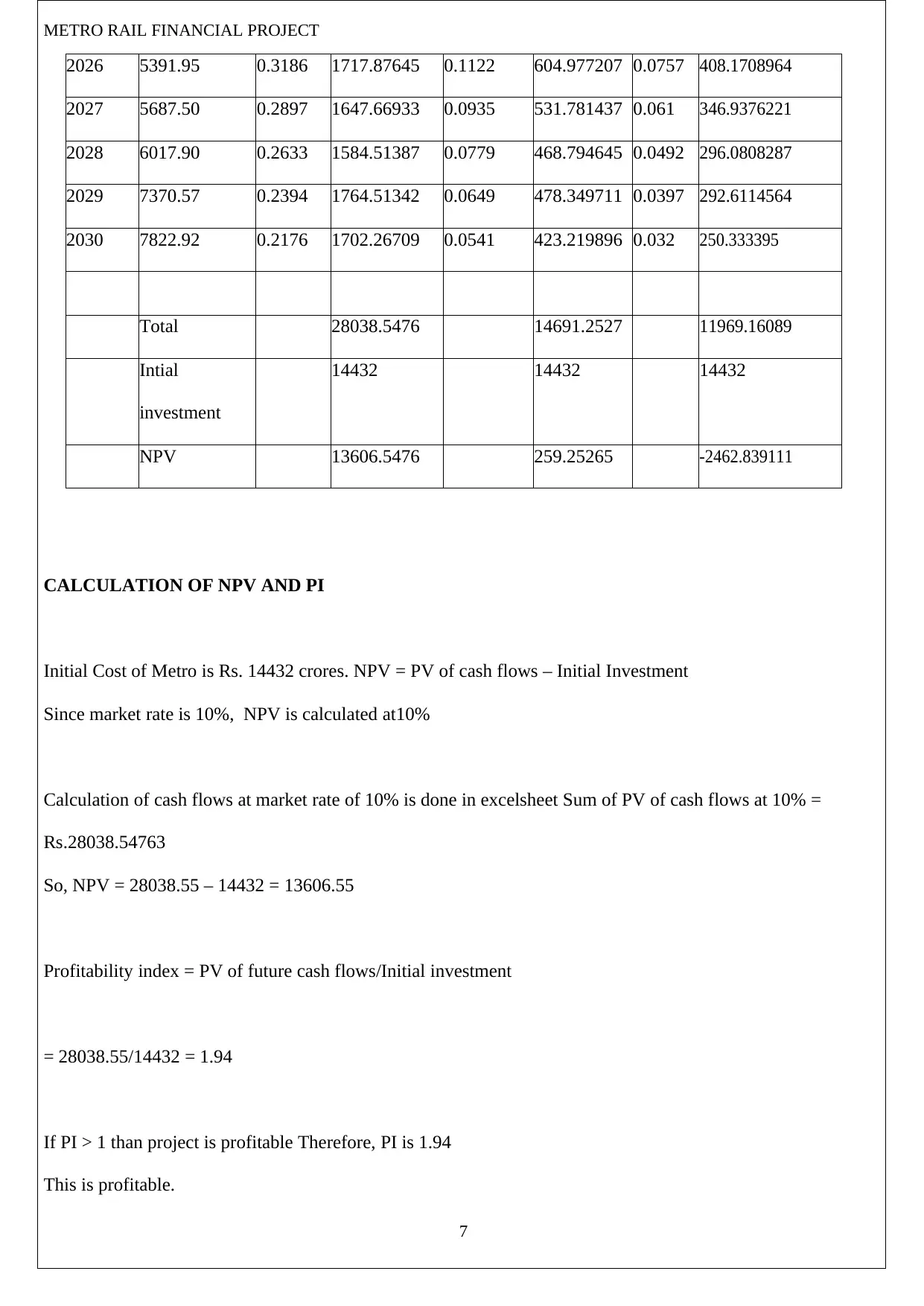
METRO RAIL FINANCIAL PROJECT
2026 5391.95 0.3186 1717.87645 0.1122 604.977207 0.0757 408.1708964
2027 5687.50 0.2897 1647.66933 0.0935 531.781437 0.061 346.9376221
2028 6017.90 0.2633 1584.51387 0.0779 468.794645 0.0492 296.0808287
2029 7370.57 0.2394 1764.51342 0.0649 478.349711 0.0397 292.6114564
2030 7822.92 0.2176 1702.26709 0.0541 423.219896 0.032 250.333395
Total 28038.5476 14691.2527 11969.16089
Intial
investment
14432 14432 14432
NPV 13606.5476 259.25265 -2462.839111
CALCULATION OF NPV AND PI
Initial Cost of Metro is Rs. 14432 crores. NPV = PV of cash flows – Initial Investment
Since market rate is 10%, NPV is calculated at10%
Calculation of cash flows at market rate of 10% is done in excelsheet Sum of PV of cash flows at 10% =
Rs.28038.54763
So, NPV = 28038.55 – 14432 = 13606.55
Profitability index = PV of future cash flows/Initial investment
= 28038.55/14432 = 1.94
If PI > 1 than project is profitable Therefore, PI is 1.94
This is profitable.
7
2026 5391.95 0.3186 1717.87645 0.1122 604.977207 0.0757 408.1708964
2027 5687.50 0.2897 1647.66933 0.0935 531.781437 0.061 346.9376221
2028 6017.90 0.2633 1584.51387 0.0779 468.794645 0.0492 296.0808287
2029 7370.57 0.2394 1764.51342 0.0649 478.349711 0.0397 292.6114564
2030 7822.92 0.2176 1702.26709 0.0541 423.219896 0.032 250.333395
Total 28038.5476 14691.2527 11969.16089
Intial
investment
14432 14432 14432
NPV 13606.5476 259.25265 -2462.839111
CALCULATION OF NPV AND PI
Initial Cost of Metro is Rs. 14432 crores. NPV = PV of cash flows – Initial Investment
Since market rate is 10%, NPV is calculated at10%
Calculation of cash flows at market rate of 10% is done in excelsheet Sum of PV of cash flows at 10% =
Rs.28038.54763
So, NPV = 28038.55 – 14432 = 13606.55
Profitability index = PV of future cash flows/Initial investment
= 28038.55/14432 = 1.94
If PI > 1 than project is profitable Therefore, PI is 1.94
This is profitable.
7
Paraphrase This Document
Need a fresh take? Get an instant paraphrase of this document with our AI Paraphraser
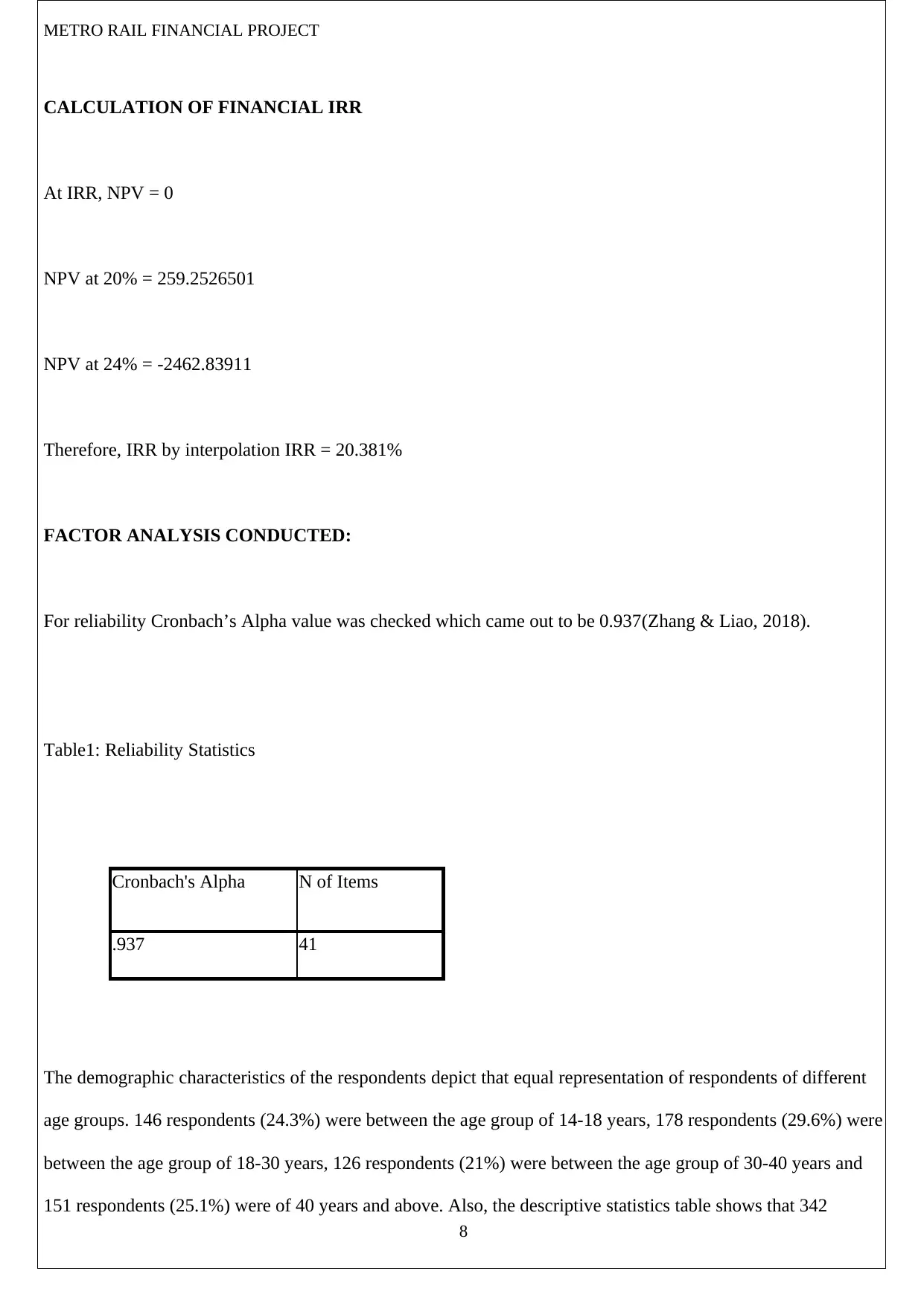
METRO RAIL FINANCIAL PROJECT
CALCULATION OF FINANCIAL IRR
At IRR, NPV = 0
NPV at 20% = 259.2526501
NPV at 24% = -2462.83911
Therefore, IRR by interpolation IRR = 20.381%
FACTOR ANALYSIS CONDUCTED:
For reliability Cronbach’s Alpha value was checked which came out to be 0.937(Zhang & Liao, 2018).
Table1: Reliability Statistics
Cronbach's Alpha N of Items
.937 41
The demographic characteristics of the respondents depict that equal representation of respondents of different
age groups. 146 respondents (24.3%) were between the age group of 14-18 years, 178 respondents (29.6%) were
between the age group of 18-30 years, 126 respondents (21%) were between the age group of 30-40 years and
151 respondents (25.1%) were of 40 years and above. Also, the descriptive statistics table shows that 342
8
CALCULATION OF FINANCIAL IRR
At IRR, NPV = 0
NPV at 20% = 259.2526501
NPV at 24% = -2462.83911
Therefore, IRR by interpolation IRR = 20.381%
FACTOR ANALYSIS CONDUCTED:
For reliability Cronbach’s Alpha value was checked which came out to be 0.937(Zhang & Liao, 2018).
Table1: Reliability Statistics
Cronbach's Alpha N of Items
.937 41
The demographic characteristics of the respondents depict that equal representation of respondents of different
age groups. 146 respondents (24.3%) were between the age group of 14-18 years, 178 respondents (29.6%) were
between the age group of 18-30 years, 126 respondents (21%) were between the age group of 30-40 years and
151 respondents (25.1%) were of 40 years and above. Also, the descriptive statistics table shows that 342
8

METRO RAIL FINANCIAL PROJECT
respondents (56.9%) were males and 259 respondents (43.1%) were females. Males have a higher representation
in the sample than females(Gulati, 2011).
The study comprise of descriptions and tabular displays to present suitable context for depicting conclusions
from the data collected. Tables prove to be apt method to improvise the method of presentation of the analysis. .
“Factor Analysis” has been used to find out the important factors of preference towards Delhi Metro for the
study by using SPSS Software19.0(Zhang & Liao, 2018).
9
respondents (56.9%) were males and 259 respondents (43.1%) were females. Males have a higher representation
in the sample than females(Gulati, 2011).
The study comprise of descriptions and tabular displays to present suitable context for depicting conclusions
from the data collected. Tables prove to be apt method to improvise the method of presentation of the analysis. .
“Factor Analysis” has been used to find out the important factors of preference towards Delhi Metro for the
study by using SPSS Software19.0(Zhang & Liao, 2018).
9
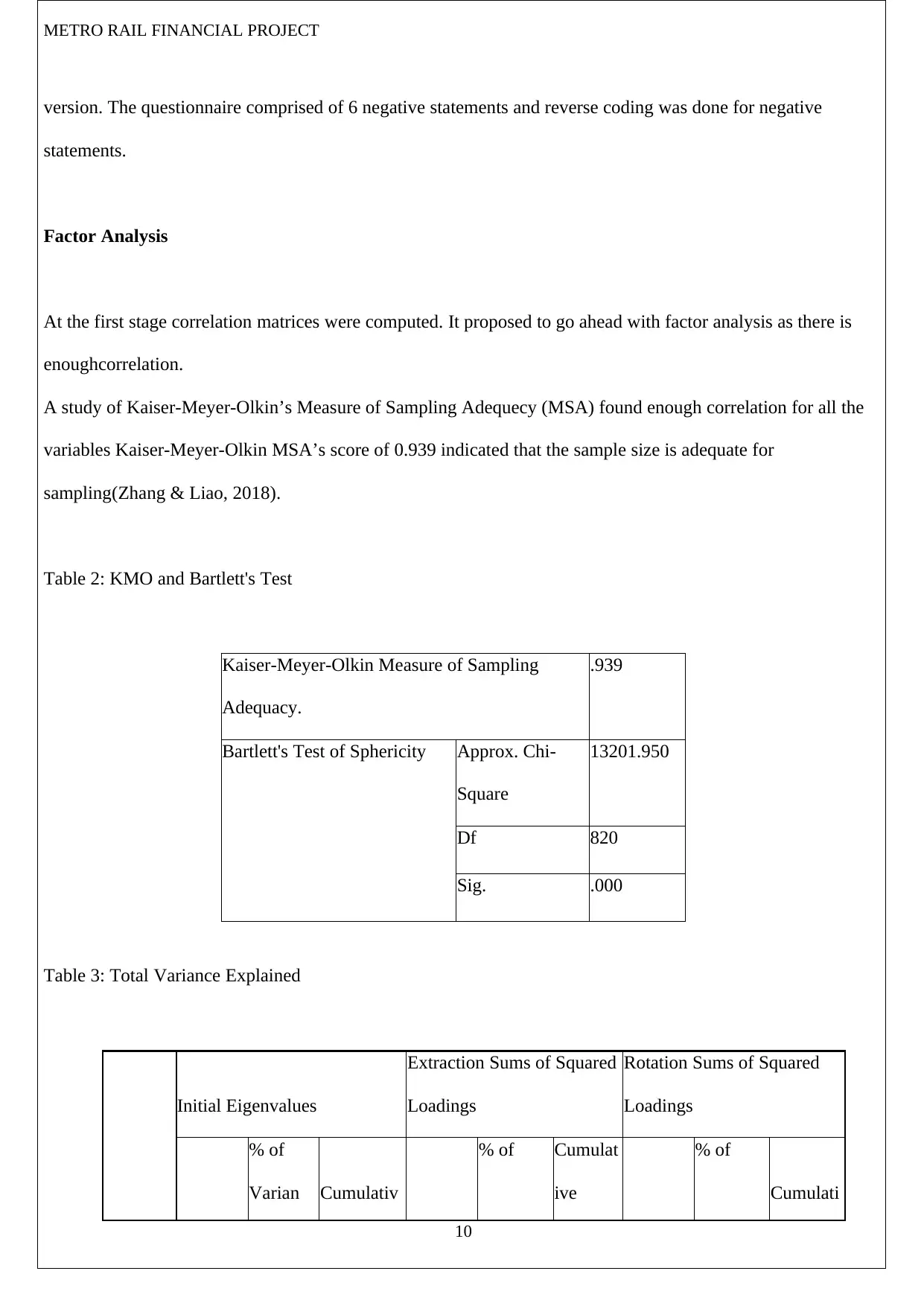
METRO RAIL FINANCIAL PROJECT
version. The questionnaire comprised of 6 negative statements and reverse coding was done for negative
statements.
Factor Analysis
At the first stage correlation matrices were computed. It proposed to go ahead with factor analysis as there is
enoughcorrelation.
A study of Kaiser-Meyer-Olkin’s Measure of Sampling Adequecy (MSA) found enough correlation for all the
variables Kaiser-Meyer-Olkin MSA’s score of 0.939 indicated that the sample size is adequate for
sampling(Zhang & Liao, 2018).
Table 2: KMO and Bartlett's Test
Kaiser-Meyer-Olkin Measure of Sampling
Adequacy.
.939
Bartlett's Test of Sphericity Approx. Chi-
Square
13201.950
Df 820
Sig. .000
Table 3: Total Variance Explained
Initial Eigenvalues
Extraction Sums of Squared
Loadings
Rotation Sums of Squared
Loadings
% of
Varian Cumulativ
% of Cumulat
ive
% of
Cumulati
10
version. The questionnaire comprised of 6 negative statements and reverse coding was done for negative
statements.
Factor Analysis
At the first stage correlation matrices were computed. It proposed to go ahead with factor analysis as there is
enoughcorrelation.
A study of Kaiser-Meyer-Olkin’s Measure of Sampling Adequecy (MSA) found enough correlation for all the
variables Kaiser-Meyer-Olkin MSA’s score of 0.939 indicated that the sample size is adequate for
sampling(Zhang & Liao, 2018).
Table 2: KMO and Bartlett's Test
Kaiser-Meyer-Olkin Measure of Sampling
Adequacy.
.939
Bartlett's Test of Sphericity Approx. Chi-
Square
13201.950
Df 820
Sig. .000
Table 3: Total Variance Explained
Initial Eigenvalues
Extraction Sums of Squared
Loadings
Rotation Sums of Squared
Loadings
% of
Varian Cumulativ
% of Cumulat
ive
% of
Cumulati
10
Secure Best Marks with AI Grader
Need help grading? Try our AI Grader for instant feedback on your assignments.
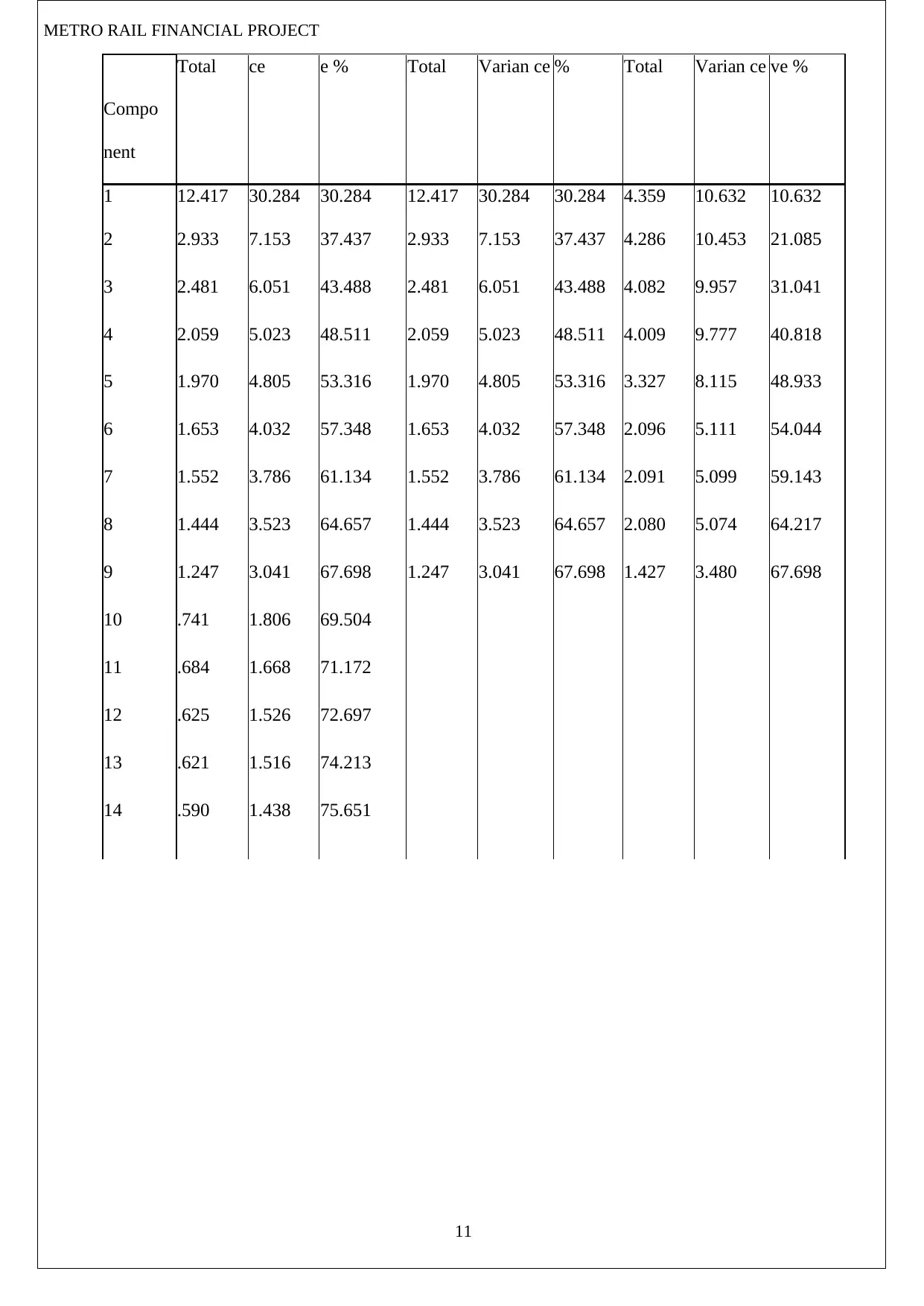
METRO RAIL FINANCIAL PROJECT
Compo
nent
Total ce e % Total Varian ce % Total Varian ce ve %
1 12.417 30.284 30.284 12.417 30.284 30.284 4.359 10.632 10.632
2 2.933 7.153 37.437 2.933 7.153 37.437 4.286 10.453 21.085
3 2.481 6.051 43.488 2.481 6.051 43.488 4.082 9.957 31.041
4 2.059 5.023 48.511 2.059 5.023 48.511 4.009 9.777 40.818
5 1.970 4.805 53.316 1.970 4.805 53.316 3.327 8.115 48.933
6 1.653 4.032 57.348 1.653 4.032 57.348 2.096 5.111 54.044
7 1.552 3.786 61.134 1.552 3.786 61.134 2.091 5.099 59.143
8 1.444 3.523 64.657 1.444 3.523 64.657 2.080 5.074 64.217
9 1.247 3.041 67.698 1.247 3.041 67.698 1.427 3.480 67.698
10 .741 1.806 69.504
11 .684 1.668 71.172
12 .625 1.526 72.697
13 .621 1.516 74.213
14 .590 1.438 75.651
11
Compo
nent
Total ce e % Total Varian ce % Total Varian ce ve %
1 12.417 30.284 30.284 12.417 30.284 30.284 4.359 10.632 10.632
2 2.933 7.153 37.437 2.933 7.153 37.437 4.286 10.453 21.085
3 2.481 6.051 43.488 2.481 6.051 43.488 4.082 9.957 31.041
4 2.059 5.023 48.511 2.059 5.023 48.511 4.009 9.777 40.818
5 1.970 4.805 53.316 1.970 4.805 53.316 3.327 8.115 48.933
6 1.653 4.032 57.348 1.653 4.032 57.348 2.096 5.111 54.044
7 1.552 3.786 61.134 1.552 3.786 61.134 2.091 5.099 59.143
8 1.444 3.523 64.657 1.444 3.523 64.657 2.080 5.074 64.217
9 1.247 3.041 67.698 1.247 3.041 67.698 1.427 3.480 67.698
10 .741 1.806 69.504
11 .684 1.668 71.172
12 .625 1.526 72.697
13 .621 1.516 74.213
14 .590 1.438 75.651
11
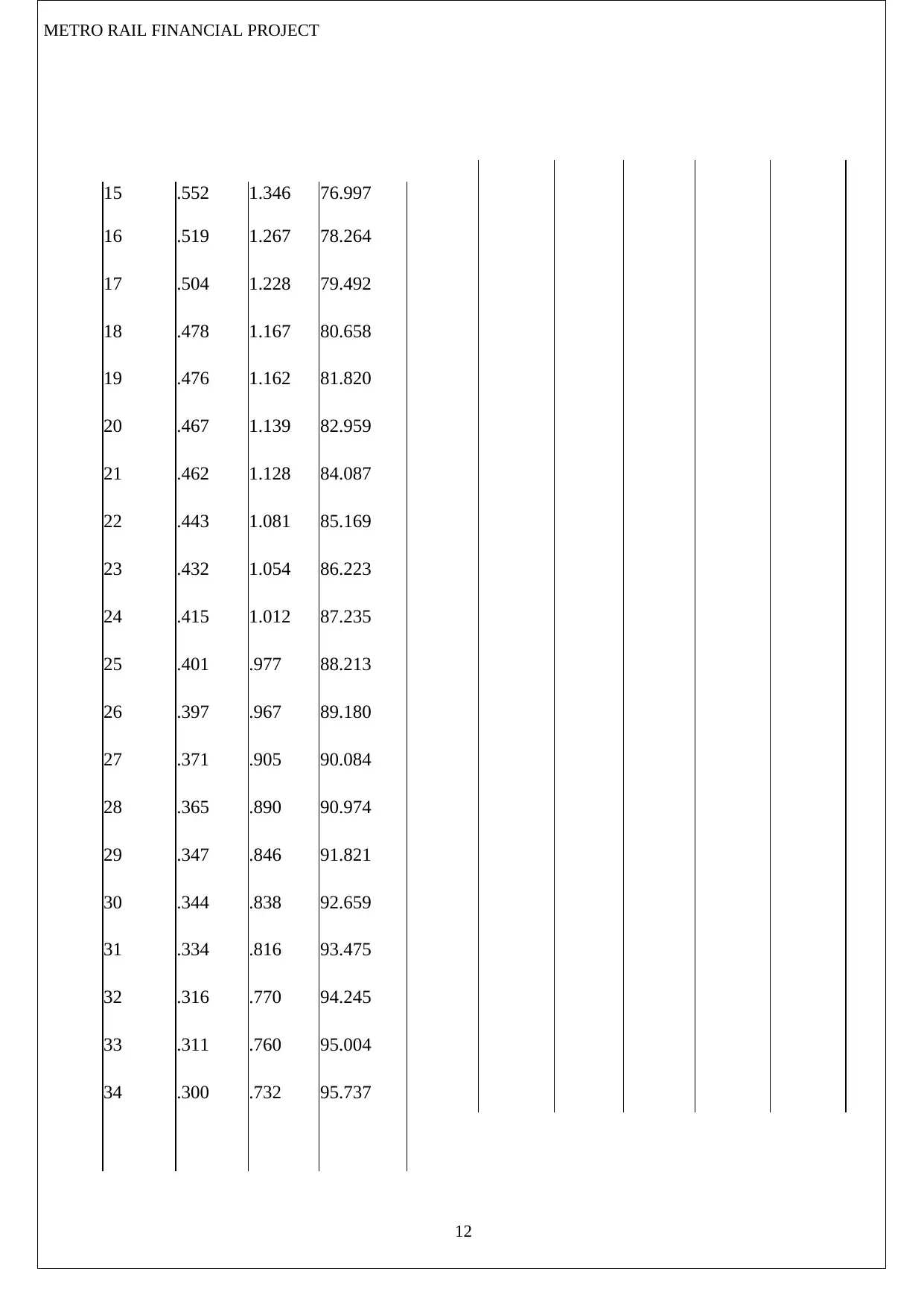
METRO RAIL FINANCIAL PROJECT
15 .552 1.346 76.997
16 .519 1.267 78.264
17 .504 1.228 79.492
18 .478 1.167 80.658
19 .476 1.162 81.820
20 .467 1.139 82.959
21 .462 1.128 84.087
22 .443 1.081 85.169
23 .432 1.054 86.223
24 .415 1.012 87.235
25 .401 .977 88.213
26 .397 .967 89.180
27 .371 .905 90.084
28 .365 .890 90.974
29 .347 .846 91.821
30 .344 .838 92.659
31 .334 .816 93.475
32 .316 .770 94.245
33 .311 .760 95.004
34 .300 .732 95.737
12
15 .552 1.346 76.997
16 .519 1.267 78.264
17 .504 1.228 79.492
18 .478 1.167 80.658
19 .476 1.162 81.820
20 .467 1.139 82.959
21 .462 1.128 84.087
22 .443 1.081 85.169
23 .432 1.054 86.223
24 .415 1.012 87.235
25 .401 .977 88.213
26 .397 .967 89.180
27 .371 .905 90.084
28 .365 .890 90.974
29 .347 .846 91.821
30 .344 .838 92.659
31 .334 .816 93.475
32 .316 .770 94.245
33 .311 .760 95.004
34 .300 .732 95.737
12
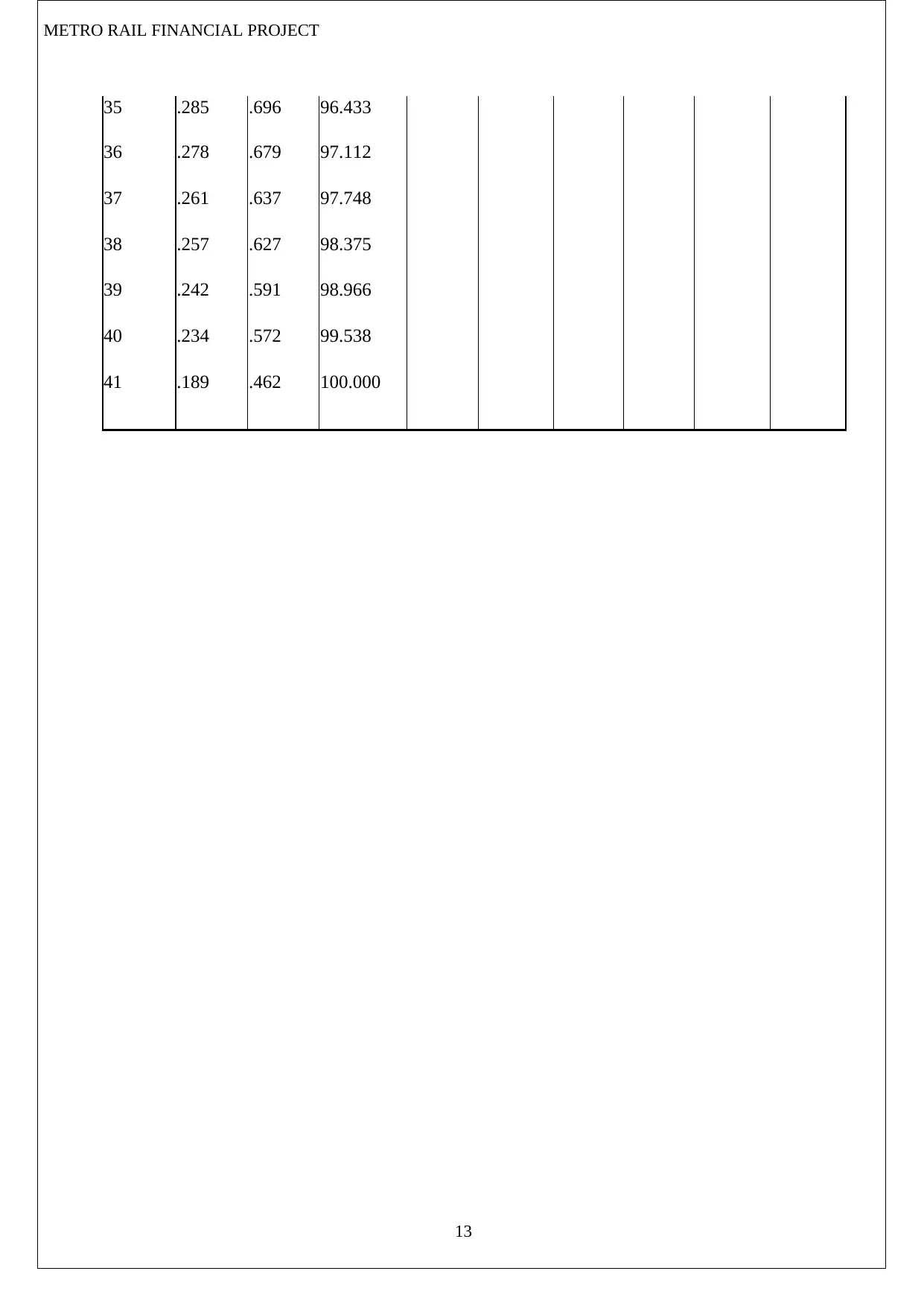
METRO RAIL FINANCIAL PROJECT
35 .285 .696 96.433
36 .278 .679 97.112
37 .261 .637 97.748
38 .257 .627 98.375
39 .242 .591 98.966
40 .234 .572 99.538
41 .189 .462 100.000
13
35 .285 .696 96.433
36 .278 .679 97.112
37 .261 .637 97.748
38 .257 .627 98.375
39 .242 .591 98.966
40 .234 .572 99.538
41 .189 .462 100.000
13
Paraphrase This Document
Need a fresh take? Get an instant paraphrase of this document with our AI Paraphraser
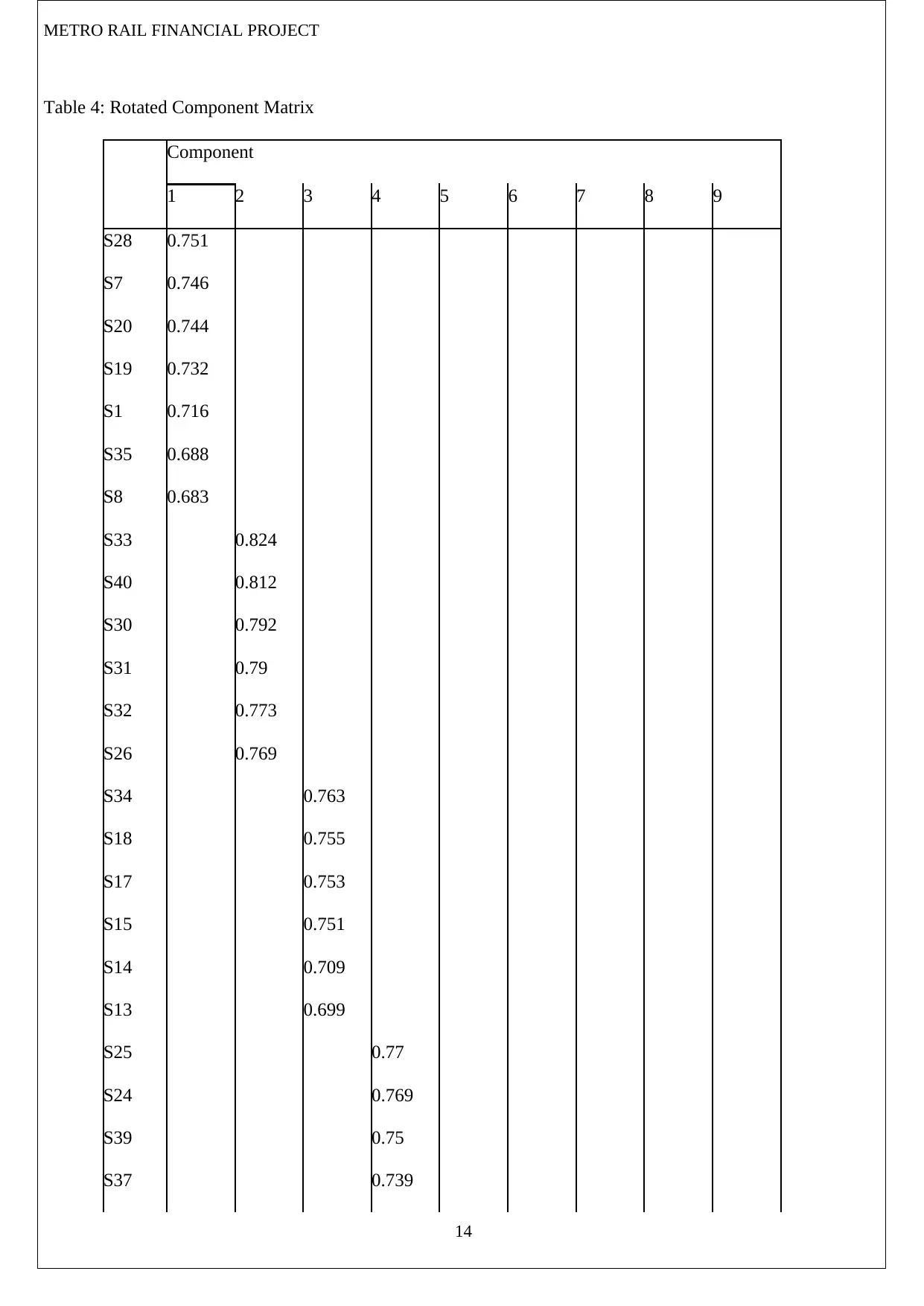
METRO RAIL FINANCIAL PROJECT
Table 4: Rotated Component Matrix
Component
1 2 3 4 5 6 7 8 9
S28 0.751
S7 0.746
S20 0.744
S19 0.732
S1 0.716
S35 0.688
S8 0.683
S33 0.824
S40 0.812
S30 0.792
S31 0.79
S32 0.773
S26 0.769
S34 0.763
S18 0.755
S17 0.753
S15 0.751
S14 0.709
S13 0.699
S25 0.77
S24 0.769
S39 0.75
S37 0.739
14
Table 4: Rotated Component Matrix
Component
1 2 3 4 5 6 7 8 9
S28 0.751
S7 0.746
S20 0.744
S19 0.732
S1 0.716
S35 0.688
S8 0.683
S33 0.824
S40 0.812
S30 0.792
S31 0.79
S32 0.773
S26 0.769
S34 0.763
S18 0.755
S17 0.753
S15 0.751
S14 0.709
S13 0.699
S25 0.77
S24 0.769
S39 0.75
S37 0.739
14
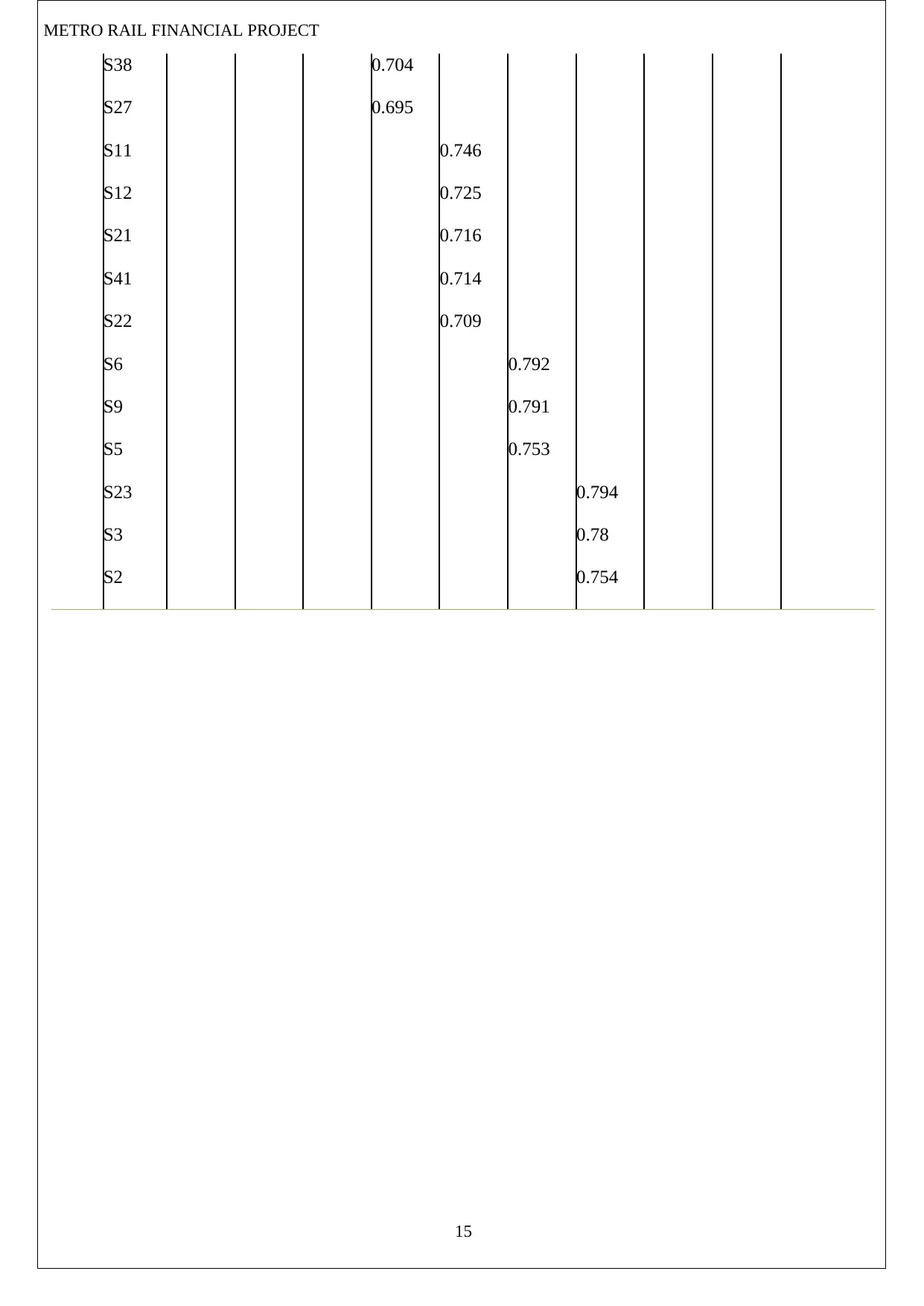
METRO RAIL FINANCIAL PROJECT
S38 0.704
S27 0.695
S11 0.746
S12 0.725
S21 0.716
S41 0.714
S22 0.709
S6 0.792
S9 0.791
S5 0.753
S23 0.794
S3 0.78
S2 0.754
15
S38 0.704
S27 0.695
S11 0.746
S12 0.725
S21 0.716
S41 0.714
S22 0.709
S6 0.792
S9 0.791
S5 0.753
S23 0.794
S3 0.78
S2 0.754
15
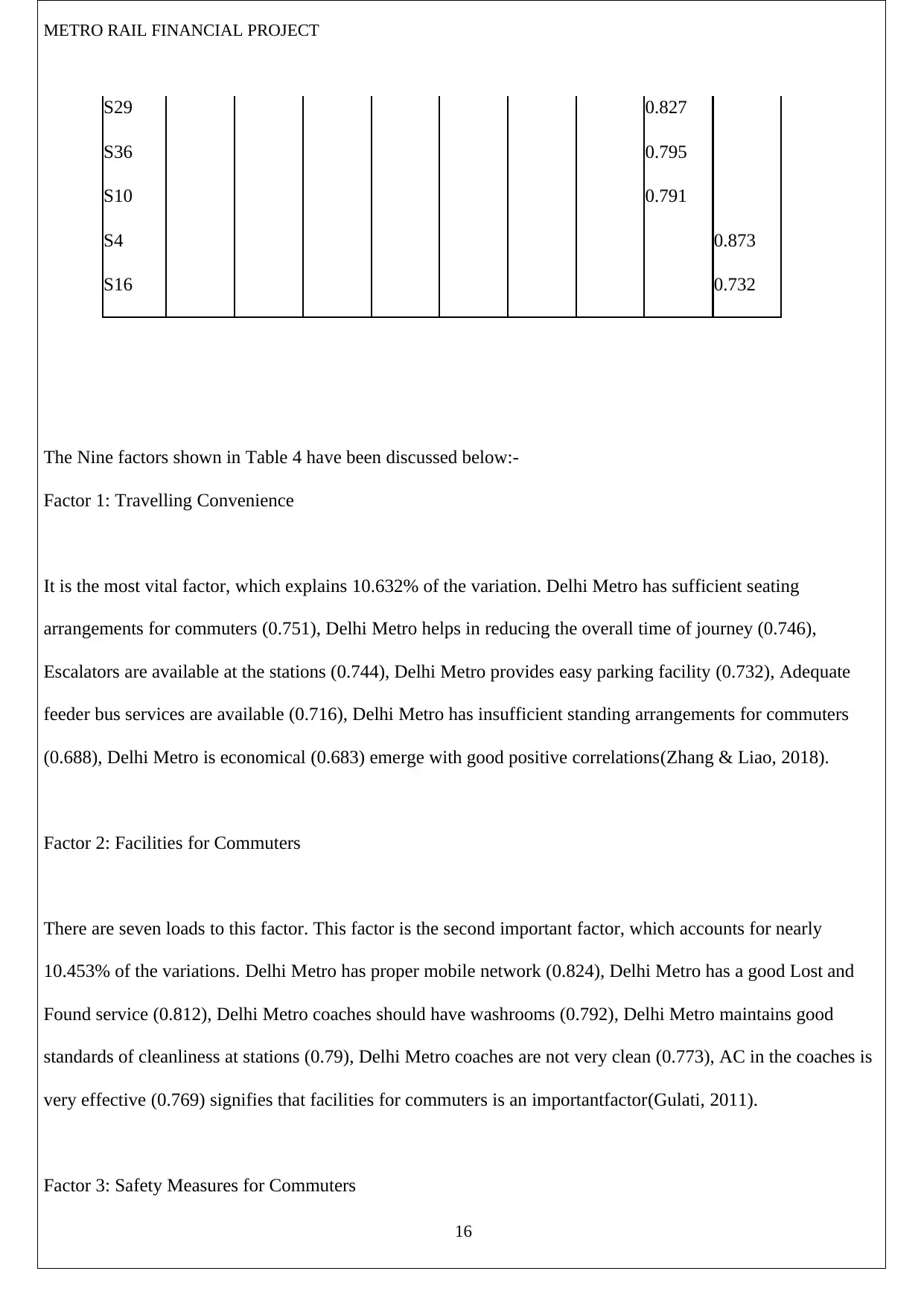
METRO RAIL FINANCIAL PROJECT
S29 0.827
S36 0.795
S10 0.791
S4 0.873
S16 0.732
The Nine factors shown in Table 4 have been discussed below:-
Factor 1: Travelling Convenience
It is the most vital factor, which explains 10.632% of the variation. Delhi Metro has sufficient seating
arrangements for commuters (0.751), Delhi Metro helps in reducing the overall time of journey (0.746),
Escalators are available at the stations (0.744), Delhi Metro provides easy parking facility (0.732), Adequate
feeder bus services are available (0.716), Delhi Metro has insufficient standing arrangements for commuters
(0.688), Delhi Metro is economical (0.683) emerge with good positive correlations(Zhang & Liao, 2018).
Factor 2: Facilities for Commuters
There are seven loads to this factor. This factor is the second important factor, which accounts for nearly
10.453% of the variations. Delhi Metro has proper mobile network (0.824), Delhi Metro has a good Lost and
Found service (0.812), Delhi Metro coaches should have washrooms (0.792), Delhi Metro maintains good
standards of cleanliness at stations (0.79), Delhi Metro coaches are not very clean (0.773), AC in the coaches is
very effective (0.769) signifies that facilities for commuters is an importantfactor(Gulati, 2011).
Factor 3: Safety Measures for Commuters
16
S29 0.827
S36 0.795
S10 0.791
S4 0.873
S16 0.732
The Nine factors shown in Table 4 have been discussed below:-
Factor 1: Travelling Convenience
It is the most vital factor, which explains 10.632% of the variation. Delhi Metro has sufficient seating
arrangements for commuters (0.751), Delhi Metro helps in reducing the overall time of journey (0.746),
Escalators are available at the stations (0.744), Delhi Metro provides easy parking facility (0.732), Adequate
feeder bus services are available (0.716), Delhi Metro has insufficient standing arrangements for commuters
(0.688), Delhi Metro is economical (0.683) emerge with good positive correlations(Zhang & Liao, 2018).
Factor 2: Facilities for Commuters
There are seven loads to this factor. This factor is the second important factor, which accounts for nearly
10.453% of the variations. Delhi Metro has proper mobile network (0.824), Delhi Metro has a good Lost and
Found service (0.812), Delhi Metro coaches should have washrooms (0.792), Delhi Metro maintains good
standards of cleanliness at stations (0.79), Delhi Metro coaches are not very clean (0.773), AC in the coaches is
very effective (0.769) signifies that facilities for commuters is an importantfactor(Gulati, 2011).
Factor 3: Safety Measures for Commuters
16
Secure Best Marks with AI Grader
Need help grading? Try our AI Grader for instant feedback on your assignments.
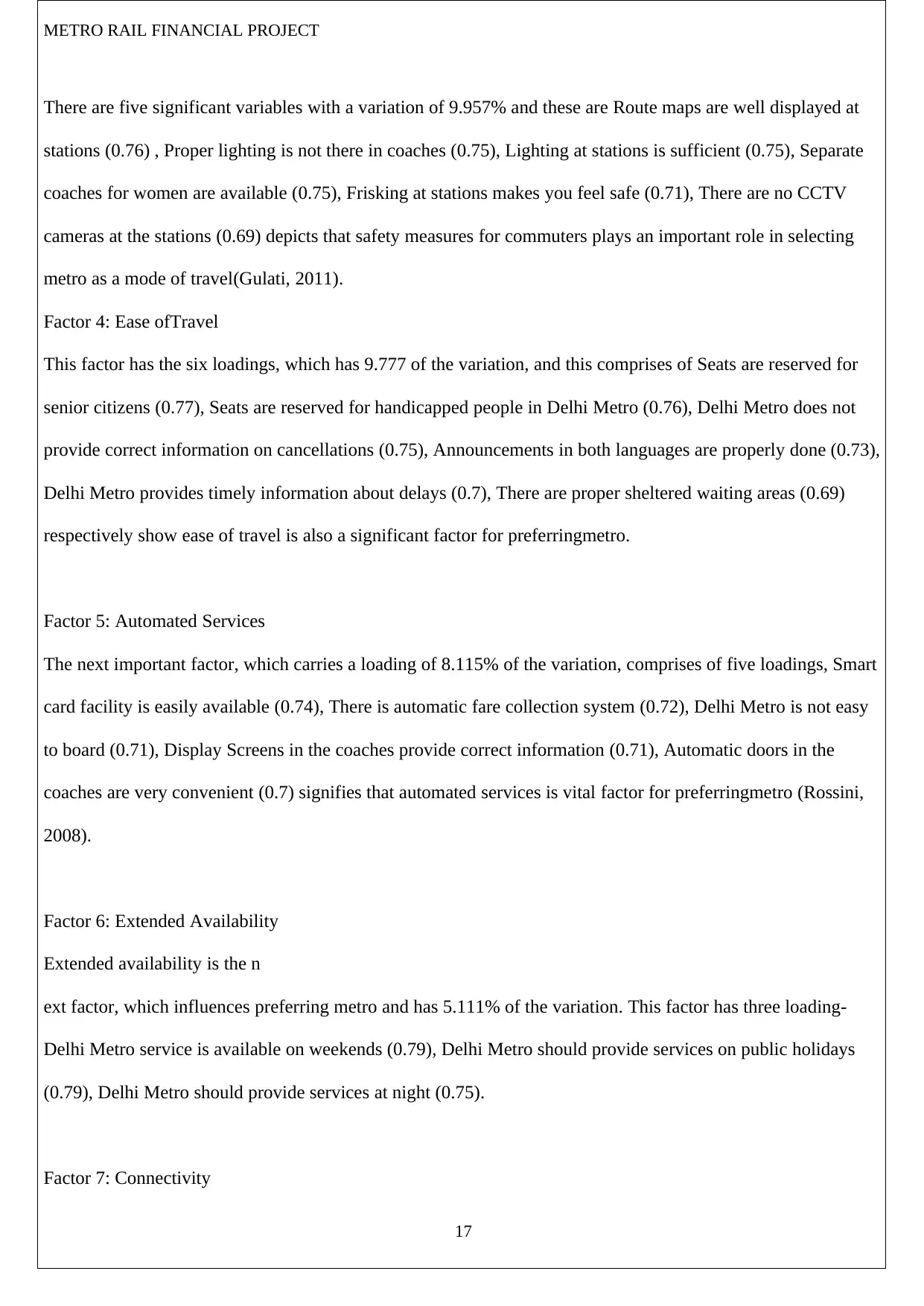
METRO RAIL FINANCIAL PROJECT
There are five significant variables with a variation of 9.957% and these are Route maps are well displayed at
stations (0.76) , Proper lighting is not there in coaches (0.75), Lighting at stations is sufficient (0.75), Separate
coaches for women are available (0.75), Frisking at stations makes you feel safe (0.71), There are no CCTV
cameras at the stations (0.69) depicts that safety measures for commuters plays an important role in selecting
metro as a mode of travel(Gulati, 2011).
Factor 4: Ease ofTravel
This factor has the six loadings, which has 9.777 of the variation, and this comprises of Seats are reserved for
senior citizens (0.77), Seats are reserved for handicapped people in Delhi Metro (0.76), Delhi Metro does not
provide correct information on cancellations (0.75), Announcements in both languages are properly done (0.73),
Delhi Metro provides timely information about delays (0.7), There are proper sheltered waiting areas (0.69)
respectively show ease of travel is also a significant factor for preferringmetro.
Factor 5: Automated Services
The next important factor, which carries a loading of 8.115% of the variation, comprises of five loadings, Smart
card facility is easily available (0.74), There is automatic fare collection system (0.72), Delhi Metro is not easy
to board (0.71), Display Screens in the coaches provide correct information (0.71), Automatic doors in the
coaches are very convenient (0.7) signifies that automated services is vital factor for preferringmetro (Rossini,
2008).
Factor 6: Extended Availability
Extended availability is the n
ext factor, which influences preferring metro and has 5.111% of the variation. This factor has three loading-
Delhi Metro service is available on weekends (0.79), Delhi Metro should provide services on public holidays
(0.79), Delhi Metro should provide services at night (0.75).
Factor 7: Connectivity
17
There are five significant variables with a variation of 9.957% and these are Route maps are well displayed at
stations (0.76) , Proper lighting is not there in coaches (0.75), Lighting at stations is sufficient (0.75), Separate
coaches for women are available (0.75), Frisking at stations makes you feel safe (0.71), There are no CCTV
cameras at the stations (0.69) depicts that safety measures for commuters plays an important role in selecting
metro as a mode of travel(Gulati, 2011).
Factor 4: Ease ofTravel
This factor has the six loadings, which has 9.777 of the variation, and this comprises of Seats are reserved for
senior citizens (0.77), Seats are reserved for handicapped people in Delhi Metro (0.76), Delhi Metro does not
provide correct information on cancellations (0.75), Announcements in both languages are properly done (0.73),
Delhi Metro provides timely information about delays (0.7), There are proper sheltered waiting areas (0.69)
respectively show ease of travel is also a significant factor for preferringmetro.
Factor 5: Automated Services
The next important factor, which carries a loading of 8.115% of the variation, comprises of five loadings, Smart
card facility is easily available (0.74), There is automatic fare collection system (0.72), Delhi Metro is not easy
to board (0.71), Display Screens in the coaches provide correct information (0.71), Automatic doors in the
coaches are very convenient (0.7) signifies that automated services is vital factor for preferringmetro (Rossini,
2008).
Factor 6: Extended Availability
Extended availability is the n
ext factor, which influences preferring metro and has 5.111% of the variation. This factor has three loading-
Delhi Metro service is available on weekends (0.79), Delhi Metro should provide services on public holidays
(0.79), Delhi Metro should provide services at night (0.75).
Factor 7: Connectivity
17
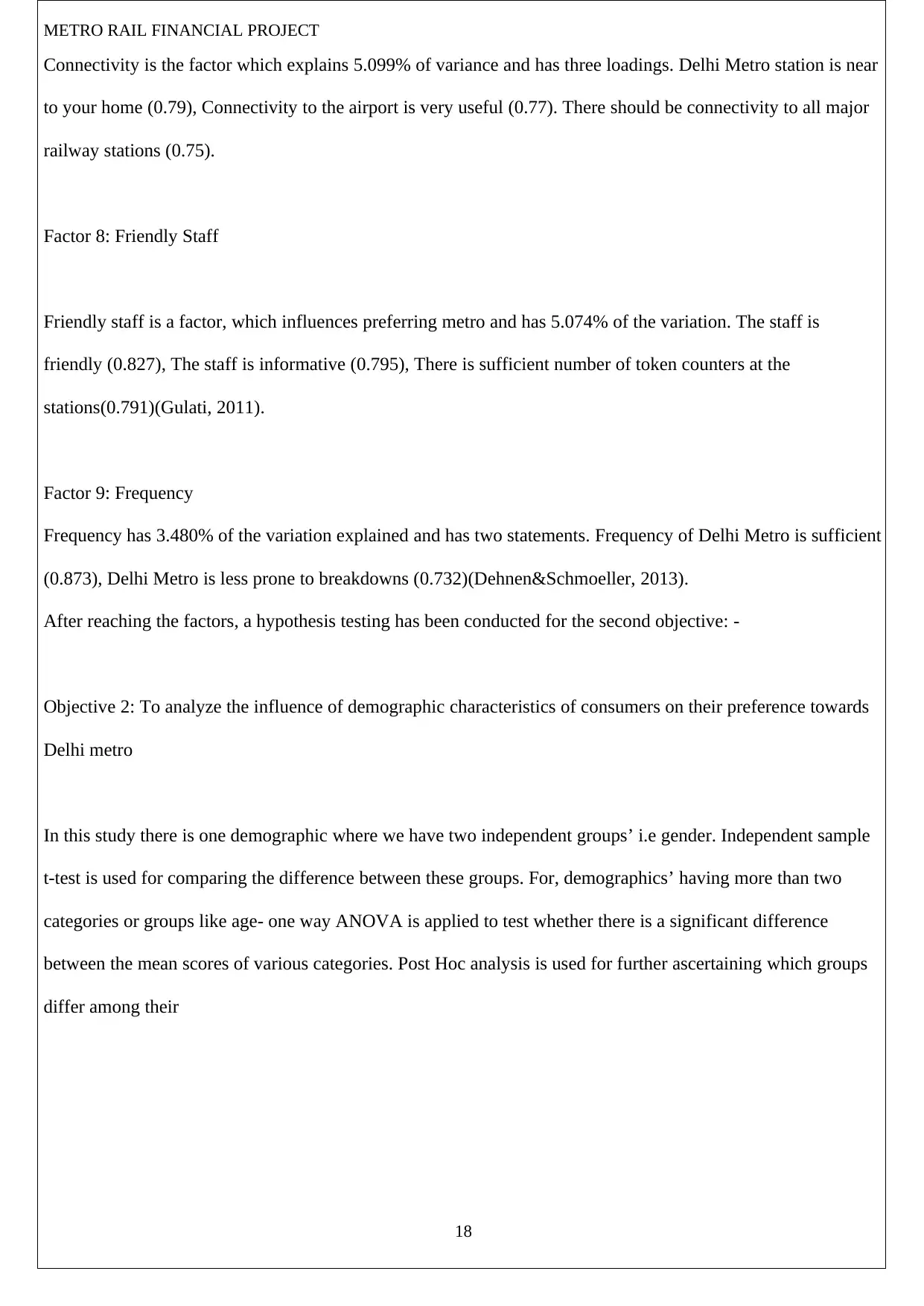
METRO RAIL FINANCIAL PROJECT
Connectivity is the factor which explains 5.099% of variance and has three loadings. Delhi Metro station is near
to your home (0.79), Connectivity to the airport is very useful (0.77). There should be connectivity to all major
railway stations (0.75).
Factor 8: Friendly Staff
Friendly staff is a factor, which influences preferring metro and has 5.074% of the variation. The staff is
friendly (0.827), The staff is informative (0.795), There is sufficient number of token counters at the
stations(0.791)(Gulati, 2011).
Factor 9: Frequency
Frequency has 3.480% of the variation explained and has two statements. Frequency of Delhi Metro is sufficient
(0.873), Delhi Metro is less prone to breakdowns (0.732)(Dehnen&Schmoeller, 2013).
After reaching the factors, a hypothesis testing has been conducted for the second objective: -
Objective 2: To analyze the influence of demographic characteristics of consumers on their preference towards
Delhi metro
In this study there is one demographic where we have two independent groups’ i.e gender. Independent sample
t-test is used for comparing the difference between these groups. For, demographics’ having more than two
categories or groups like age- one way ANOVA is applied to test whether there is a significant difference
between the mean scores of various categories. Post Hoc analysis is used for further ascertaining which groups
differ among their
18
Connectivity is the factor which explains 5.099% of variance and has three loadings. Delhi Metro station is near
to your home (0.79), Connectivity to the airport is very useful (0.77). There should be connectivity to all major
railway stations (0.75).
Factor 8: Friendly Staff
Friendly staff is a factor, which influences preferring metro and has 5.074% of the variation. The staff is
friendly (0.827), The staff is informative (0.795), There is sufficient number of token counters at the
stations(0.791)(Gulati, 2011).
Factor 9: Frequency
Frequency has 3.480% of the variation explained and has two statements. Frequency of Delhi Metro is sufficient
(0.873), Delhi Metro is less prone to breakdowns (0.732)(Dehnen&Schmoeller, 2013).
After reaching the factors, a hypothesis testing has been conducted for the second objective: -
Objective 2: To analyze the influence of demographic characteristics of consumers on their preference towards
Delhi metro
In this study there is one demographic where we have two independent groups’ i.e gender. Independent sample
t-test is used for comparing the difference between these groups. For, demographics’ having more than two
categories or groups like age- one way ANOVA is applied to test whether there is a significant difference
between the mean scores of various categories. Post Hoc analysis is used for further ascertaining which groups
differ among their
18
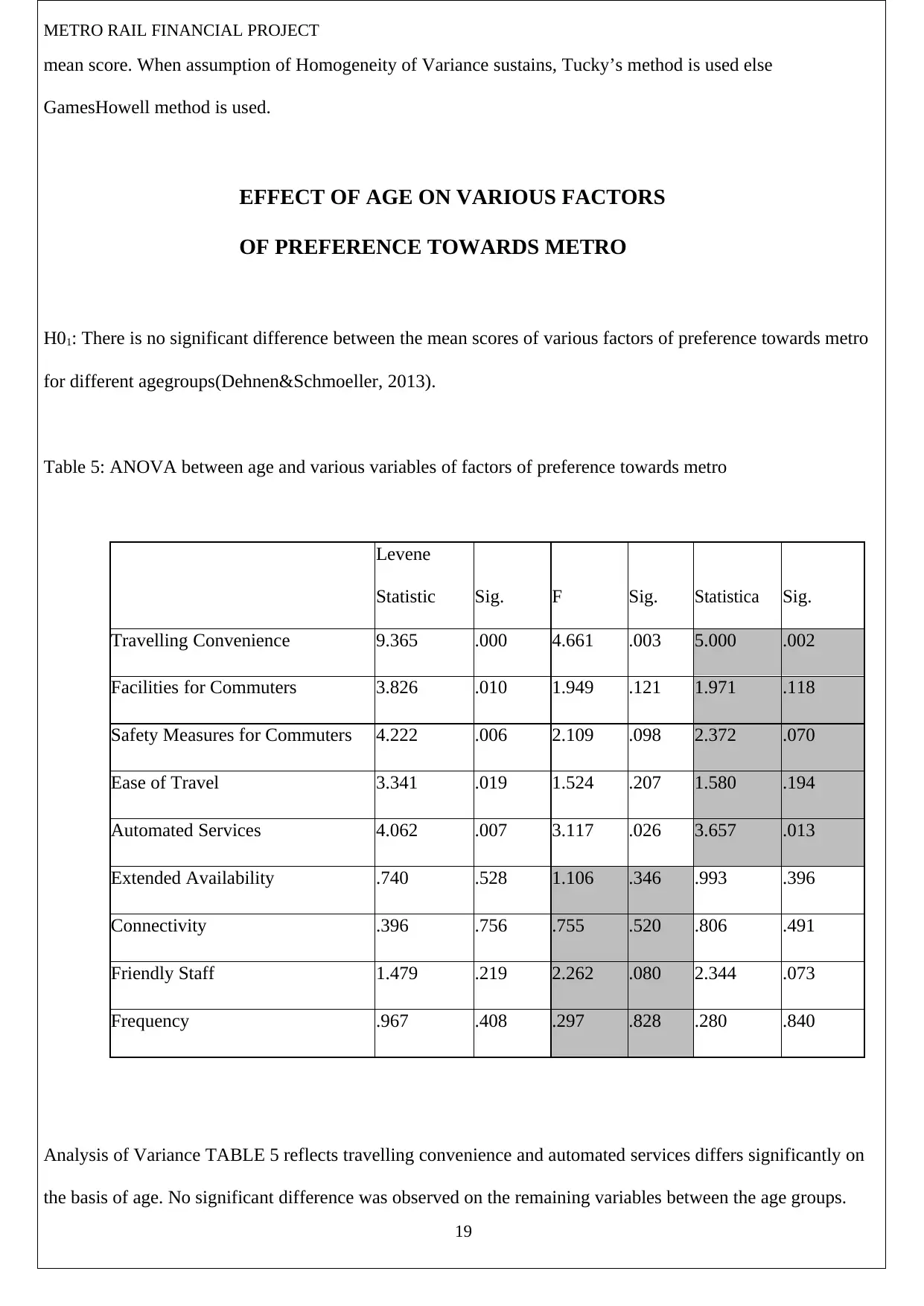
METRO RAIL FINANCIAL PROJECT
mean score. When assumption of Homogeneity of Variance sustains, Tucky’s method is used else
GamesHowell method is used.
EFFECT OF AGE ON VARIOUS FACTORS
OF PREFERENCE TOWARDS METRO
H01: There is no significant difference between the mean scores of various factors of preference towards metro
for different agegroups(Dehnen&Schmoeller, 2013).
Table 5: ANOVA between age and various variables of factors of preference towards metro
Levene
Statistic Sig. F Sig. Statistica Sig.
Travelling Convenience 9.365 .000 4.661 .003 5.000 .002
Facilities for Commuters 3.826 .010 1.949 .121 1.971 .118
Safety Measures for Commuters 4.222 .006 2.109 .098 2.372 .070
Ease of Travel 3.341 .019 1.524 .207 1.580 .194
Automated Services 4.062 .007 3.117 .026 3.657 .013
Extended Availability .740 .528 1.106 .346 .993 .396
Connectivity .396 .756 .755 .520 .806 .491
Friendly Staff 1.479 .219 2.262 .080 2.344 .073
Frequency .967 .408 .297 .828 .280 .840
Analysis of Variance TABLE 5 reflects travelling convenience and automated services differs significantly on
the basis of age. No significant difference was observed on the remaining variables between the age groups.
19
mean score. When assumption of Homogeneity of Variance sustains, Tucky’s method is used else
GamesHowell method is used.
EFFECT OF AGE ON VARIOUS FACTORS
OF PREFERENCE TOWARDS METRO
H01: There is no significant difference between the mean scores of various factors of preference towards metro
for different agegroups(Dehnen&Schmoeller, 2013).
Table 5: ANOVA between age and various variables of factors of preference towards metro
Levene
Statistic Sig. F Sig. Statistica Sig.
Travelling Convenience 9.365 .000 4.661 .003 5.000 .002
Facilities for Commuters 3.826 .010 1.949 .121 1.971 .118
Safety Measures for Commuters 4.222 .006 2.109 .098 2.372 .070
Ease of Travel 3.341 .019 1.524 .207 1.580 .194
Automated Services 4.062 .007 3.117 .026 3.657 .013
Extended Availability .740 .528 1.106 .346 .993 .396
Connectivity .396 .756 .755 .520 .806 .491
Friendly Staff 1.479 .219 2.262 .080 2.344 .073
Frequency .967 .408 .297 .828 .280 .840
Analysis of Variance TABLE 5 reflects travelling convenience and automated services differs significantly on
the basis of age. No significant difference was observed on the remaining variables between the age groups.
19
Paraphrase This Document
Need a fresh take? Get an instant paraphrase of this document with our AI Paraphraser

METRO RAIL FINANCIAL PROJECT
Hence, null hypothesis stands REJECTED in case of convenience and automated services. For further analysis
post hoc was used(Dehnen&Schmoeller, 2013).
20
Hence, null hypothesis stands REJECTED in case of convenience and automated services. For further analysis
post hoc was used(Dehnen&Schmoeller, 2013).
20
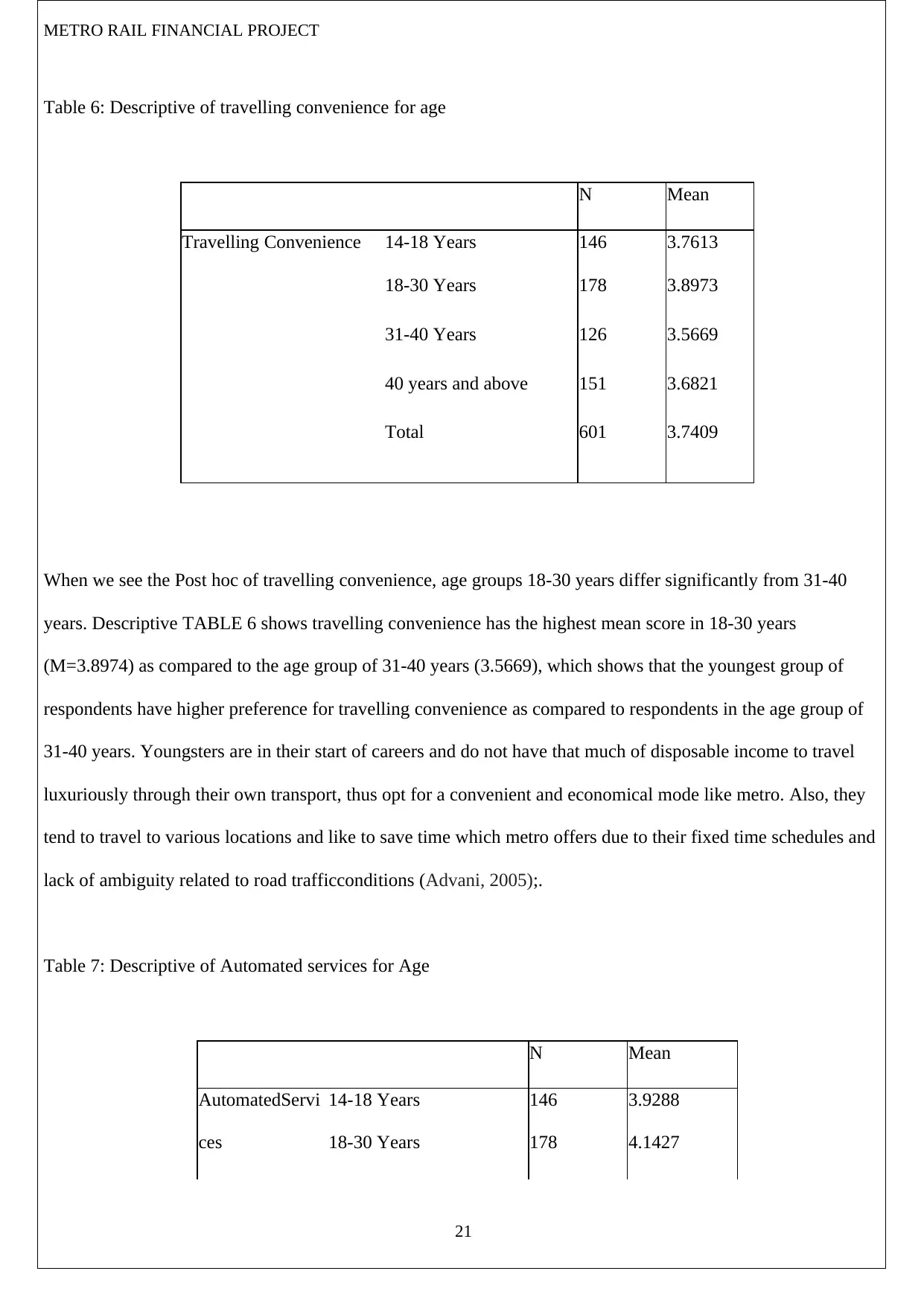
METRO RAIL FINANCIAL PROJECT
Table 6: Descriptive of travelling convenience for age
N Mean
Travelling Convenience 14-18 Years 146 3.7613
18-30 Years 178 3.8973
31-40 Years 126 3.5669
40 years and above 151 3.6821
Total 601 3.7409
When we see the Post hoc of travelling convenience, age groups 18-30 years differ significantly from 31-40
years. Descriptive TABLE 6 shows travelling convenience has the highest mean score in 18-30 years
(M=3.8974) as compared to the age group of 31-40 years (3.5669), which shows that the youngest group of
respondents have higher preference for travelling convenience as compared to respondents in the age group of
31-40 years. Youngsters are in their start of careers and do not have that much of disposable income to travel
luxuriously through their own transport, thus opt for a convenient and economical mode like metro. Also, they
tend to travel to various locations and like to save time which metro offers due to their fixed time schedules and
lack of ambiguity related to road trafficconditions (Advani, 2005);.
Table 7: Descriptive of Automated services for Age
N Mean
AutomatedServi
ces
14-18 Years 146 3.9288
18-30 Years 178 4.1427
21
Table 6: Descriptive of travelling convenience for age
N Mean
Travelling Convenience 14-18 Years 146 3.7613
18-30 Years 178 3.8973
31-40 Years 126 3.5669
40 years and above 151 3.6821
Total 601 3.7409
When we see the Post hoc of travelling convenience, age groups 18-30 years differ significantly from 31-40
years. Descriptive TABLE 6 shows travelling convenience has the highest mean score in 18-30 years
(M=3.8974) as compared to the age group of 31-40 years (3.5669), which shows that the youngest group of
respondents have higher preference for travelling convenience as compared to respondents in the age group of
31-40 years. Youngsters are in their start of careers and do not have that much of disposable income to travel
luxuriously through their own transport, thus opt for a convenient and economical mode like metro. Also, they
tend to travel to various locations and like to save time which metro offers due to their fixed time schedules and
lack of ambiguity related to road trafficconditions (Advani, 2005);.
Table 7: Descriptive of Automated services for Age
N Mean
AutomatedServi
ces
14-18 Years 146 3.9288
18-30 Years 178 4.1427
21
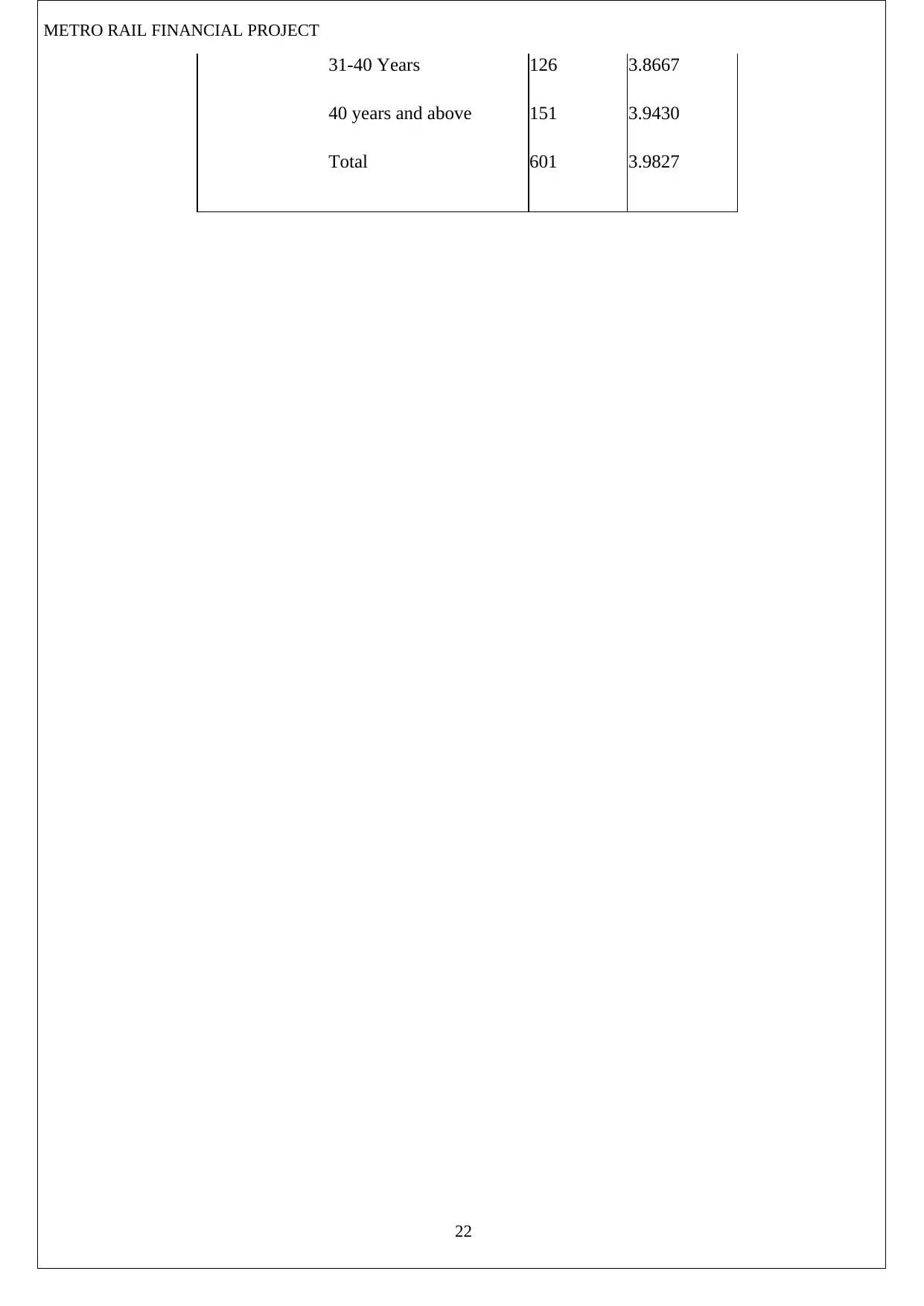
METRO RAIL FINANCIAL PROJECT
31-40 Years 126 3.8667
40 years and above 151 3.9430
Total 601 3.9827
22
31-40 Years 126 3.8667
40 years and above 151 3.9430
Total 601 3.9827
22
Secure Best Marks with AI Grader
Need help grading? Try our AI Grader for instant feedback on your assignments.
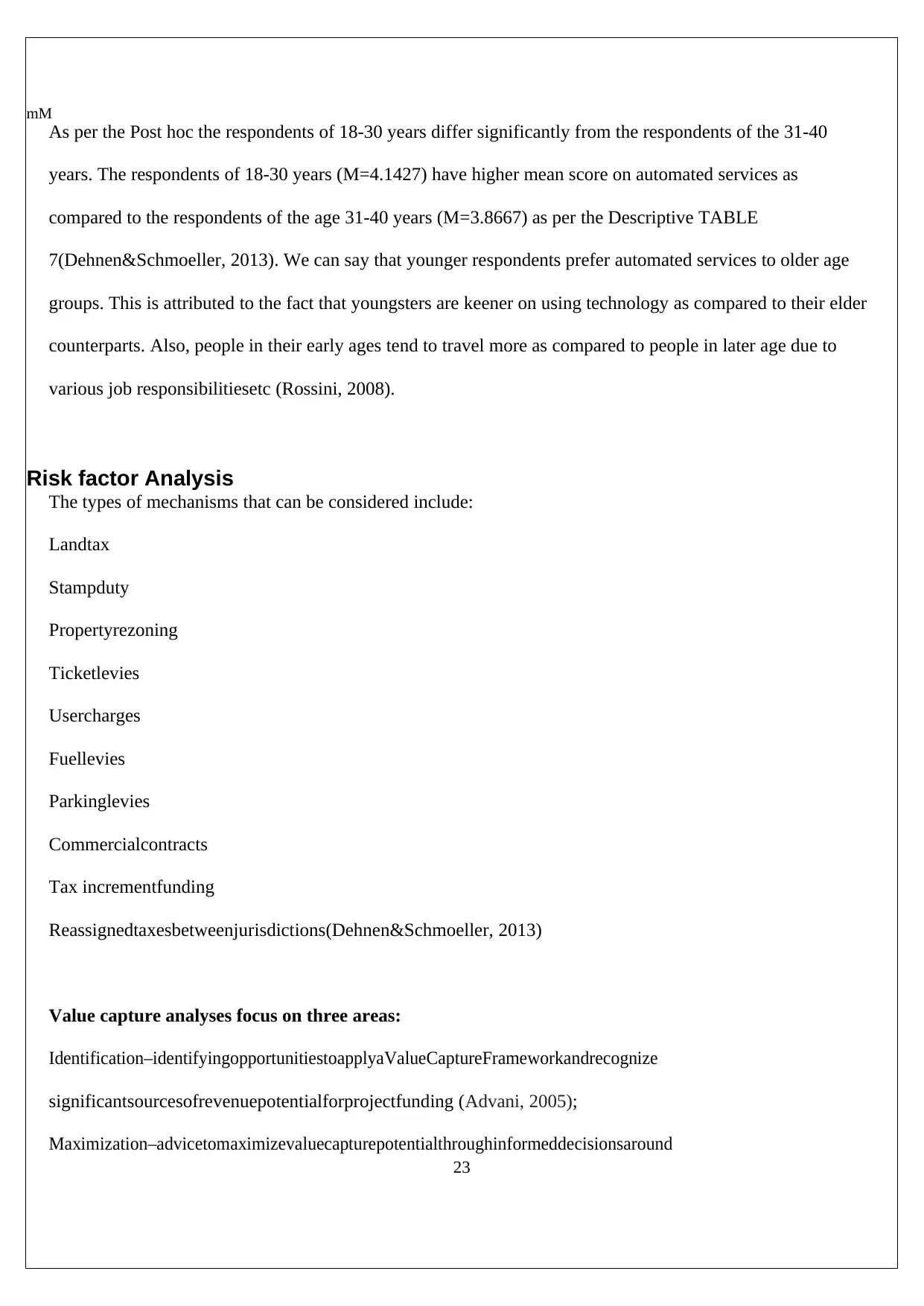
mM
As per the Post hoc the respondents of 18-30 years differ significantly from the respondents of the 31-40
years. The respondents of 18-30 years (M=4.1427) have higher mean score on automated services as
compared to the respondents of the age 31-40 years (M=3.8667) as per the Descriptive TABLE
7(Dehnen&Schmoeller, 2013). We can say that younger respondents prefer automated services to older age
groups. This is attributed to the fact that youngsters are keener on using technology as compared to their elder
counterparts. Also, people in their early ages tend to travel more as compared to people in later age due to
various job responsibilitiesetc (Rossini, 2008).
Risk factor Analysis
The types of mechanisms that can be considered include:
Landtax
Stampduty
Propertyrezoning
Ticketlevies
Usercharges
Fuellevies
Parkinglevies
Commercialcontracts
Tax incrementfunding
Reassignedtaxesbetweenjurisdictions(Dehnen&Schmoeller, 2013)
Value capture analyses focus on three areas:
Identification–identifyingopportunitiestoapplyaValueCaptureFrameworkandrecognize
significantsourcesofrevenuepotentialforprojectfunding (Advani, 2005);
Maximization–advicetomaximizevaluecapturepotentialthroughinformeddecisionsaround
23
As per the Post hoc the respondents of 18-30 years differ significantly from the respondents of the 31-40
years. The respondents of 18-30 years (M=4.1427) have higher mean score on automated services as
compared to the respondents of the age 31-40 years (M=3.8667) as per the Descriptive TABLE
7(Dehnen&Schmoeller, 2013). We can say that younger respondents prefer automated services to older age
groups. This is attributed to the fact that youngsters are keener on using technology as compared to their elder
counterparts. Also, people in their early ages tend to travel more as compared to people in later age due to
various job responsibilitiesetc (Rossini, 2008).
Risk factor Analysis
The types of mechanisms that can be considered include:
Landtax
Stampduty
Propertyrezoning
Ticketlevies
Usercharges
Fuellevies
Parkinglevies
Commercialcontracts
Tax incrementfunding
Reassignedtaxesbetweenjurisdictions(Dehnen&Schmoeller, 2013)
Value capture analyses focus on three areas:
Identification–identifyingopportunitiestoapplyaValueCaptureFrameworkandrecognize
significantsourcesofrevenuepotentialforprojectfunding (Advani, 2005);
Maximization–advicetomaximizevaluecapturepotentialthroughinformeddecisionsaround
23
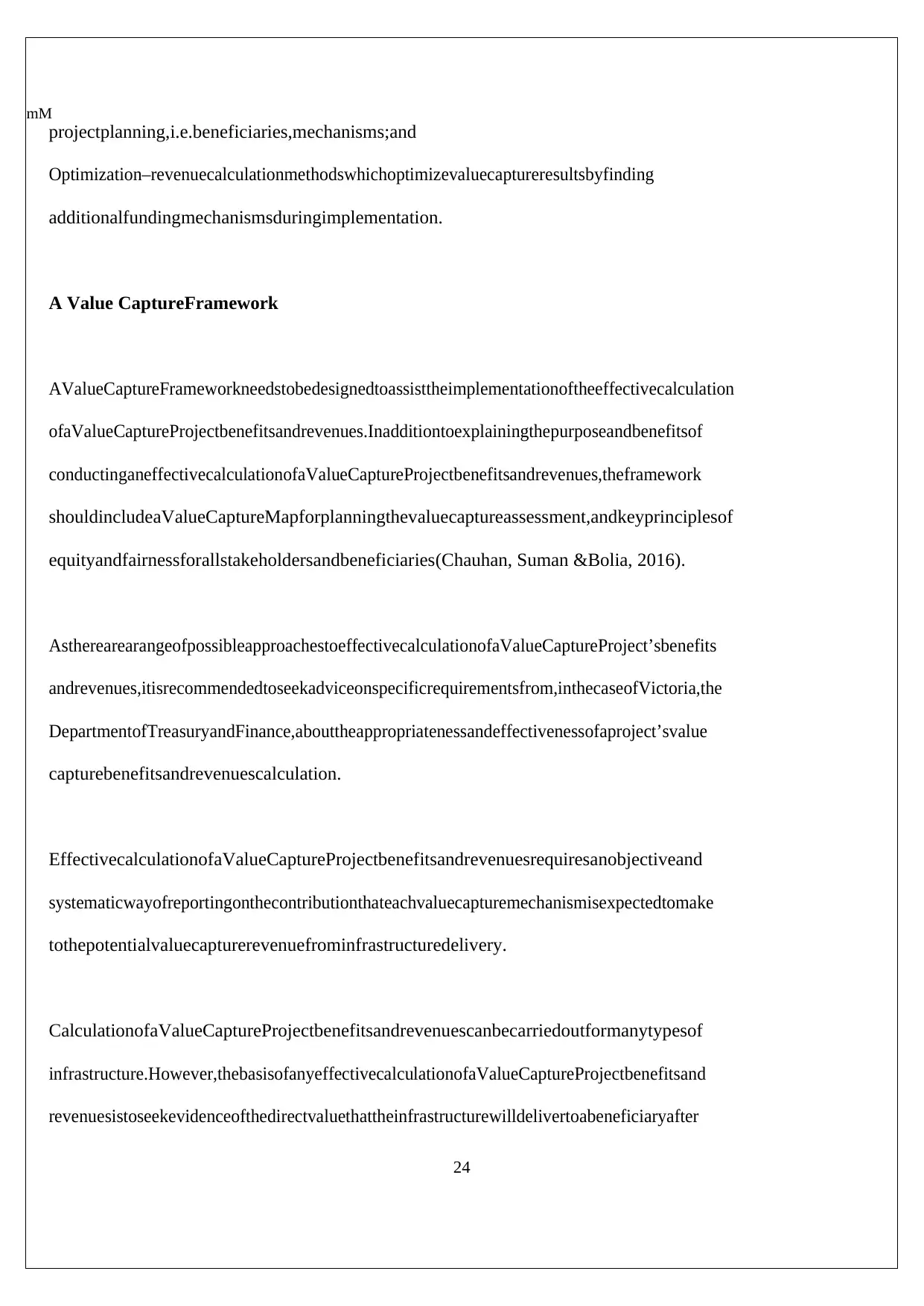
mM
projectplanning,i.e.beneficiaries,mechanisms;and
Optimization–revenuecalculationmethodswhichoptimizevaluecaptureresultsbyfinding
additionalfundingmechanismsduringimplementation.
A Value CaptureFramework
AValueCaptureFrameworkneedstobedesignedtoassisttheimplementationoftheeffectivecalculation
ofaValueCaptureProjectbenefitsandrevenues.Inadditiontoexplainingthepurposeandbenefitsof
conductinganeffectivecalculationofaValueCaptureProjectbenefitsandrevenues,theframework
shouldincludeaValueCaptureMapforplanningthevaluecaptureassessment,andkeyprinciplesof
equityandfairnessforallstakeholdersandbeneficiaries(Chauhan, Suman &Bolia, 2016).
AstherearearangeofpossibleapproachestoeffectivecalculationofaValueCaptureProject’sbenefits
andrevenues,itisrecommendedtoseekadviceonspecificrequirementsfrom,inthecaseofVictoria,the
DepartmentofTreasuryandFinance,abouttheappropriatenessandeffectivenessofaproject’svalue
capturebenefitsandrevenuescalculation.
EffectivecalculationofaValueCaptureProjectbenefitsandrevenuesrequiresanobjectiveand
systematicwayofreportingonthecontributionthateachvaluecapturemechanismisexpectedtomake
tothepotentialvaluecapturerevenuefrominfrastructuredelivery.
CalculationofaValueCaptureProjectbenefitsandrevenuescanbecarriedoutformanytypesof
infrastructure.However,thebasisofanyeffectivecalculationofaValueCaptureProjectbenefitsand
revenuesistoseekevidenceofthedirectvaluethattheinfrastructurewilldelivertoabeneficiaryafter
24
projectplanning,i.e.beneficiaries,mechanisms;and
Optimization–revenuecalculationmethodswhichoptimizevaluecaptureresultsbyfinding
additionalfundingmechanismsduringimplementation.
A Value CaptureFramework
AValueCaptureFrameworkneedstobedesignedtoassisttheimplementationoftheeffectivecalculation
ofaValueCaptureProjectbenefitsandrevenues.Inadditiontoexplainingthepurposeandbenefitsof
conductinganeffectivecalculationofaValueCaptureProjectbenefitsandrevenues,theframework
shouldincludeaValueCaptureMapforplanningthevaluecaptureassessment,andkeyprinciplesof
equityandfairnessforallstakeholdersandbeneficiaries(Chauhan, Suman &Bolia, 2016).
AstherearearangeofpossibleapproachestoeffectivecalculationofaValueCaptureProject’sbenefits
andrevenues,itisrecommendedtoseekadviceonspecificrequirementsfrom,inthecaseofVictoria,the
DepartmentofTreasuryandFinance,abouttheappropriatenessandeffectivenessofaproject’svalue
capturebenefitsandrevenuescalculation.
EffectivecalculationofaValueCaptureProjectbenefitsandrevenuesrequiresanobjectiveand
systematicwayofreportingonthecontributionthateachvaluecapturemechanismisexpectedtomake
tothepotentialvaluecapturerevenuefrominfrastructuredelivery.
CalculationofaValueCaptureProjectbenefitsandrevenuescanbecarriedoutformanytypesof
infrastructure.However,thebasisofanyeffectivecalculationofaValueCaptureProjectbenefitsand
revenuesistoseekevidenceofthedirectvaluethattheinfrastructurewilldelivertoabeneficiaryafter
24
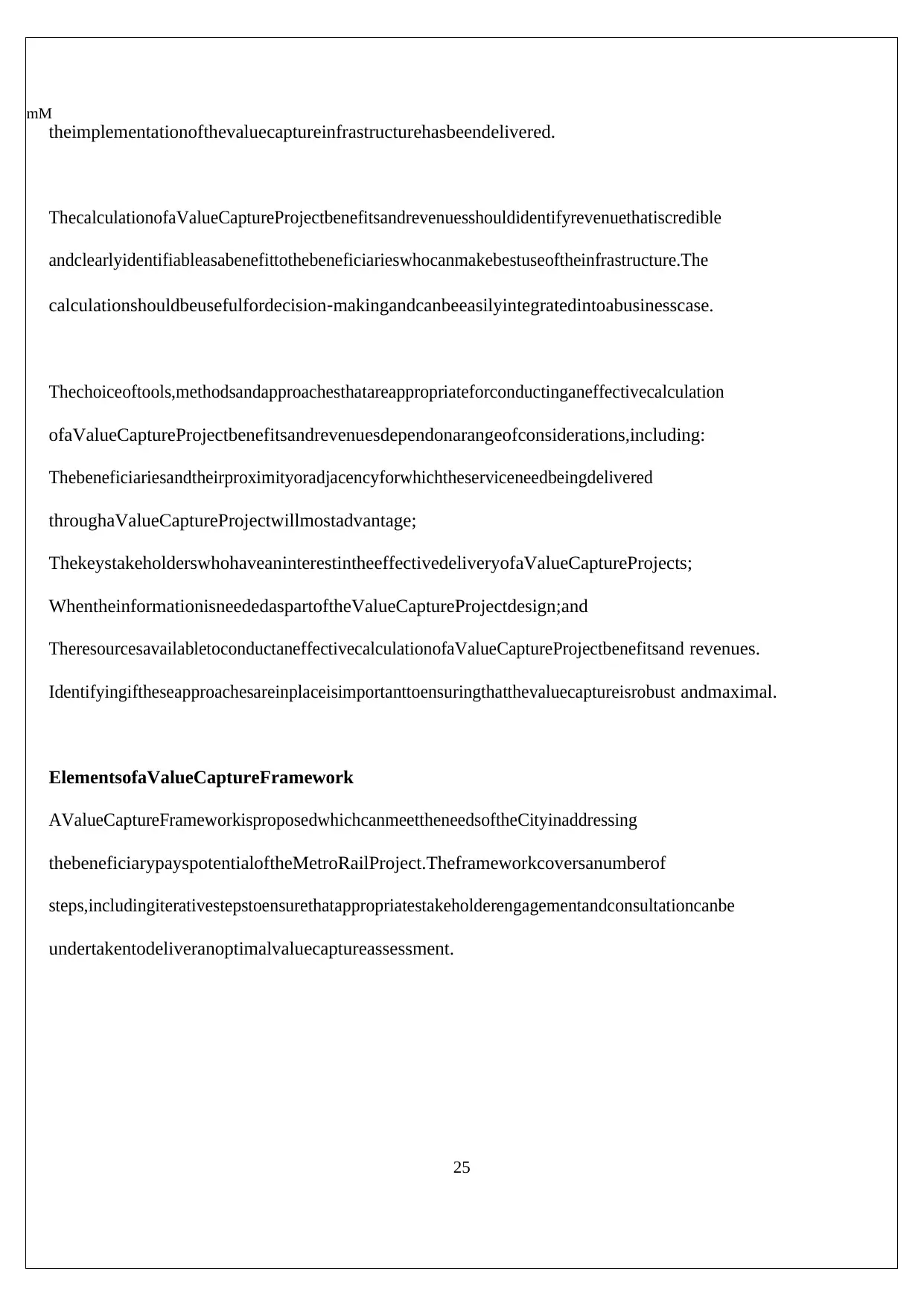
mM
theimplementationofthevaluecaptureinfrastructurehasbeendelivered.
ThecalculationofaValueCaptureProjectbenefitsandrevenuesshouldidentifyrevenuethatiscredible
andclearlyidentifiableasabenefittothebeneficiarieswhocanmakebestuseoftheinfrastructure.The
calculationshouldbeusefulfordecision‐makingandcanbeeasilyintegratedintoabusinesscase.
Thechoiceoftools,methodsandapproachesthatareappropriateforconductinganeffectivecalculation
ofaValueCaptureProjectbenefitsandrevenuesdependonarangeofconsiderations,including:
Thebeneficiariesandtheirproximityoradjacencyforwhichtheserviceneedbeingdelivered
throughaValueCaptureProjectwillmostadvantage;
ThekeystakeholderswhohaveaninterestintheeffectivedeliveryofaValueCaptureProjects;
WhentheinformationisneededaspartoftheValueCaptureProjectdesign;and
TheresourcesavailabletoconductaneffectivecalculationofaValueCaptureProjectbenefitsand revenues.
Identifyingiftheseapproachesareinplaceisimportanttoensuringthatthevaluecaptureisrobust andmaximal.
ElementsofaValueCaptureFramework
AValueCaptureFrameworkisproposedwhichcanmeettheneedsoftheCityinaddressing
thebeneficiarypayspotentialoftheMetroRailProject.Theframeworkcoversanumberof
steps,includingiterativestepstoensurethatappropriatestakeholderengagementandconsultationcanbe
undertakentodeliveranoptimalvaluecaptureassessment.
25
theimplementationofthevaluecaptureinfrastructurehasbeendelivered.
ThecalculationofaValueCaptureProjectbenefitsandrevenuesshouldidentifyrevenuethatiscredible
andclearlyidentifiableasabenefittothebeneficiarieswhocanmakebestuseoftheinfrastructure.The
calculationshouldbeusefulfordecision‐makingandcanbeeasilyintegratedintoabusinesscase.
Thechoiceoftools,methodsandapproachesthatareappropriateforconductinganeffectivecalculation
ofaValueCaptureProjectbenefitsandrevenuesdependonarangeofconsiderations,including:
Thebeneficiariesandtheirproximityoradjacencyforwhichtheserviceneedbeingdelivered
throughaValueCaptureProjectwillmostadvantage;
ThekeystakeholderswhohaveaninterestintheeffectivedeliveryofaValueCaptureProjects;
WhentheinformationisneededaspartoftheValueCaptureProjectdesign;and
TheresourcesavailabletoconductaneffectivecalculationofaValueCaptureProjectbenefitsand revenues.
Identifyingiftheseapproachesareinplaceisimportanttoensuringthatthevaluecaptureisrobust andmaximal.
ElementsofaValueCaptureFramework
AValueCaptureFrameworkisproposedwhichcanmeettheneedsoftheCityinaddressing
thebeneficiarypayspotentialoftheMetroRailProject.Theframeworkcoversanumberof
steps,includingiterativestepstoensurethatappropriatestakeholderengagementandconsultationcanbe
undertakentodeliveranoptimalvaluecaptureassessment.
25
Paraphrase This Document
Need a fresh take? Get an instant paraphrase of this document with our AI Paraphraser

Me
Figure3:ProposedValueCaptureFrameworktoassessbeneficiarypays
WhiletherearemanydifferentapproachestoeffectivecalculationofaValueCaptureProjectbenefitsand
revenues,therearefourstagescommontoall:
AValueCaptureContextAssessment:determiningwhatsortofevidenceneedstobecollected,and
howitwillbecollectedandused;
BenefitsandOpportunitiesMapping:scopingthecontextofthepotentialinfrastructure,whowill
benefit,andwhatopportunitiesneedtobeevaluated;
Calculationofavaluecapturerevenuestream:collectingtheevidencefordirectandpartialvalue uplift for all beneficiaries,
analyzing and assessing the value captured and making recommendations;and
DisseminatingtheValueCaptureProjectbenefitsandrevenues:usingthefindingsand
recommendationstoensurethereisadirectbenefittothebeneficiaries.
Figure4describestheelementsofaValueCaptureFrameworkrequiredtoenableallpartiestounderstand
thevaluecaptureopportunitiesandprovideoptionsforalternativefundingoutcomes.
Elements of a Value Capture Framework
26
Figure3:ProposedValueCaptureFrameworktoassessbeneficiarypays
WhiletherearemanydifferentapproachestoeffectivecalculationofaValueCaptureProjectbenefitsand
revenues,therearefourstagescommontoall:
AValueCaptureContextAssessment:determiningwhatsortofevidenceneedstobecollected,and
howitwillbecollectedandused;
BenefitsandOpportunitiesMapping:scopingthecontextofthepotentialinfrastructure,whowill
benefit,andwhatopportunitiesneedtobeevaluated;
Calculationofavaluecapturerevenuestream:collectingtheevidencefordirectandpartialvalue uplift for all beneficiaries,
analyzing and assessing the value captured and making recommendations;and
DisseminatingtheValueCaptureProjectbenefitsandrevenues:usingthefindingsand
recommendationstoensurethereisadirectbenefittothebeneficiaries.
Figure4describestheelementsofaValueCaptureFrameworkrequiredtoenableallpartiestounderstand
thevaluecaptureopportunitiesandprovideoptionsforalternativefundingoutcomes.
Elements of a Value Capture Framework
26

Me
Assessment Purpose
Context ofthe
ValueCapture
Project
Understandthecurrentcontextandbaselinecharacteristicoftheareaofthe
projectsiteandthebroadersurroundingarea.
DetailtheissuesandchallengesforcreatingvalueinandaroundtheValue
CaptureProjectandthesurroundingarea;and
HighlightgapsinTransportandCommunityConnectivity,Generaland
CommunityAmenities,PropertyDevelopmentsandCommercialOutcomes
thatcanbeincludedwithintheValueCaptureProject.
Value Capture
Benefits and
Opportunities
ToidentifyspecificValueCaptureopportunitiesthatcanbecreatedand
deliveredaspartoforalongsidetheproposedinfrastructuretomeetthe serviceneed.
TheContextprovidesexamplesoftheanticipatedopportunitiesandbenefits
thatcouldbedeliveredaspartofaValueCaptureProject.Thelocation,size
andnatureofagivenprojectwillverymuchdeterminethetypeofbenefits
andthedirectand/orindirectnatureofthosebenefits.
ForeverybenefitidentifiedaspotentiallycreatedbyaValueCaptureProject,
it is necessary to identify the relevant beneficiary.
ContextoftheValueCaptureProject
AnassessmentoftheprojectcontextcanprovideaunifyingplatformtoworkshoptheValueCapture
opportunitiesbeingconsidered,andthepotentialtocreateothers,fromtheDMRP.TheContext
Assessmentisakeybuildingblocktounderstandingthebenefitsthatcanbedelivered,eitheron‐siteas
partoftheinfrastructuretobedelivered,orfurtherafieldasanoutcometriggeredbytheinfrastructure(Chauhan, Suman
&Bolia, 2016) . ThescopeoftheContextAssessmentcaninclude:
27
Assessment Purpose
Context ofthe
ValueCapture
Project
Understandthecurrentcontextandbaselinecharacteristicoftheareaofthe
projectsiteandthebroadersurroundingarea.
DetailtheissuesandchallengesforcreatingvalueinandaroundtheValue
CaptureProjectandthesurroundingarea;and
HighlightgapsinTransportandCommunityConnectivity,Generaland
CommunityAmenities,PropertyDevelopmentsandCommercialOutcomes
thatcanbeincludedwithintheValueCaptureProject.
Value Capture
Benefits and
Opportunities
ToidentifyspecificValueCaptureopportunitiesthatcanbecreatedand
deliveredaspartoforalongsidetheproposedinfrastructuretomeetthe serviceneed.
TheContextprovidesexamplesoftheanticipatedopportunitiesandbenefits
thatcouldbedeliveredaspartofaValueCaptureProject.Thelocation,size
andnatureofagivenprojectwillverymuchdeterminethetypeofbenefits
andthedirectand/orindirectnatureofthosebenefits.
ForeverybenefitidentifiedaspotentiallycreatedbyaValueCaptureProject,
it is necessary to identify the relevant beneficiary.
ContextoftheValueCaptureProject
AnassessmentoftheprojectcontextcanprovideaunifyingplatformtoworkshoptheValueCapture
opportunitiesbeingconsidered,andthepotentialtocreateothers,fromtheDMRP.TheContext
Assessmentisakeybuildingblocktounderstandingthebenefitsthatcanbedelivered,eitheron‐siteas
partoftheinfrastructuretobedelivered,orfurtherafieldasanoutcometriggeredbytheinfrastructure(Chauhan, Suman
&Bolia, 2016) . ThescopeoftheContextAssessmentcaninclude:
27
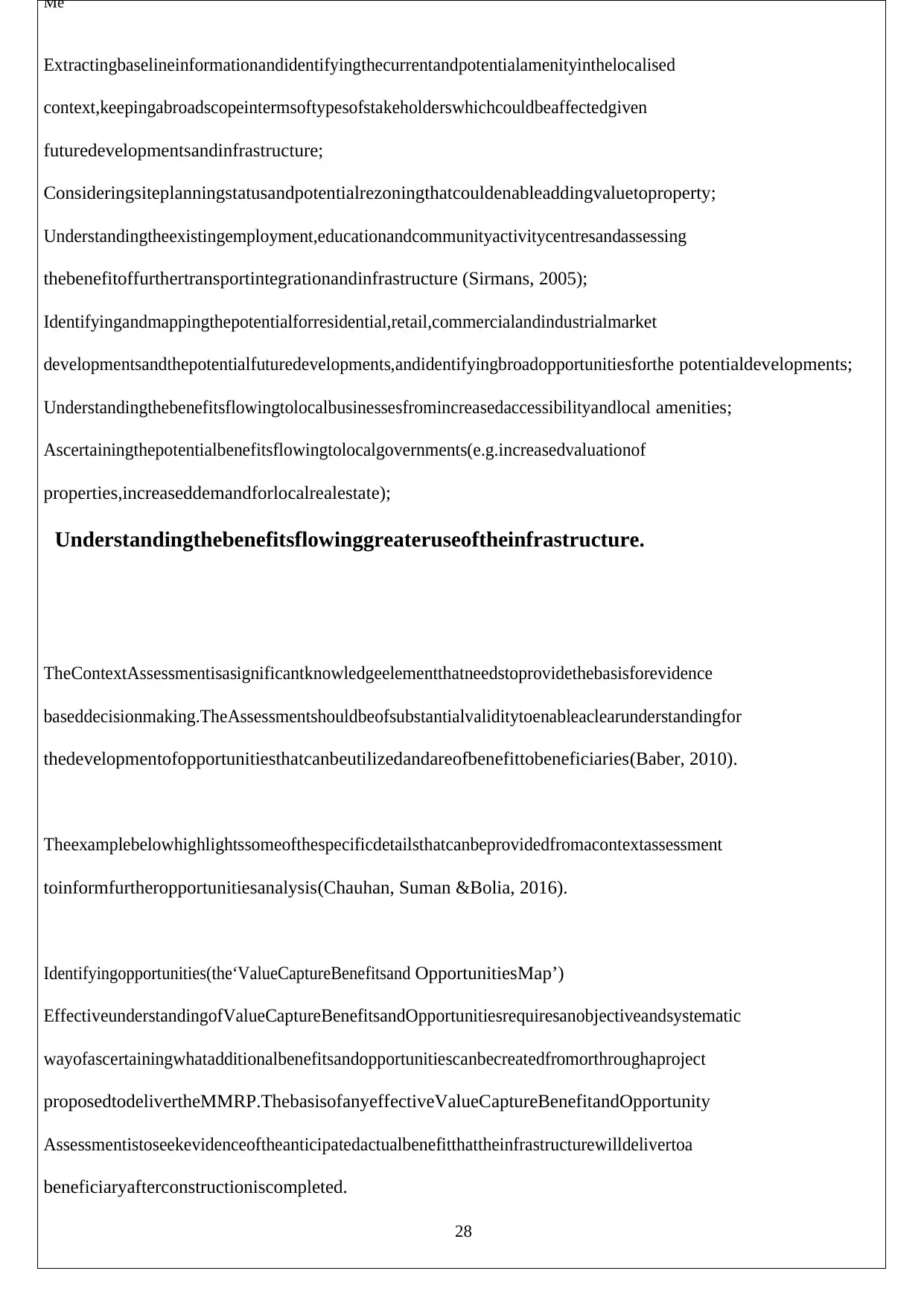
Me
Extractingbaselineinformationandidentifyingthecurrentandpotentialamenityinthelocalised
context,keepingabroadscopeintermsoftypesofstakeholderswhichcouldbeaffectedgiven
futuredevelopmentsandinfrastructure;
Consideringsiteplanningstatusandpotentialrezoningthatcouldenableaddingvaluetoproperty;
Understandingtheexistingemployment,educationandcommunityactivitycentresandassessing
thebenefitoffurthertransportintegrationandinfrastructure (Sirmans, 2005);
Identifyingandmappingthepotentialforresidential,retail,commercialandindustrialmarket
developmentsandthepotentialfuturedevelopments,andidentifyingbroadopportunitiesforthe potentialdevelopments;
Understandingthebenefitsflowingtolocalbusinessesfromincreasedaccessibilityandlocal amenities;
Ascertainingthepotentialbenefitsflowingtolocalgovernments(e.g.increasedvaluationof
properties,increaseddemandforlocalrealestate);
Understandingthebenefitsflowinggreateruseoftheinfrastructure.
TheContextAssessmentisasignificantknowledgeelementthatneedstoprovidethebasisforevidence
baseddecisionmaking.TheAssessmentshouldbeofsubstantialvaliditytoenableaclearunderstandingfor
thedevelopmentofopportunitiesthatcanbeutilizedandareofbenefittobeneficiaries(Baber, 2010).
Theexamplebelowhighlightssomeofthespecificdetailsthatcanbeprovidedfromacontextassessment
toinformfurtheropportunitiesanalysis(Chauhan, Suman &Bolia, 2016).
Identifyingopportunities(the‘ValueCaptureBenefitsand OpportunitiesMap’)
EffectiveunderstandingofValueCaptureBenefitsandOpportunitiesrequiresanobjectiveandsystematic
wayofascertainingwhatadditionalbenefitsandopportunitiescanbecreatedfromorthroughaproject
proposedtodelivertheMMRP.ThebasisofanyeffectiveValueCaptureBenefitandOpportunity
Assessmentistoseekevidenceoftheanticipatedactualbenefitthattheinfrastructurewilldelivertoa
beneficiaryafterconstructioniscompleted.
28
Extractingbaselineinformationandidentifyingthecurrentandpotentialamenityinthelocalised
context,keepingabroadscopeintermsoftypesofstakeholderswhichcouldbeaffectedgiven
futuredevelopmentsandinfrastructure;
Consideringsiteplanningstatusandpotentialrezoningthatcouldenableaddingvaluetoproperty;
Understandingtheexistingemployment,educationandcommunityactivitycentresandassessing
thebenefitoffurthertransportintegrationandinfrastructure (Sirmans, 2005);
Identifyingandmappingthepotentialforresidential,retail,commercialandindustrialmarket
developmentsandthepotentialfuturedevelopments,andidentifyingbroadopportunitiesforthe potentialdevelopments;
Understandingthebenefitsflowingtolocalbusinessesfromincreasedaccessibilityandlocal amenities;
Ascertainingthepotentialbenefitsflowingtolocalgovernments(e.g.increasedvaluationof
properties,increaseddemandforlocalrealestate);
Understandingthebenefitsflowinggreateruseoftheinfrastructure.
TheContextAssessmentisasignificantknowledgeelementthatneedstoprovidethebasisforevidence
baseddecisionmaking.TheAssessmentshouldbeofsubstantialvaliditytoenableaclearunderstandingfor
thedevelopmentofopportunitiesthatcanbeutilizedandareofbenefittobeneficiaries(Baber, 2010).
Theexamplebelowhighlightssomeofthespecificdetailsthatcanbeprovidedfromacontextassessment
toinformfurtheropportunitiesanalysis(Chauhan, Suman &Bolia, 2016).
Identifyingopportunities(the‘ValueCaptureBenefitsand OpportunitiesMap’)
EffectiveunderstandingofValueCaptureBenefitsandOpportunitiesrequiresanobjectiveandsystematic
wayofascertainingwhatadditionalbenefitsandopportunitiescanbecreatedfromorthroughaproject
proposedtodelivertheMMRP.ThebasisofanyeffectiveValueCaptureBenefitandOpportunity
Assessmentistoseekevidenceoftheanticipatedactualbenefitthattheinfrastructurewilldelivertoa
beneficiaryafterconstructioniscompleted.
28
Secure Best Marks with AI Grader
Need help grading? Try our AI Grader for instant feedback on your assignments.
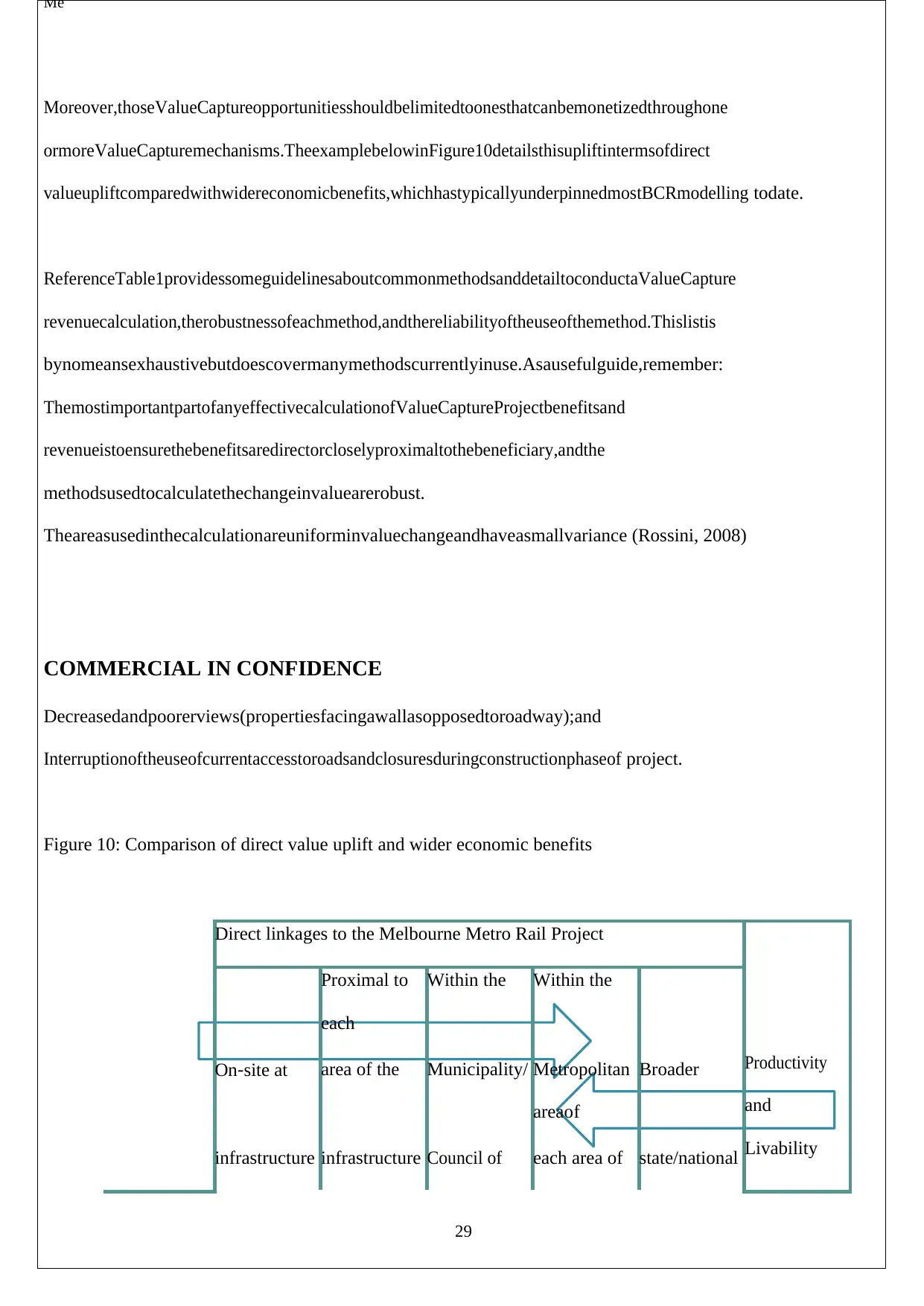
Me
Moreover,thoseValueCaptureopportunitiesshouldbelimitedtoonesthatcanbemonetizedthroughone
ormoreValueCapturemechanisms.TheexamplebelowinFigure10detailsthisupliftintermsofdirect
valueupliftcomparedwithwidereconomicbenefits,whichhastypicallyunderpinnedmostBCRmodelling todate.
ReferenceTable1providessomeguidelinesaboutcommonmethodsanddetailtoconductaValueCapture
revenuecalculation,therobustnessofeachmethod,andthereliabilityoftheuseofthemethod.Thislistis
bynomeansexhaustivebutdoescovermanymethodscurrentlyinuse.Asausefulguide,remember:
ThemostimportantpartofanyeffectivecalculationofValueCaptureProjectbenefitsand
revenueistoensurethebenefitsaredirectorcloselyproximaltothebeneficiary,andthe
methodsusedtocalculatethechangeinvaluearerobust.
Theareasusedinthecalculationareuniforminvaluechangeandhaveasmallvariance (Rossini, 2008)
COMMERCIAL IN CONFIDENCE
Decreasedandpoorerviews(propertiesfacingawallasopposedtoroadway);and
Interruptionoftheuseofcurrentaccesstoroadsandclosuresduringconstructionphaseof project.
Figure 10: Comparison of direct value uplift and wider economic benefits
Direct linkages to the Melbourne Metro Rail Project
Productivity
and
Livability
Proximal to
each
Within the Within the
On‐site at area of the Municipality/ Metropolitan
areaof
Broader
infrastructure infrastructure Council of each area of state/national
29
Moreover,thoseValueCaptureopportunitiesshouldbelimitedtoonesthatcanbemonetizedthroughone
ormoreValueCapturemechanisms.TheexamplebelowinFigure10detailsthisupliftintermsofdirect
valueupliftcomparedwithwidereconomicbenefits,whichhastypicallyunderpinnedmostBCRmodelling todate.
ReferenceTable1providessomeguidelinesaboutcommonmethodsanddetailtoconductaValueCapture
revenuecalculation,therobustnessofeachmethod,andthereliabilityoftheuseofthemethod.Thislistis
bynomeansexhaustivebutdoescovermanymethodscurrentlyinuse.Asausefulguide,remember:
ThemostimportantpartofanyeffectivecalculationofValueCaptureProjectbenefitsand
revenueistoensurethebenefitsaredirectorcloselyproximaltothebeneficiary,andthe
methodsusedtocalculatethechangeinvaluearerobust.
Theareasusedinthecalculationareuniforminvaluechangeandhaveasmallvariance (Rossini, 2008)
COMMERCIAL IN CONFIDENCE
Decreasedandpoorerviews(propertiesfacingawallasopposedtoroadway);and
Interruptionoftheuseofcurrentaccesstoroadsandclosuresduringconstructionphaseof project.
Figure 10: Comparison of direct value uplift and wider economic benefits
Direct linkages to the Melbourne Metro Rail Project
Productivity
and
Livability
Proximal to
each
Within the Within the
On‐site at area of the Municipality/ Metropolitan
areaof
Broader
infrastructure infrastructure Council of each area of state/national
29
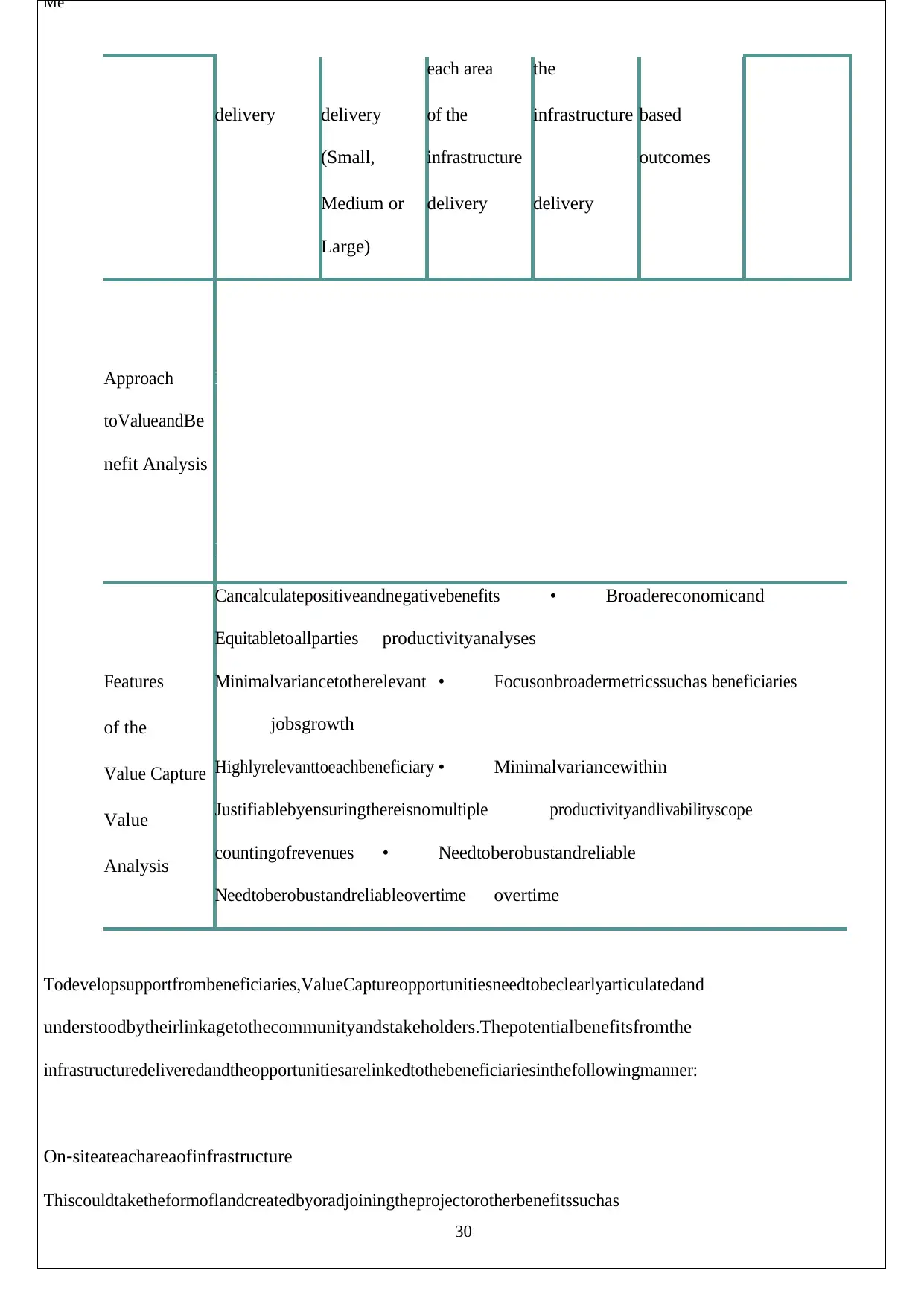
Me
each area the
delivery delivery
(Small,
of the
infrastructure
infrastructure based
outcomes
Medium or
Large)
delivery delivery
Approach
toValueandBe
nefit Analysis
Direct value uplift
Economic benefitand transport models
Features
Cancalculatepositiveandnegativebenefits • Broadereconomicand
Equitabletoallparties productivityanalyses
Minimalvariancetotherelevant • Focusonbroadermetricssuchas beneficiaries
jobsgrowth
Highlyrelevanttoeachbeneficiary • Minimalvariancewithin
Justifiablebyensuringthereisnomultiple productivityandlivabilityscope
countingofrevenues • Needtoberobustandreliable
Needtoberobustandreliableovertime overtime
of the
Value Capture
Value
Analysis
Todevelopsupportfrombeneficiaries,ValueCaptureopportunitiesneedtobeclearlyarticulatedand
understoodbytheirlinkagetothecommunityandstakeholders.Thepotentialbenefitsfromthe
infrastructuredeliveredandtheopportunitiesarelinkedtothebeneficiariesinthefollowingmanner:
On‐siteateachareaofinfrastructure
Thiscouldtaketheformoflandcreatedbyoradjoiningtheprojectorotherbenefitssuchas
30
each area the
delivery delivery
(Small,
of the
infrastructure
infrastructure based
outcomes
Medium or
Large)
delivery delivery
Approach
toValueandBe
nefit Analysis
Direct value uplift
Economic benefitand transport models
Features
Cancalculatepositiveandnegativebenefits • Broadereconomicand
Equitabletoallparties productivityanalyses
Minimalvariancetotherelevant • Focusonbroadermetricssuchas beneficiaries
jobsgrowth
Highlyrelevanttoeachbeneficiary • Minimalvariancewithin
Justifiablebyensuringthereisnomultiple productivityandlivabilityscope
countingofrevenues • Needtoberobustandreliable
Needtoberobustandreliableovertime overtime
of the
Value Capture
Value
Analysis
Todevelopsupportfrombeneficiaries,ValueCaptureopportunitiesneedtobeclearlyarticulatedand
understoodbytheirlinkagetothecommunityandstakeholders.Thepotentialbenefitsfromthe
infrastructuredeliveredandtheopportunitiesarelinkedtothebeneficiariesinthefollowingmanner:
On‐siteateachareaofinfrastructure
Thiscouldtaketheformoflandcreatedbyoradjoiningtheprojectorotherbenefitssuchas
30

Me
advertisingorotherinfrastructureorservicesthatcouldbedeliveredaspartoftheproject.
Benefitcreatedthroughdirectconnectiontotheinfrastructureproject.
Thesebenefitsmightrequireinterventionssuchasrezoning,deliveryofairrightsabove
existingland,deliveryofplatformstocreatenewland,etc.
Benefitsrelatingtoon‐siteimprovements.ThiscanincludeGeneralandCommunityAmenities and/or safety improvements,
improved accessibility and/or the provision of additional services associatedwiththesiteoftheinfrastructuredelivery.
Proximaltoeachareaoftheinfrastructuredelivery(Small,MediumorLarge)
Propertywithintheapproximatearea(butnotpartoftheproject)thatreceivesabenefitfrom theinfrastructurebeingdelivered.
Thisbenefitcanandoftendoesaccrueinincreasingvalueduringthetimethatthe
infrastructureisproposed,thenplannedandthendelivered.
TherecanbemultiplebenefitsfromValueCaptureopportunitiesrelatingtoplace,transportand
communityamenityandconnectivitydeliveredwithoraspartofthetransportprojectmeetingtheneeds of allstakeholders.
Value Capture Benefits and Opportunities Map
TheContextAssessmentisnecessarytodefineandcategorizethepotentialopportunitieswhichcanbeon‐
site,proximaltothesite,atabroadermunicipallevel,orevenametropolitanorstatelevel,thatexhibita
connectiontotheinfrastructureprovidedandwhicharecapableofbeingconvertedintorevenuestreams
fromidentifiablebeneficiaries.
EFFECT OF GENDER ON VARIOUS FACTORS OF
PREFERENCE TOWARDS METRO
H02: There is no significant difference between the mean scores of various factors of preference towards metro
for different genders
31
advertisingorotherinfrastructureorservicesthatcouldbedeliveredaspartoftheproject.
Benefitcreatedthroughdirectconnectiontotheinfrastructureproject.
Thesebenefitsmightrequireinterventionssuchasrezoning,deliveryofairrightsabove
existingland,deliveryofplatformstocreatenewland,etc.
Benefitsrelatingtoon‐siteimprovements.ThiscanincludeGeneralandCommunityAmenities and/or safety improvements,
improved accessibility and/or the provision of additional services associatedwiththesiteoftheinfrastructuredelivery.
Proximaltoeachareaoftheinfrastructuredelivery(Small,MediumorLarge)
Propertywithintheapproximatearea(butnotpartoftheproject)thatreceivesabenefitfrom theinfrastructurebeingdelivered.
Thisbenefitcanandoftendoesaccrueinincreasingvalueduringthetimethatthe
infrastructureisproposed,thenplannedandthendelivered.
TherecanbemultiplebenefitsfromValueCaptureopportunitiesrelatingtoplace,transportand
communityamenityandconnectivitydeliveredwithoraspartofthetransportprojectmeetingtheneeds of allstakeholders.
Value Capture Benefits and Opportunities Map
TheContextAssessmentisnecessarytodefineandcategorizethepotentialopportunitieswhichcanbeon‐
site,proximaltothesite,atabroadermunicipallevel,orevenametropolitanorstatelevel,thatexhibita
connectiontotheinfrastructureprovidedandwhicharecapableofbeingconvertedintorevenuestreams
fromidentifiablebeneficiaries.
EFFECT OF GENDER ON VARIOUS FACTORS OF
PREFERENCE TOWARDS METRO
H02: There is no significant difference between the mean scores of various factors of preference towards metro
for different genders
31
Paraphrase This Document
Need a fresh take? Get an instant paraphrase of this document with our AI Paraphraser

Me
TABLE 8: T-Table of Gender and various factors of preference towards metro
Levene's Test
for Equality of
Variances t-test for Equality of Means
F Sig. t df
Sig. (2-
tailed)
Mean
Differe
nce
Std. Error
Differen
ce
Travelling
Convenience
Equal
variancesassu
med
0.039 0.84
4
-0.394 599 0.694 -0.0259 0.0658
Facilities for
Commuters
Equal
variances not
assumed
-0.393 553.2 0.694 -0.0259 0.06588
Safety
Measures for
Commuters
Equal
variancesassu
med
1.645 0.2 -1.062 599 0.289 -0.0806 0.07588
Ease of Travel
Equal
variances not
assumed
-1.069 568.67 0.286 -0.0806 0.07537
32
TABLE 8: T-Table of Gender and various factors of preference towards metro
Levene's Test
for Equality of
Variances t-test for Equality of Means
F Sig. t df
Sig. (2-
tailed)
Mean
Differe
nce
Std. Error
Differen
ce
Travelling
Convenience
Equal
variancesassu
med
0.039 0.84
4
-0.394 599 0.694 -0.0259 0.0658
Facilities for
Commuters
Equal
variances not
assumed
-0.393 553.2 0.694 -0.0259 0.06588
Safety
Measures for
Commuters
Equal
variancesassu
med
1.645 0.2 -1.062 599 0.289 -0.0806 0.07588
Ease of Travel
Equal
variances not
assumed
-1.069 568.67 0.286 -0.0806 0.07537
32
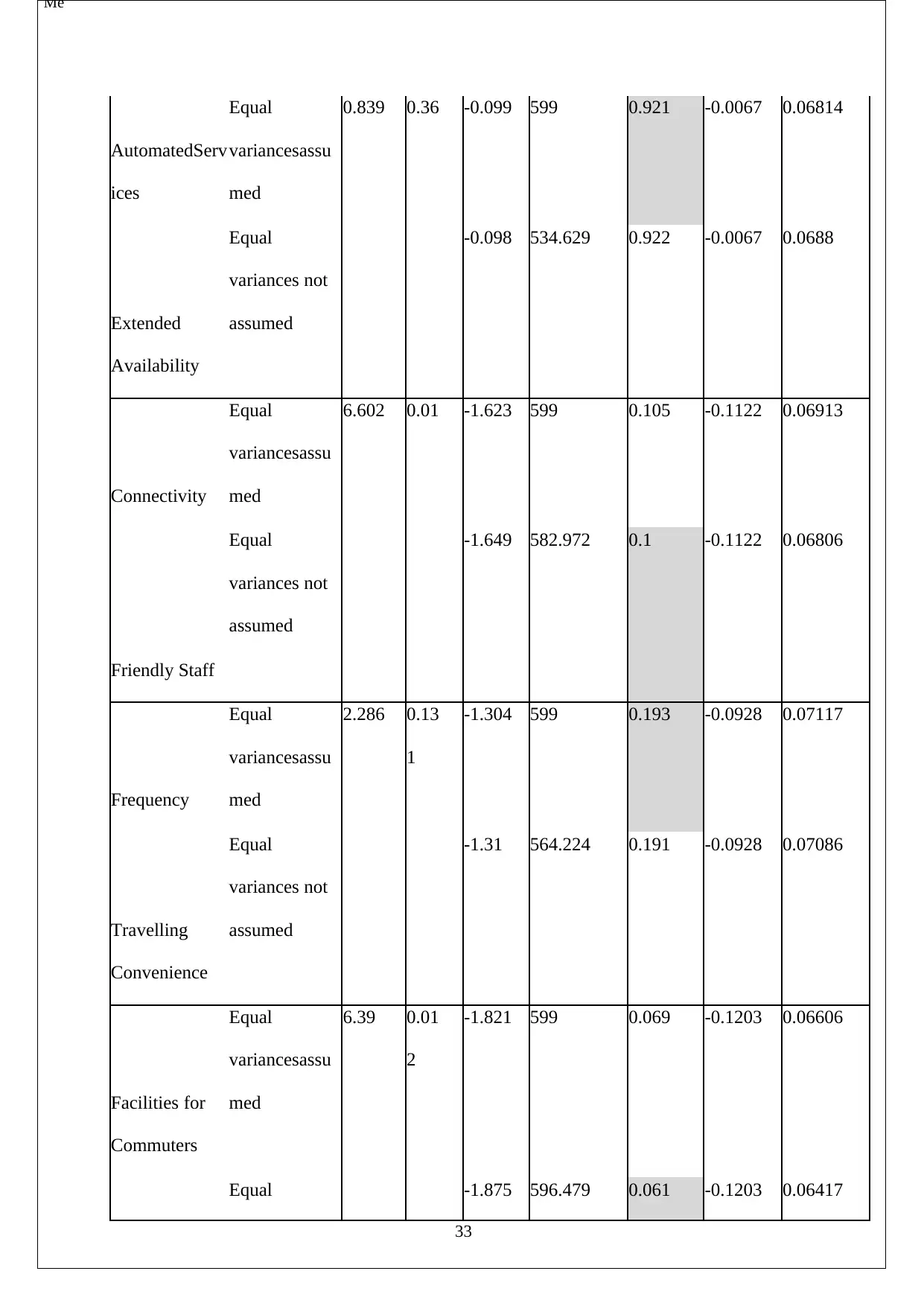
Me
AutomatedServ
ices
Equal
variancesassu
med
0.839 0.36 -0.099 599 0.921 -0.0067 0.06814
Extended
Availability
Equal
variances not
assumed
-0.098 534.629 0.922 -0.0067 0.0688
Connectivity
Equal
variancesassu
med
6.602 0.01 -1.623 599 0.105 -0.1122 0.06913
Equal
variances not
assumed
-1.649 582.972 0.1 -0.1122 0.06806
Friendly Staff
Frequency
Equal
variancesassu
med
2.286 0.13
1
-1.304 599 0.193 -0.0928 0.07117
Travelling
Convenience
Equal
variances not
assumed
-1.31 564.224 0.191 -0.0928 0.07086
Facilities for
Commuters
Equal
variancesassu
med
6.39 0.01
2
-1.821 599 0.069 -0.1203 0.06606
Equal -1.875 596.479 0.061 -0.1203 0.06417
33
AutomatedServ
ices
Equal
variancesassu
med
0.839 0.36 -0.099 599 0.921 -0.0067 0.06814
Extended
Availability
Equal
variances not
assumed
-0.098 534.629 0.922 -0.0067 0.0688
Connectivity
Equal
variancesassu
med
6.602 0.01 -1.623 599 0.105 -0.1122 0.06913
Equal
variances not
assumed
-1.649 582.972 0.1 -0.1122 0.06806
Friendly Staff
Frequency
Equal
variancesassu
med
2.286 0.13
1
-1.304 599 0.193 -0.0928 0.07117
Travelling
Convenience
Equal
variances not
assumed
-1.31 564.224 0.191 -0.0928 0.07086
Facilities for
Commuters
Equal
variancesassu
med
6.39 0.01
2
-1.821 599 0.069 -0.1203 0.06606
Equal -1.875 596.479 0.061 -0.1203 0.06417
33
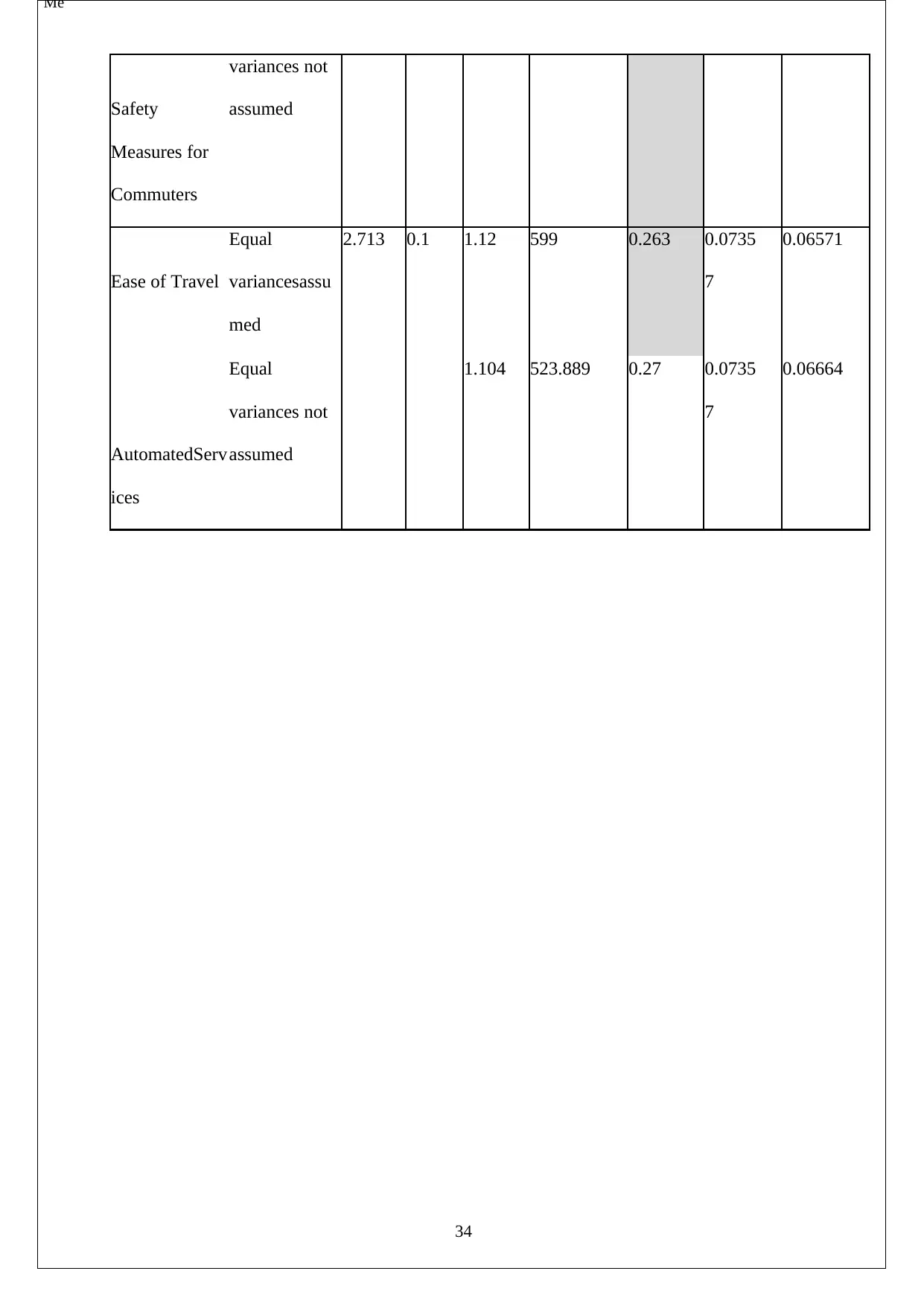
Me
Safety
Measures for
Commuters
variances not
assumed
Ease of Travel
Equal
variancesassu
med
2.713 0.1 1.12 599 0.263 0.0735
7
0.06571
AutomatedServ
ices
Equal
variances not
assumed
1.104 523.889 0.27 0.0735
7
0.06664
34
Safety
Measures for
Commuters
variances not
assumed
Ease of Travel
Equal
variancesassu
med
2.713 0.1 1.12 599 0.263 0.0735
7
0.06571
AutomatedServ
ices
Equal
variances not
assumed
1.104 523.889 0.27 0.0735
7
0.06664
34
Secure Best Marks with AI Grader
Need help grading? Try our AI Grader for instant feedback on your assignments.
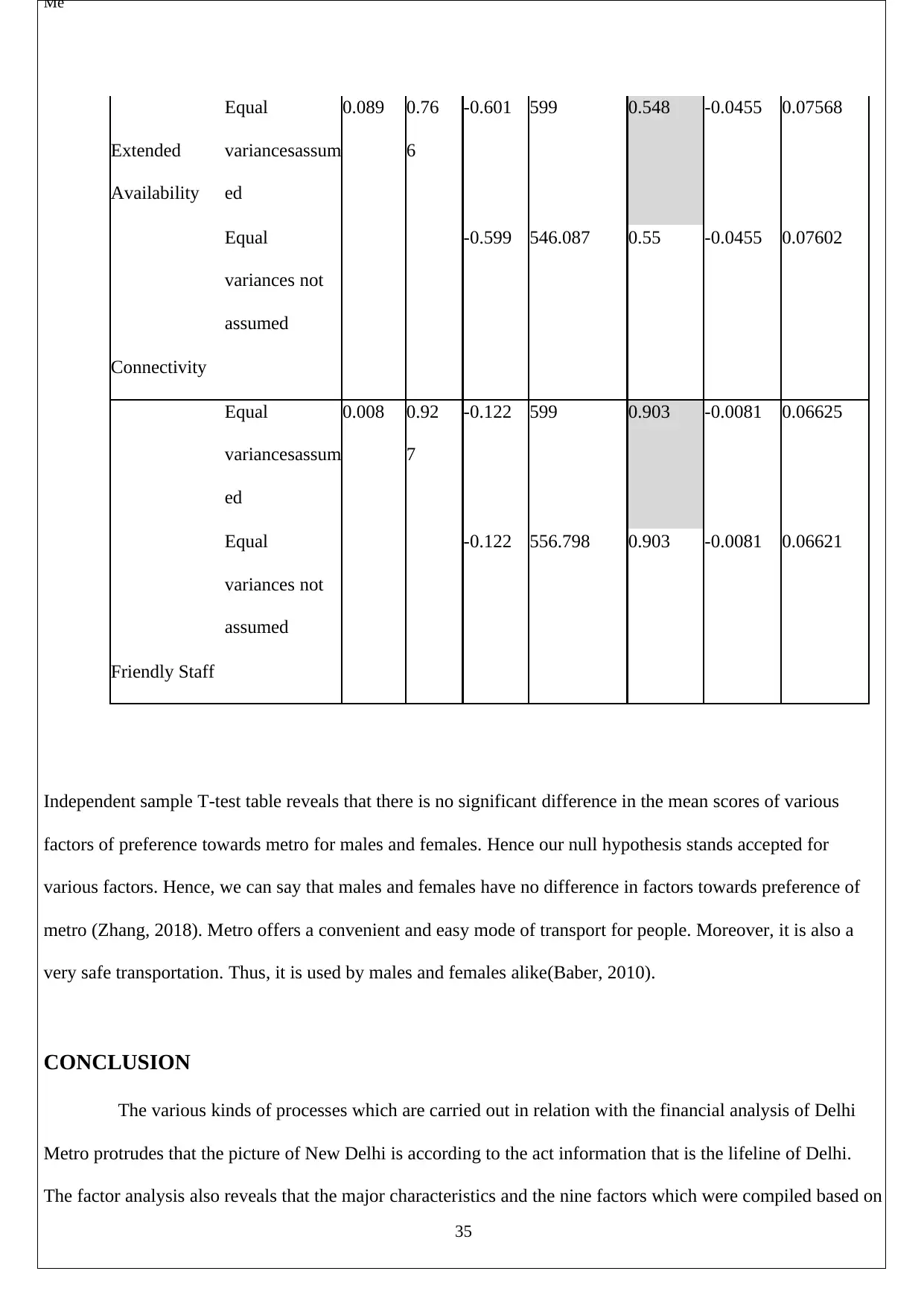
Me
Extended
Availability
Equal
variancesassum
ed
0.089 0.76
6
-0.601 599 0.548 -0.0455 0.07568
Equal
variances not
assumed
-0.599 546.087 0.55 -0.0455 0.07602
Connectivity
Equal
variancesassum
ed
0.008 0.92
7
-0.122 599 0.903 -0.0081 0.06625
Equal
variances not
assumed
-0.122 556.798 0.903 -0.0081 0.06621
Friendly Staff
Independent sample T-test table reveals that there is no significant difference in the mean scores of various
factors of preference towards metro for males and females. Hence our null hypothesis stands accepted for
various factors. Hence, we can say that males and females have no difference in factors towards preference of
metro (Zhang, 2018). Metro offers a convenient and easy mode of transport for people. Moreover, it is also a
very safe transportation. Thus, it is used by males and females alike(Baber, 2010).
CONCLUSION
The various kinds of processes which are carried out in relation with the financial analysis of Delhi
Metro protrudes that the picture of New Delhi is according to the act information that is the lifeline of Delhi.
The factor analysis also reveals that the major characteristics and the nine factors which were compiled based on
35
Extended
Availability
Equal
variancesassum
ed
0.089 0.76
6
-0.601 599 0.548 -0.0455 0.07568
Equal
variances not
assumed
-0.599 546.087 0.55 -0.0455 0.07602
Connectivity
Equal
variancesassum
ed
0.008 0.92
7
-0.122 599 0.903 -0.0081 0.06625
Equal
variances not
assumed
-0.122 556.798 0.903 -0.0081 0.06621
Friendly Staff
Independent sample T-test table reveals that there is no significant difference in the mean scores of various
factors of preference towards metro for males and females. Hence our null hypothesis stands accepted for
various factors. Hence, we can say that males and females have no difference in factors towards preference of
metro (Zhang, 2018). Metro offers a convenient and easy mode of transport for people. Moreover, it is also a
very safe transportation. Thus, it is used by males and females alike(Baber, 2010).
CONCLUSION
The various kinds of processes which are carried out in relation with the financial analysis of Delhi
Metro protrudes that the picture of New Delhi is according to the act information that is the lifeline of Delhi.
The factor analysis also reveals that the major characteristics and the nine factors which were compiled based on
35
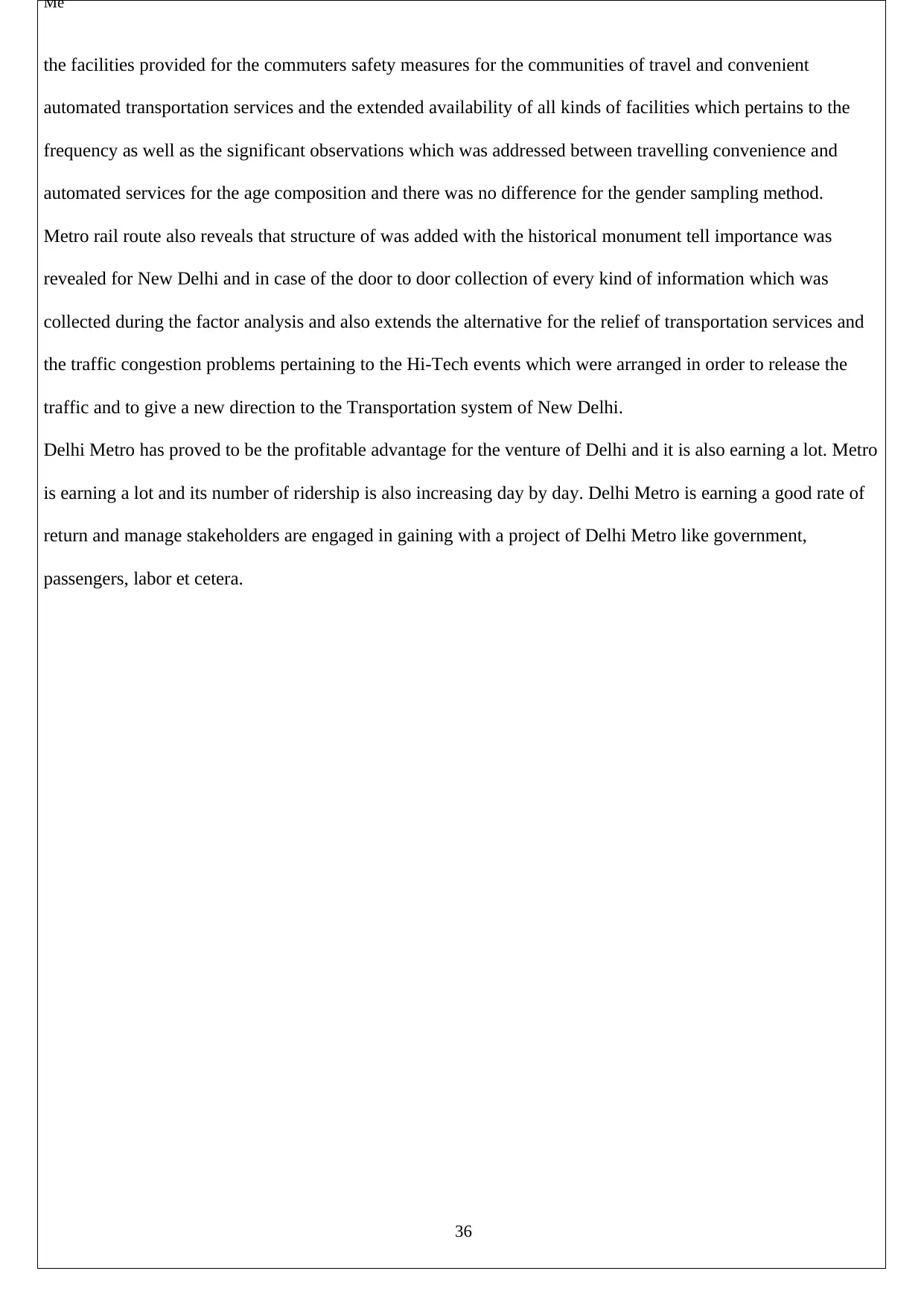
Me
the facilities provided for the commuters safety measures for the communities of travel and convenient
automated transportation services and the extended availability of all kinds of facilities which pertains to the
frequency as well as the significant observations which was addressed between travelling convenience and
automated services for the age composition and there was no difference for the gender sampling method.
Metro rail route also reveals that structure of was added with the historical monument tell importance was
revealed for New Delhi and in case of the door to door collection of every kind of information which was
collected during the factor analysis and also extends the alternative for the relief of transportation services and
the traffic congestion problems pertaining to the Hi-Tech events which were arranged in order to release the
traffic and to give a new direction to the Transportation system of New Delhi.
Delhi Metro has proved to be the profitable advantage for the venture of Delhi and it is also earning a lot. Metro
is earning a lot and its number of ridership is also increasing day by day. Delhi Metro is earning a good rate of
return and manage stakeholders are engaged in gaining with a project of Delhi Metro like government,
passengers, labor et cetera.
36
the facilities provided for the commuters safety measures for the communities of travel and convenient
automated transportation services and the extended availability of all kinds of facilities which pertains to the
frequency as well as the significant observations which was addressed between travelling convenience and
automated services for the age composition and there was no difference for the gender sampling method.
Metro rail route also reveals that structure of was added with the historical monument tell importance was
revealed for New Delhi and in case of the door to door collection of every kind of information which was
collected during the factor analysis and also extends the alternative for the relief of transportation services and
the traffic congestion problems pertaining to the Hi-Tech events which were arranged in order to release the
traffic and to give a new direction to the Transportation system of New Delhi.
Delhi Metro has proved to be the profitable advantage for the venture of Delhi and it is also earning a lot. Metro
is earning a lot and its number of ridership is also increasing day by day. Delhi Metro is earning a good rate of
return and manage stakeholders are engaged in gaining with a project of Delhi Metro like government,
passengers, labor et cetera.
36
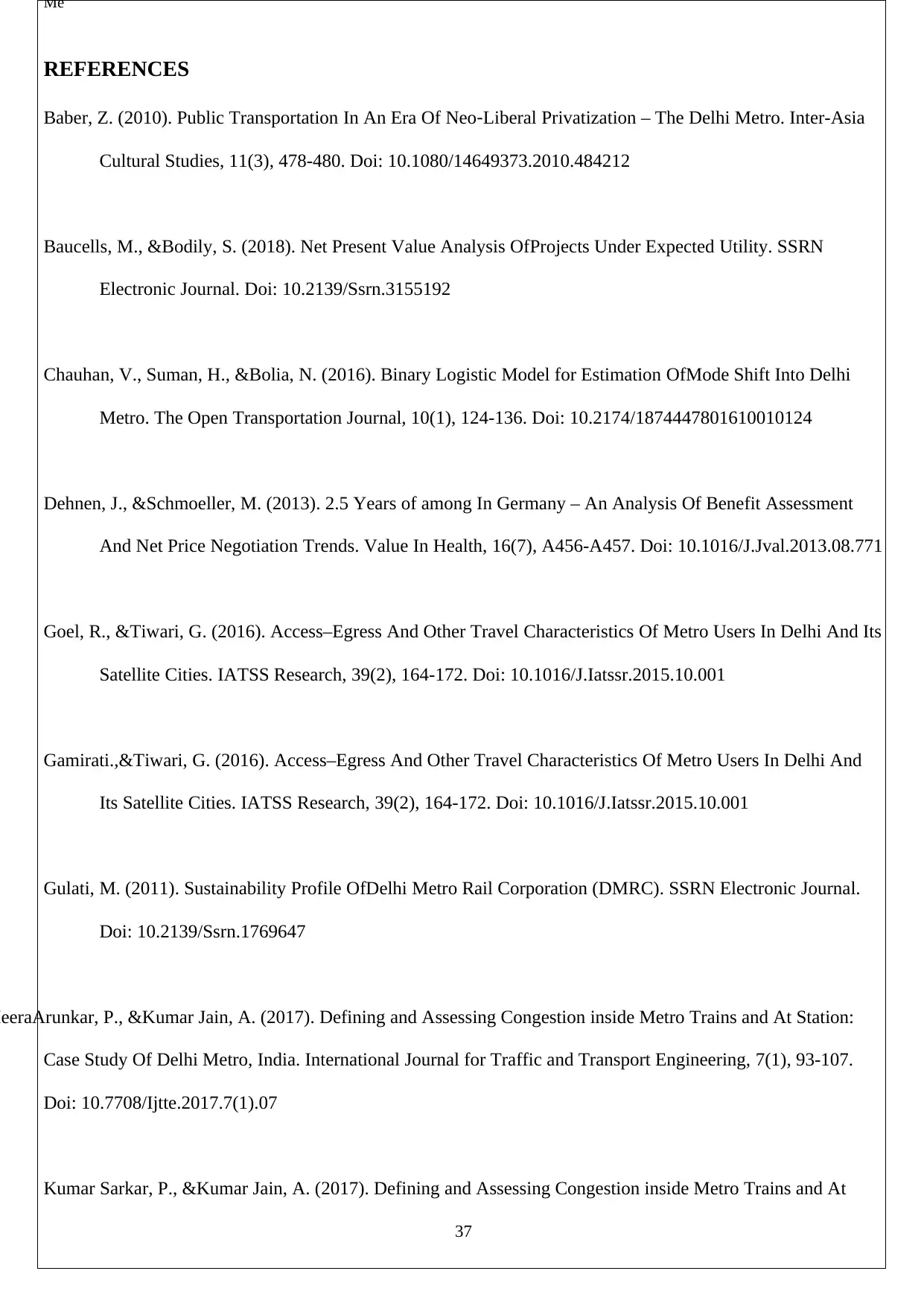
Me
REFERENCES
Baber, Z. (2010). Public Transportation In An Era Of Neo‐Liberal Privatization – The Delhi Metro. Inter-Asia
Cultural Studies, 11(3), 478-480. Doi: 10.1080/14649373.2010.484212
Baucells, M., &Bodily, S. (2018). Net Present Value Analysis OfProjects Under Expected Utility. SSRN
Electronic Journal. Doi: 10.2139/Ssrn.3155192
Chauhan, V., Suman, H., &Bolia, N. (2016). Binary Logistic Model for Estimation OfMode Shift Into Delhi
Metro. The Open Transportation Journal, 10(1), 124-136. Doi: 10.2174/1874447801610010124
Dehnen, J., &Schmoeller, M. (2013). 2.5 Years of among In Germany – An Analysis Of Benefit Assessment
And Net Price Negotiation Trends. Value In Health, 16(7), A456-A457. Doi: 10.1016/J.Jval.2013.08.771
Goel, R., &Tiwari, G. (2016). Access–Egress And Other Travel Characteristics Of Metro Users In Delhi And Its
Satellite Cities. IATSS Research, 39(2), 164-172. Doi: 10.1016/J.Iatssr.2015.10.001
Gamirati.,&Tiwari, G. (2016). Access–Egress And Other Travel Characteristics Of Metro Users In Delhi And
Its Satellite Cities. IATSS Research, 39(2), 164-172. Doi: 10.1016/J.Iatssr.2015.10.001
Gulati, M. (2011). Sustainability Profile OfDelhi Metro Rail Corporation (DMRC). SSRN Electronic Journal.
Doi: 10.2139/Ssrn.1769647
HeeraArunkar, P., &Kumar Jain, A. (2017). Defining and Assessing Congestion inside Metro Trains and At Station:
Case Study Of Delhi Metro, India. International Journal for Traffic and Transport Engineering, 7(1), 93-107.
Doi: 10.7708/Ijtte.2017.7(1).07
Kumar Sarkar, P., &Kumar Jain, A. (2017). Defining and Assessing Congestion inside Metro Trains and At
37
REFERENCES
Baber, Z. (2010). Public Transportation In An Era Of Neo‐Liberal Privatization – The Delhi Metro. Inter-Asia
Cultural Studies, 11(3), 478-480. Doi: 10.1080/14649373.2010.484212
Baucells, M., &Bodily, S. (2018). Net Present Value Analysis OfProjects Under Expected Utility. SSRN
Electronic Journal. Doi: 10.2139/Ssrn.3155192
Chauhan, V., Suman, H., &Bolia, N. (2016). Binary Logistic Model for Estimation OfMode Shift Into Delhi
Metro. The Open Transportation Journal, 10(1), 124-136. Doi: 10.2174/1874447801610010124
Dehnen, J., &Schmoeller, M. (2013). 2.5 Years of among In Germany – An Analysis Of Benefit Assessment
And Net Price Negotiation Trends. Value In Health, 16(7), A456-A457. Doi: 10.1016/J.Jval.2013.08.771
Goel, R., &Tiwari, G. (2016). Access–Egress And Other Travel Characteristics Of Metro Users In Delhi And Its
Satellite Cities. IATSS Research, 39(2), 164-172. Doi: 10.1016/J.Iatssr.2015.10.001
Gamirati.,&Tiwari, G. (2016). Access–Egress And Other Travel Characteristics Of Metro Users In Delhi And
Its Satellite Cities. IATSS Research, 39(2), 164-172. Doi: 10.1016/J.Iatssr.2015.10.001
Gulati, M. (2011). Sustainability Profile OfDelhi Metro Rail Corporation (DMRC). SSRN Electronic Journal.
Doi: 10.2139/Ssrn.1769647
HeeraArunkar, P., &Kumar Jain, A. (2017). Defining and Assessing Congestion inside Metro Trains and At Station:
Case Study Of Delhi Metro, India. International Journal for Traffic and Transport Engineering, 7(1), 93-107.
Doi: 10.7708/Ijtte.2017.7(1).07
Kumar Sarkar, P., &Kumar Jain, A. (2017). Defining and Assessing Congestion inside Metro Trains and At
37
Paraphrase This Document
Need a fresh take? Get an instant paraphrase of this document with our AI Paraphraser
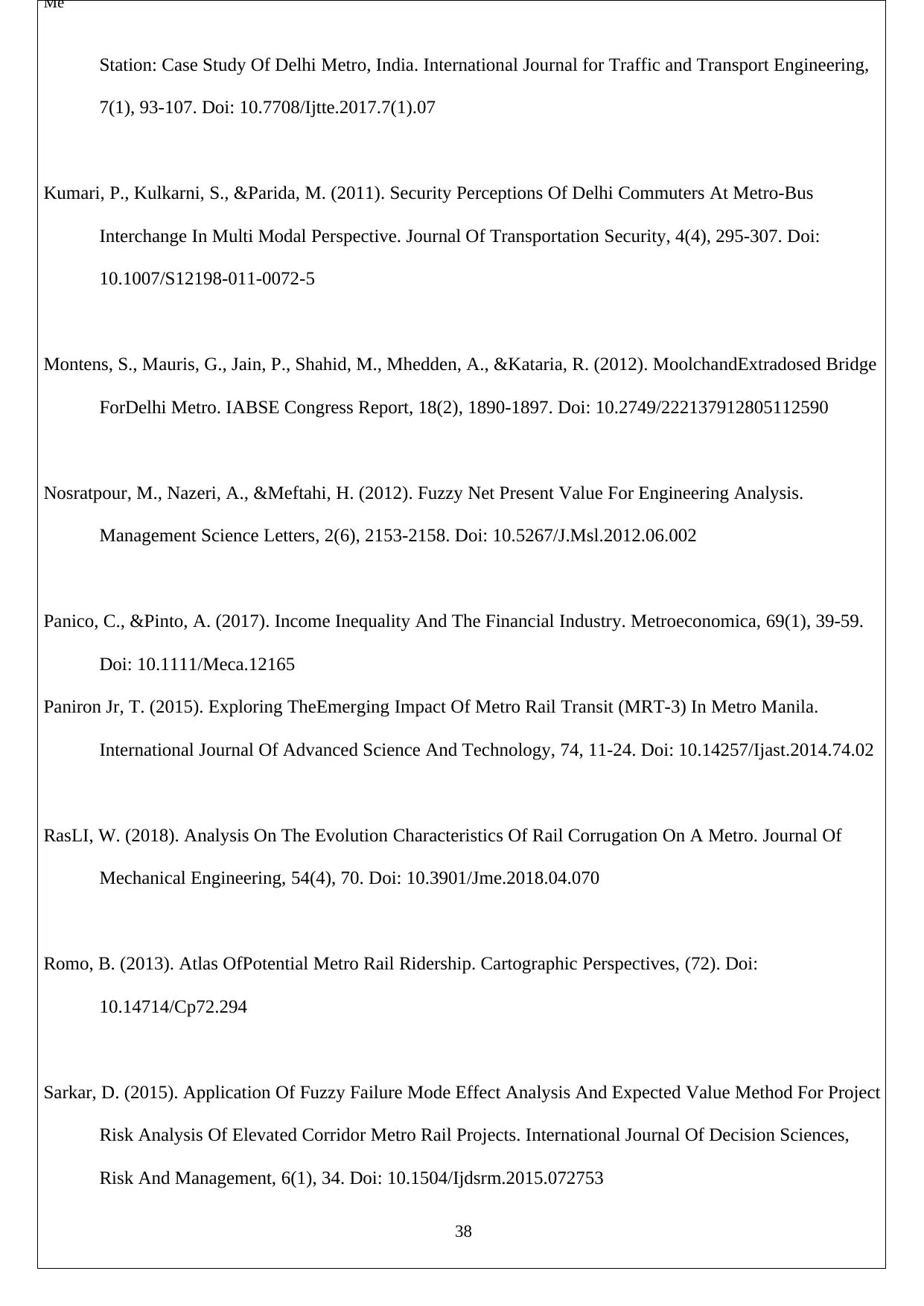
Me
Station: Case Study Of Delhi Metro, India. International Journal for Traffic and Transport Engineering,
7(1), 93-107. Doi: 10.7708/Ijtte.2017.7(1).07
Kumari, P., Kulkarni, S., &Parida, M. (2011). Security Perceptions Of Delhi Commuters At Metro-Bus
Interchange In Multi Modal Perspective. Journal Of Transportation Security, 4(4), 295-307. Doi:
10.1007/S12198-011-0072-5
Montens, S., Mauris, G., Jain, P., Shahid, M., Mhedden, A., &Kataria, R. (2012). MoolchandExtradosed Bridge
ForDelhi Metro. IABSE Congress Report, 18(2), 1890-1897. Doi: 10.2749/222137912805112590
Nosratpour, M., Nazeri, A., &Meftahi, H. (2012). Fuzzy Net Present Value For Engineering Analysis.
Management Science Letters, 2(6), 2153-2158. Doi: 10.5267/J.Msl.2012.06.002
Panico, C., &Pinto, A. (2017). Income Inequality And The Financial Industry. Metroeconomica, 69(1), 39-59.
Doi: 10.1111/Meca.12165
Paniron Jr, T. (2015). Exploring TheEmerging Impact Of Metro Rail Transit (MRT-3) In Metro Manila.
International Journal Of Advanced Science And Technology, 74, 11-24. Doi: 10.14257/Ijast.2014.74.02
RasLI, W. (2018). Analysis On The Evolution Characteristics Of Rail Corrugation On A Metro. Journal Of
Mechanical Engineering, 54(4), 70. Doi: 10.3901/Jme.2018.04.070
Romo, B. (2013). Atlas OfPotential Metro Rail Ridership. Cartographic Perspectives, (72). Doi:
10.14714/Cp72.294
Sarkar, D. (2015). Application Of Fuzzy Failure Mode Effect Analysis And Expected Value Method For Project
Risk Analysis Of Elevated Corridor Metro Rail Projects. International Journal Of Decision Sciences,
Risk And Management, 6(1), 34. Doi: 10.1504/Ijdsrm.2015.072753
38
Station: Case Study Of Delhi Metro, India. International Journal for Traffic and Transport Engineering,
7(1), 93-107. Doi: 10.7708/Ijtte.2017.7(1).07
Kumari, P., Kulkarni, S., &Parida, M. (2011). Security Perceptions Of Delhi Commuters At Metro-Bus
Interchange In Multi Modal Perspective. Journal Of Transportation Security, 4(4), 295-307. Doi:
10.1007/S12198-011-0072-5
Montens, S., Mauris, G., Jain, P., Shahid, M., Mhedden, A., &Kataria, R. (2012). MoolchandExtradosed Bridge
ForDelhi Metro. IABSE Congress Report, 18(2), 1890-1897. Doi: 10.2749/222137912805112590
Nosratpour, M., Nazeri, A., &Meftahi, H. (2012). Fuzzy Net Present Value For Engineering Analysis.
Management Science Letters, 2(6), 2153-2158. Doi: 10.5267/J.Msl.2012.06.002
Panico, C., &Pinto, A. (2017). Income Inequality And The Financial Industry. Metroeconomica, 69(1), 39-59.
Doi: 10.1111/Meca.12165
Paniron Jr, T. (2015). Exploring TheEmerging Impact Of Metro Rail Transit (MRT-3) In Metro Manila.
International Journal Of Advanced Science And Technology, 74, 11-24. Doi: 10.14257/Ijast.2014.74.02
RasLI, W. (2018). Analysis On The Evolution Characteristics Of Rail Corrugation On A Metro. Journal Of
Mechanical Engineering, 54(4), 70. Doi: 10.3901/Jme.2018.04.070
Romo, B. (2013). Atlas OfPotential Metro Rail Ridership. Cartographic Perspectives, (72). Doi:
10.14714/Cp72.294
Sarkar, D. (2015). Application Of Fuzzy Failure Mode Effect Analysis And Expected Value Method For Project
Risk Analysis Of Elevated Corridor Metro Rail Projects. International Journal Of Decision Sciences,
Risk And Management, 6(1), 34. Doi: 10.1504/Ijdsrm.2015.072753
38
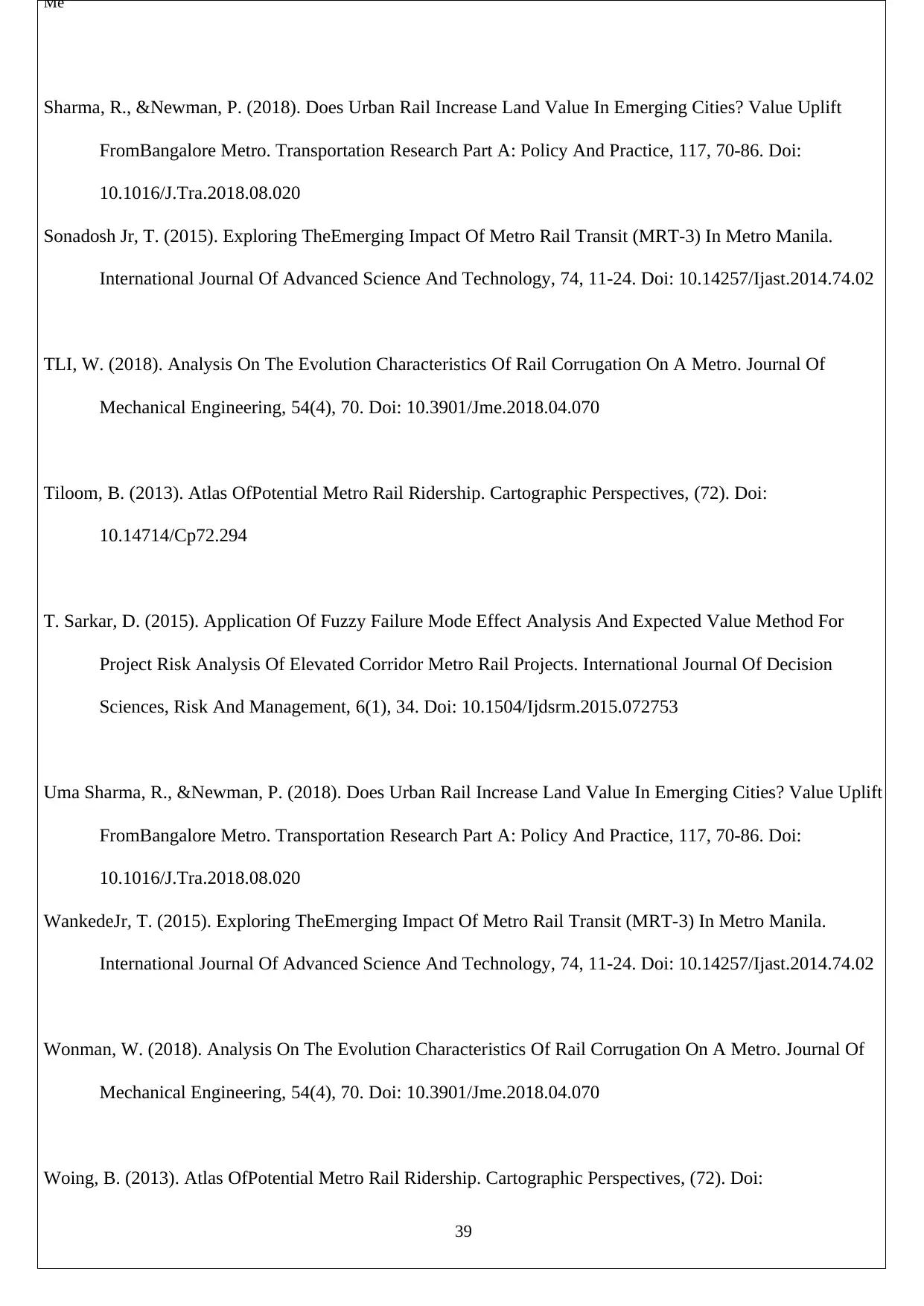
Me
Sharma, R., &Newman, P. (2018). Does Urban Rail Increase Land Value In Emerging Cities? Value Uplift
FromBangalore Metro. Transportation Research Part A: Policy And Practice, 117, 70-86. Doi:
10.1016/J.Tra.2018.08.020
Sonadosh Jr, T. (2015). Exploring TheEmerging Impact Of Metro Rail Transit (MRT-3) In Metro Manila.
International Journal Of Advanced Science And Technology, 74, 11-24. Doi: 10.14257/Ijast.2014.74.02
TLI, W. (2018). Analysis On The Evolution Characteristics Of Rail Corrugation On A Metro. Journal Of
Mechanical Engineering, 54(4), 70. Doi: 10.3901/Jme.2018.04.070
Tiloom, B. (2013). Atlas OfPotential Metro Rail Ridership. Cartographic Perspectives, (72). Doi:
10.14714/Cp72.294
T. Sarkar, D. (2015). Application Of Fuzzy Failure Mode Effect Analysis And Expected Value Method For
Project Risk Analysis Of Elevated Corridor Metro Rail Projects. International Journal Of Decision
Sciences, Risk And Management, 6(1), 34. Doi: 10.1504/Ijdsrm.2015.072753
Uma Sharma, R., &Newman, P. (2018). Does Urban Rail Increase Land Value In Emerging Cities? Value Uplift
FromBangalore Metro. Transportation Research Part A: Policy And Practice, 117, 70-86. Doi:
10.1016/J.Tra.2018.08.020
WankedeJr, T. (2015). Exploring TheEmerging Impact Of Metro Rail Transit (MRT-3) In Metro Manila.
International Journal Of Advanced Science And Technology, 74, 11-24. Doi: 10.14257/Ijast.2014.74.02
Wonman, W. (2018). Analysis On The Evolution Characteristics Of Rail Corrugation On A Metro. Journal Of
Mechanical Engineering, 54(4), 70. Doi: 10.3901/Jme.2018.04.070
Woing, B. (2013). Atlas OfPotential Metro Rail Ridership. Cartographic Perspectives, (72). Doi:
39
Sharma, R., &Newman, P. (2018). Does Urban Rail Increase Land Value In Emerging Cities? Value Uplift
FromBangalore Metro. Transportation Research Part A: Policy And Practice, 117, 70-86. Doi:
10.1016/J.Tra.2018.08.020
Sonadosh Jr, T. (2015). Exploring TheEmerging Impact Of Metro Rail Transit (MRT-3) In Metro Manila.
International Journal Of Advanced Science And Technology, 74, 11-24. Doi: 10.14257/Ijast.2014.74.02
TLI, W. (2018). Analysis On The Evolution Characteristics Of Rail Corrugation On A Metro. Journal Of
Mechanical Engineering, 54(4), 70. Doi: 10.3901/Jme.2018.04.070
Tiloom, B. (2013). Atlas OfPotential Metro Rail Ridership. Cartographic Perspectives, (72). Doi:
10.14714/Cp72.294
T. Sarkar, D. (2015). Application Of Fuzzy Failure Mode Effect Analysis And Expected Value Method For
Project Risk Analysis Of Elevated Corridor Metro Rail Projects. International Journal Of Decision
Sciences, Risk And Management, 6(1), 34. Doi: 10.1504/Ijdsrm.2015.072753
Uma Sharma, R., &Newman, P. (2018). Does Urban Rail Increase Land Value In Emerging Cities? Value Uplift
FromBangalore Metro. Transportation Research Part A: Policy And Practice, 117, 70-86. Doi:
10.1016/J.Tra.2018.08.020
WankedeJr, T. (2015). Exploring TheEmerging Impact Of Metro Rail Transit (MRT-3) In Metro Manila.
International Journal Of Advanced Science And Technology, 74, 11-24. Doi: 10.14257/Ijast.2014.74.02
Wonman, W. (2018). Analysis On The Evolution Characteristics Of Rail Corrugation On A Metro. Journal Of
Mechanical Engineering, 54(4), 70. Doi: 10.3901/Jme.2018.04.070
Woing, B. (2013). Atlas OfPotential Metro Rail Ridership. Cartographic Perspectives, (72). Doi:
39

Me
10.14714/Cp72.294
Xanig, D. (2015). Application Of Fuzzy Failure Mode Effect Analysis And Expected Value Method For Project
Risk Analysis Of Elevated Corridor Metro Rail Projects. International Journal Of Decision Sciences,
Risk And Management, 6(1), 34. Doi: 10.1504/Ijdsrm.2015.072753
Xing, R., &Newman, P. (2018). Does Urban Rail Increase Land Value In Emerging Cities? Value Uplift
FromBangalore Metro. Transportation Research Part A: Policy And Practice, 117, 70-86. Doi:
10.1016/J.Tra.2018.08.020
Xing Li, N., Singh, A., Dhyani, R., &Gaur, S. (2014). Emission Reduction FromMRTS Projects – A Case Study
Of Delhi Metro. Atmospheric Pollution Research, 5(4), 721-728. Doi: 10.5094/Apr.2014.081
Xo ,P., Kulkarni, S., &Parida, M. (2011). Security Perceptions Of Delhi Commuters At Metro-Bus Interchange In Multi
Modal Perspective. Journal Of Transportation Security, 4(4), 295-307. Doi: 10.1007/S12198-011-0072-5
XonMontens, S., Mauris, G., Jain, P., Shahid, M., Mhedden, A., &Kataria, R. (2012). MoolchandExtradosed
Bridge ForDelhi Metro. IABSE Congress Report, 18(2), 1890-1897. Doi:
10.2749/222137912805112590
Xosratpour, M., Nazeri, A., &Meftahi, H. (2012). Fuzzy Net Present Value For Engineering Analysis.
Management Science Letters, 2(6), 2153-2158. Doi: 10.5267/J.Msl.2012.06.002
Xanico, C., &Pinto, A. (2017). Income Inequality And The Financial Industry. Metroeconomica, 69(1), 39-59.
Doi: 10.1111/Meca.12165
Yin Jr, T. (2015). Exploring TheEmerging Impact Of Metro Rail Transit (MRT-3) In Metro Manila.
International Journal Of Advanced Science And Technology, 74, 11-24. Doi: 10.14257/Ijast.2014.74.02
Yangio, W. (2018). Analysis On The Evolution Characteristics Of Rail Corrugation On A Metro. Journal Of
40
10.14714/Cp72.294
Xanig, D. (2015). Application Of Fuzzy Failure Mode Effect Analysis And Expected Value Method For Project
Risk Analysis Of Elevated Corridor Metro Rail Projects. International Journal Of Decision Sciences,
Risk And Management, 6(1), 34. Doi: 10.1504/Ijdsrm.2015.072753
Xing, R., &Newman, P. (2018). Does Urban Rail Increase Land Value In Emerging Cities? Value Uplift
FromBangalore Metro. Transportation Research Part A: Policy And Practice, 117, 70-86. Doi:
10.1016/J.Tra.2018.08.020
Xing Li, N., Singh, A., Dhyani, R., &Gaur, S. (2014). Emission Reduction FromMRTS Projects – A Case Study
Of Delhi Metro. Atmospheric Pollution Research, 5(4), 721-728. Doi: 10.5094/Apr.2014.081
Xo ,P., Kulkarni, S., &Parida, M. (2011). Security Perceptions Of Delhi Commuters At Metro-Bus Interchange In Multi
Modal Perspective. Journal Of Transportation Security, 4(4), 295-307. Doi: 10.1007/S12198-011-0072-5
XonMontens, S., Mauris, G., Jain, P., Shahid, M., Mhedden, A., &Kataria, R. (2012). MoolchandExtradosed
Bridge ForDelhi Metro. IABSE Congress Report, 18(2), 1890-1897. Doi:
10.2749/222137912805112590
Xosratpour, M., Nazeri, A., &Meftahi, H. (2012). Fuzzy Net Present Value For Engineering Analysis.
Management Science Letters, 2(6), 2153-2158. Doi: 10.5267/J.Msl.2012.06.002
Xanico, C., &Pinto, A. (2017). Income Inequality And The Financial Industry. Metroeconomica, 69(1), 39-59.
Doi: 10.1111/Meca.12165
Yin Jr, T. (2015). Exploring TheEmerging Impact Of Metro Rail Transit (MRT-3) In Metro Manila.
International Journal Of Advanced Science And Technology, 74, 11-24. Doi: 10.14257/Ijast.2014.74.02
Yangio, W. (2018). Analysis On The Evolution Characteristics Of Rail Corrugation On A Metro. Journal Of
40
Secure Best Marks with AI Grader
Need help grading? Try our AI Grader for instant feedback on your assignments.
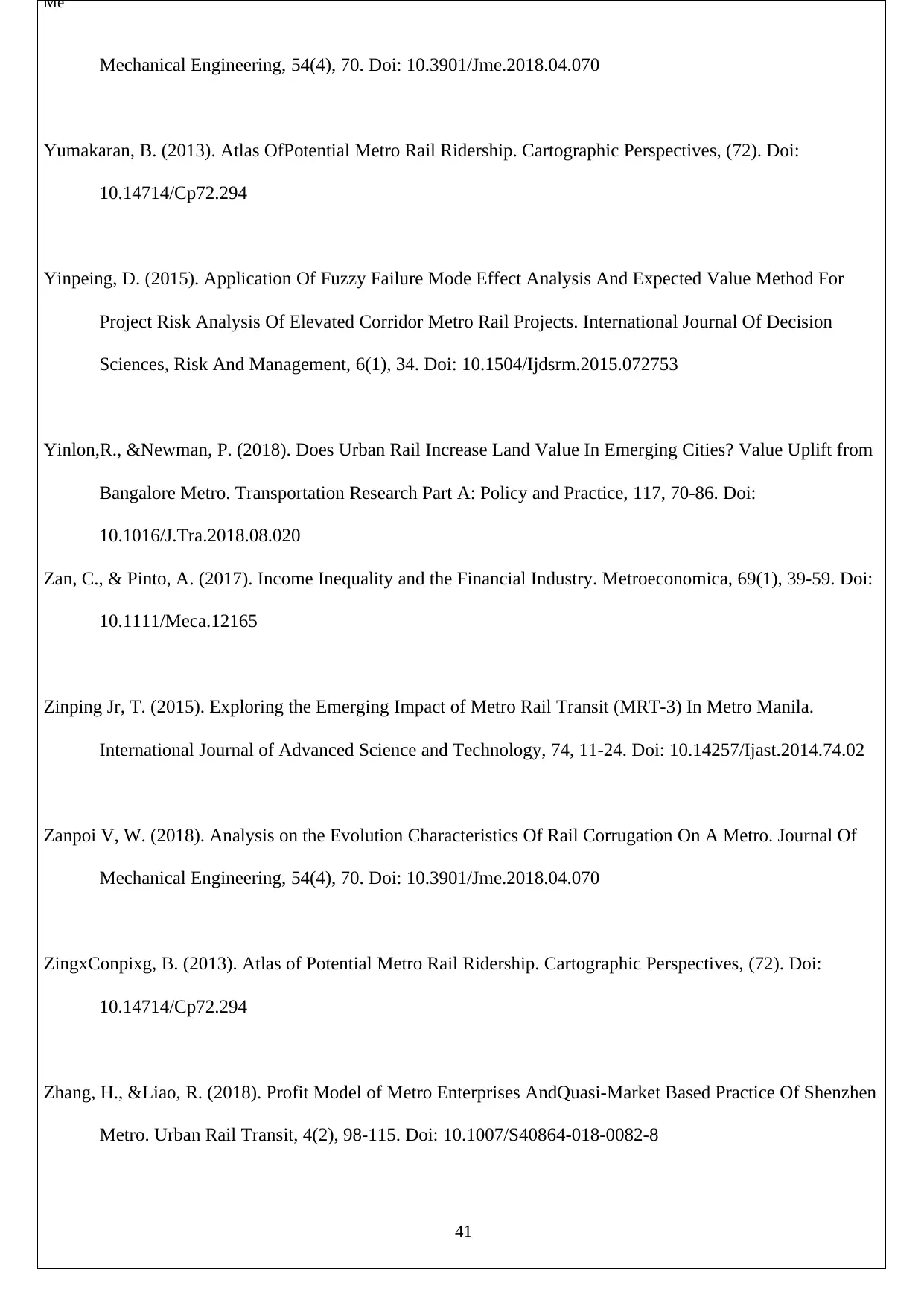
Me
Mechanical Engineering, 54(4), 70. Doi: 10.3901/Jme.2018.04.070
Yumakaran, B. (2013). Atlas OfPotential Metro Rail Ridership. Cartographic Perspectives, (72). Doi:
10.14714/Cp72.294
Yinpeing, D. (2015). Application Of Fuzzy Failure Mode Effect Analysis And Expected Value Method For
Project Risk Analysis Of Elevated Corridor Metro Rail Projects. International Journal Of Decision
Sciences, Risk And Management, 6(1), 34. Doi: 10.1504/Ijdsrm.2015.072753
Yinlon,R., &Newman, P. (2018). Does Urban Rail Increase Land Value In Emerging Cities? Value Uplift from
Bangalore Metro. Transportation Research Part A: Policy and Practice, 117, 70-86. Doi:
10.1016/J.Tra.2018.08.020
Zan, C., & Pinto, A. (2017). Income Inequality and the Financial Industry. Metroeconomica, 69(1), 39-59. Doi:
10.1111/Meca.12165
Zinping Jr, T. (2015). Exploring the Emerging Impact of Metro Rail Transit (MRT-3) In Metro Manila.
International Journal of Advanced Science and Technology, 74, 11-24. Doi: 10.14257/Ijast.2014.74.02
Zanpoi V, W. (2018). Analysis on the Evolution Characteristics Of Rail Corrugation On A Metro. Journal Of
Mechanical Engineering, 54(4), 70. Doi: 10.3901/Jme.2018.04.070
ZingxConpixg, B. (2013). Atlas of Potential Metro Rail Ridership. Cartographic Perspectives, (72). Doi:
10.14714/Cp72.294
Zhang, H., &Liao, R. (2018). Profit Model of Metro Enterprises AndQuasi-Market Based Practice Of Shenzhen
Metro. Urban Rail Transit, 4(2), 98-115. Doi: 10.1007/S40864-018-0082-8
41
Mechanical Engineering, 54(4), 70. Doi: 10.3901/Jme.2018.04.070
Yumakaran, B. (2013). Atlas OfPotential Metro Rail Ridership. Cartographic Perspectives, (72). Doi:
10.14714/Cp72.294
Yinpeing, D. (2015). Application Of Fuzzy Failure Mode Effect Analysis And Expected Value Method For
Project Risk Analysis Of Elevated Corridor Metro Rail Projects. International Journal Of Decision
Sciences, Risk And Management, 6(1), 34. Doi: 10.1504/Ijdsrm.2015.072753
Yinlon,R., &Newman, P. (2018). Does Urban Rail Increase Land Value In Emerging Cities? Value Uplift from
Bangalore Metro. Transportation Research Part A: Policy and Practice, 117, 70-86. Doi:
10.1016/J.Tra.2018.08.020
Zan, C., & Pinto, A. (2017). Income Inequality and the Financial Industry. Metroeconomica, 69(1), 39-59. Doi:
10.1111/Meca.12165
Zinping Jr, T. (2015). Exploring the Emerging Impact of Metro Rail Transit (MRT-3) In Metro Manila.
International Journal of Advanced Science and Technology, 74, 11-24. Doi: 10.14257/Ijast.2014.74.02
Zanpoi V, W. (2018). Analysis on the Evolution Characteristics Of Rail Corrugation On A Metro. Journal Of
Mechanical Engineering, 54(4), 70. Doi: 10.3901/Jme.2018.04.070
ZingxConpixg, B. (2013). Atlas of Potential Metro Rail Ridership. Cartographic Perspectives, (72). Doi:
10.14714/Cp72.294
Zhang, H., &Liao, R. (2018). Profit Model of Metro Enterprises AndQuasi-Market Based Practice Of Shenzhen
Metro. Urban Rail Transit, 4(2), 98-115. Doi: 10.1007/S40864-018-0082-8
41

Me
42
42
1 out of 42
Related Documents
Your All-in-One AI-Powered Toolkit for Academic Success.
+13062052269
info@desklib.com
Available 24*7 on WhatsApp / Email
![[object Object]](/_next/static/media/star-bottom.7253800d.svg)
Unlock your academic potential
© 2024 | Zucol Services PVT LTD | All rights reserved.
